#so despite having had an interest in historical fashion for several years now
Explore tagged Tumblr posts
Text
So like at what point should I just give up
#so despite having had an interest in historical fashion for several years now#and despite now a full year's worth of doing research#and despite being the person writing all the research down and sending it around to people#despite creating all the (infra)structure for this entire project#despite being the person literally writing the books right now#the moment something's unknown people look at my friend and tell her to research it and write the book#she's the one who's on tv#she's the one who gets talked to about clothes#she's the one seen as the authority on it#like even while sorting through traditional headwear today#i was the one who pointed out the entire categories she missed#and started sorting those#i was the one who wrote and sent the part of the manual about them#and people still looked at my friend to tell her to write the book#like#i know she wears the long skirts everyday and i'm there in hoodies and sneakers#but even the people that work with us every week will still look at her first#it's extra frustrating because her idea of doing research consists of only getting resources that 'look relevant'#then cherry picking information and immediately drawing conclusions from that#and the moment she has a conclusion that's it. fact formed. no more changing her mind#the amount of arguments i've had where i pointed out information and she refused to listen is insane#but then what i say just gets dismissed because i'm the one interpreting it wrong#and other people join her because she says it very confidently#and then i keep bringing up sources and it doesn't help and just. i'm so tired.#feel like i should add that yes she wears big oldfashioney skirts everydsy#but she says they're traditional folkwear#bitch no they're mainstream edwardian#traditional skirts have a very different silhouette and style
1 note
·
View note
Text
Lilia Fact Sheet
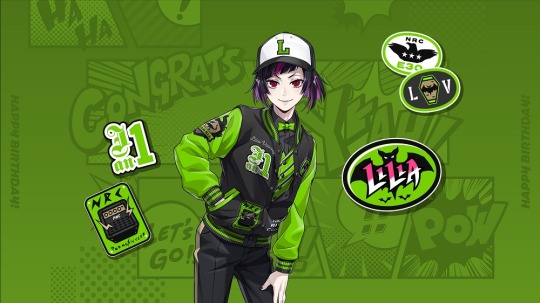
(Voted 8th-most-popular-character (tied with Jamil) on the jpn server in a combination of seven different character-ranking surveys held throughout 2021)
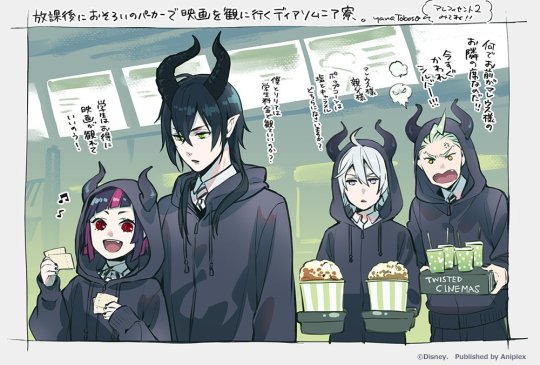
Art by Toboso Yana: "Diasomnia Dorm goes to see a movie after school." Lilia: "It's great that students get to see movies at a discount!" - Malleus: "Is it really all right for you and I to be paying the student price?" Silver: "Malleus-sama, Father, do you prefer salted popcorn or caramel popcorn?" Sebek: "Why do you get the seat next to Malleus-sama!! Swap with me immediately, Silver!!!"
Lilia does not actually remember his own birthdate, putting down January 1st when he applied to enroll at Night Raven College, but the date does not seem to have any particular significance to him.
Lilia looks like a young boy but speaks in a somewhat old-fashioned way, using the pronoun “washi”. His actual age is unknown and he refuses to reveal it, even to his own adopted son, Silver.
In history class Malleus says he sees a picture of Lilia in their Magical History textbooks, Lilia has said himself that he has “witnessed the past 500 years of history firsthand”, and remembers most of it. In conversation he will reference ancient historical events as if they were incidents he saw for himself only recently.

It is probably safe to assume that he is several years older than Malleus, as he references having met him when “he (Malleus) still had eggshell on his head”, and how child-Malleus used to cry when he couldn’t figure out how to dress himself.
Lilia appears in several vignettes for other characters, and seems both sociable and to enjoy lending a hand in his own way.
Like Malleus he does not require a broom to levitate, and will often insert himself into conversations by suddenly appearing upside down in front of people. He boasts that he has healthy skin and top grades despite his habit of staying up all night playing video games.
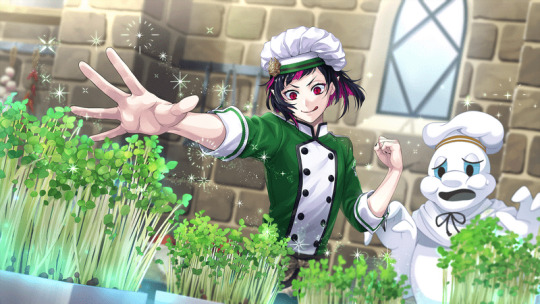
Lilia is, infamously, a terrible cook. Malleus has said he never wants to eat anything Lilia cooks ever again in life, and Silver’s disliked food consists only of anything made by Lilia. Silver tells us that Lilia refuses to follow the order in which recipes are written, ignores the recommended quantity of ingredients and introduces entirely new ingredients that were never a part of the original recipe.
We learn that the reason for this is that Lilia only formed an interest in cooking once he had a family to look after. He was determined to focus upon nutritional meals for them, and when a recipe did not have enough healthy ingredients for his liking, he would introduce new ingredients so as to increase the meal’s nutritiousness. As a result, he now ignores the instructions of recipes that do not sound healthy enough.
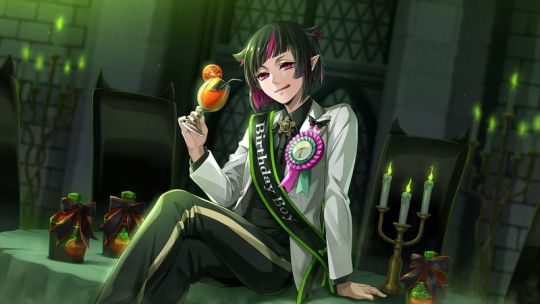
According to Sebek, Lilia either does not care about unpleasant tasting food or does not notice it, as he can consume foul-tasting potions with enjoyment and once ate an entire pot-au-feu dish that a young Silver had attempted to cook and accidentally burnt, without complaint.
Lilia’s poor cooking ability seems to be gaining notoriety throughout the school because of how he enjoys attempting to share his home cooked meals with others, and how he passes on his unfortunate cooking tips and tricks to his fellow students. In one of Jamil’s vignettes, Jamil firmly refuses Lilia’s offer of assistance with readying a meal for Kalim, reflecting on a rumor he heard that Lilia is not to be trusted with food preparation.
Lilia receives a book of recipes from Trey on his birthday and comments that “the ingredients listed here will never be enough—I will work something out”. We learn that he participates in the school’s “Master Chef” curriculum every year, and always fails the course.

While we know from Book 5 that Lilia is wholly capable of singing normally when he chooses to, he does not always do so. His personal preference is for heavy music and screaming, and he will shout even when singing lullabies.
During a recruitment event for the Pop Music Club, Lilia attempted to stage dive into a crowd of gathered first years, and fell to the floor when no one caught him. The recruitment event resulted in a single new member for the club: Kalim.
Lilia enjoys music because it brings people together, regardless of age or place of birth.

Lilia seems to be acting as a chaperone for Malleus at the school, always watching over his interactions with other students with pleasure.
Rook calls him “Monsieur Curiosité”, while Floyd refers to him as Mendako-chan (eng: flapjack octopus)
He enjoys black licorice immensely, and his dislike of marshmallows seems to come from the fact that he simply finds them unsatisfying.
Lilia does not enjoy being in the sun, preferring cloudy weather, and wears a sun visor during his PE classes. He is often joined during battles and his flying lessons by clouds of bats, while a single bat will often fly down from the rafters of the lecture hall to visit with him during magical history lessons, his favorite subject.
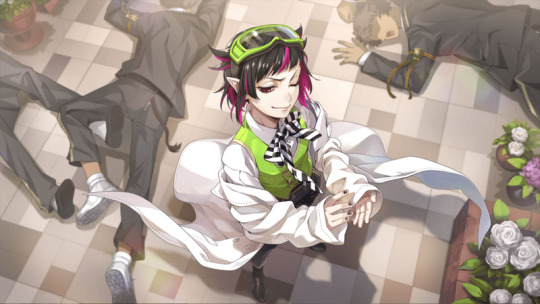
Lilia wears an oversized lab coat during alchemy lessons intentionally, in order to promote his “cute” appeal, of which he is very much aware and seems to be going out of his way to emphasize. He says that, while the sleeves get in his way, he puts up with it because of how cute they make him look. His school uniform jacket is also overly large, and is the same size as the one worn by Malleus.
In vignettes we have learned that Lilia is a former king’s guard for the Lord of Briar Valley, was highly trusted by the Queen at the time and earned medals of bravery for his courage in battle. Though he has since retired from the front lines, he is still a very formidable opponent both physically and magically, defeating multiple third-year students who had been bullying Epel in his lab wear vignette and holding his own against Malleus in Beansfest (until the latter ran out of beans, resulting in Lilia’s victory).
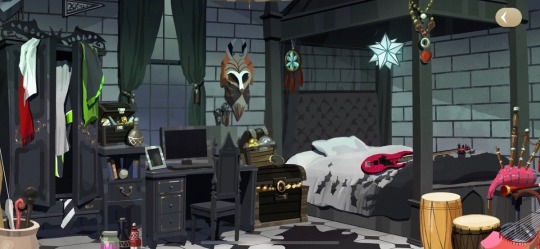
Contrary to his violent past, Lilia’s wish in the Wish Upon a Star event is for peace between the different races of Twisted Wonderland, and we learn that he has taught Silver that war should never be an option.
Lilia became interested in traveling alone only recently, after things became “peaceful”, and he is extremely well-traveled. He enjoys solo-trips to foreign countries and often brings back souvenirs for both himself and others. Lilia as said that he particularly enjoys interacting with people from other countries.

He was initially a very strict educator while raising Silver and Sebek, but after seeing them struggle with their training, he realized that it was wrong to raise children in the same way he had treated his subordinates on the front lines. He has been raising them in a laissez-faire manner ever since. (Sebek has parents and siblings of his own, but it seems that Lilia has been overseeing Sebek’s tutelage alongside Silver from when they were both very young.)
Silver has shared that he is in extremely good physical shape, often doing situps while hanging upside down from the canopy of his bed. This scene has been animated by a fan at the link below.
Lilia’s hair is naturally black. He dyes the under part different colors depending on his mood.
At NRC Lilia enjoys online games and magi-cam, the twst-equivalent of instagram. He is an accomplished gamer, and has expressed that he enjoys multi-player games as people from all over the world are able to gather to enjoy themselves together without the boundaries of physical borders.
Lilia seems to be familiar with Sam’s family, saying that he was acquainted with Sam’s great-great-great-grandfather.
Some great artists for Lilia fan-art and more (SFW, no story spoilers)
・Great (but lowkey depressing) Diasomnia Family Comic
・More Diasomnia Family
And by the same artist
・King’s Guard Lilia on a unicorn
・Variety of Characters, mostly of Lilia

Voice Lilia is voiced by Midorikawa Hikaru (緑川 光), one of the most accomplished voice actors of his generation. His performance as Heero Yuy in New Mobile Suit Gundam W was what inspired Silver’s seiyuu to pursue voice acting. He has also had leading roles in SLAM DUNK, Fushigi Yugi, GTO, DIABOLIK LOVERS, Persona 3, Fate/Zero, Granblue Fantasy and more, having been active in the voice acting industry since 1988.
More information available here
Additional Fact Sheets ・Riddle Rosehearts ・Trey Clover・Cater Diamond ・Ace Trappola・Deuce Spade ・Leona Kingscholar ・Ruggie Bucchi ・Jack Howl ・Azul Ashengrotto・Floyd Leech・Jade Leech ・Kalim Al-Asim・Jamil Viper ・Vil Schoenheit・Rook Hunt ・Epel Felmier ・Idia Shroud・Ortho Shroud ・Malleus Draconia ・Silver・Sebek Zigvolt・Lilia Vanrouge ・Sam・Crewel・Trein・Vargas・Crowley
497 notes
·
View notes
Note
Hi. You made a post a couple of days ago about how queer historical fiction doesnt need to be defined only by homophobia. Can you expand on that a bit maybe? Because it seems interesting and important, but I'm a little confused as to whether that is responsible to the past and showing how things have changed over time. Anyway this probably isn't very clear, but I hope its not insulting. Have a good day :)
Hiya. I assume you're referring to this post, yes? I think the main parameters of my argument were set out pretty clearly there, but sure, I'm happy to expand on it. Because I'm a little curious as to why you think that writing a queer narrative (especially a queer fictional narrative) that doesn't make much reference to or even incorporate explicit homophobia is (implicitly) not being "responsible to the past." I've certainly made several posts on this topic before, but as ever, my thoughts and research materials change over time. So, okay.
(Note: I am a professional historian with a PhD, a book contract for an academic monograph on medieval/early modern queer history, and soon-to-be-several peer-reviewed publications on medieval queer history. In other words, I'm not just talking out of my ass here.)
As I noted in that post, first of all, the growing emphasis on "accuracy" in historical fiction and historically based media is... a mixed bag. Not least because it only seems to be applied in the Game of Thrones fashion, where the only "accurate" history is that which is misogynistic, bloody, filthy, rampantly intolerant of competing beliefs, and has no room for women, people of color, sexual minorities, or anyone else who has become subject to hot-button social discourse today. (I wrote a critical post awhile ago about the Netflix show Cursed, ripping into it for even trying to pretend that a show based on the Arthurian legends was "historically accurate" and for doing so in the most simplistic and reductive way possible.) This says far more about our own ideas of the past, rather than what it was actually like, but oh boy will you get pushback if you try to question that basic premise. As other people have noted, you can mix up the archaeological/social/linguistic/cultural/material stuff all you like, but the instant you challenge the ingrained social ideas about The Bad Medieval Era, cue the screaming.
I've been a longtime ASOIAF fan, but I do genuinely deplore the effect that it (and the show, which was by far the worst offender) has had on popular culture and widespread perceptions of medieval history. When it comes to queer history specifically, we actually do not know that much, either positive or negative, about how ordinary medieval people regarded these individuals, proto-communities, and practices. Where we do have evidence that isn't just clerical moralists fulminating against sodomy (and trying to extrapolate a society-wide attitude toward homosexuality from those sources is exactly like reading extreme right-wing anti-gay preachers today and basing your conclusions about queer life in 2021 only on those), it is genuinely mixed and contradictory. See this discussion post I likewise wrote a while ago. Queerness, queer behavior, queer-behaving individuals have always existed in history, and labeling them "queer" is only an analytical conceit that represents their strangeness to us here in the 21st century, when these categories of exclusion and difference have been stringently constructed and applied, in a way that is very far from what supposedly "always" existed in the past.
Basically, we need to get rid of the idea that there was only one empirical and factual past, and that historians are "rewriting" or "changing" or "misrepresenting" it when they produce narratives that challenge hegemonic perspectives. This is why producing good historical analysis is a skill that takes genuine training (and why it's so undervalued in a late-capitalist society that would prefer you did anything but reflect on the past). As I also said in the post to which you refer, "homophobia" as a structural conceit can't exist prior to its invention as an analytical term, if we're treating queerness as some kind of modern aberration that can't be reliably talked about until "homosexual" gained currency in the late 19th century. If there's no pre-19th century "homosexuality," then ipso facto, there can be no pre-19th-century "homophobia" either. Which one is it? Spoiler alert: there are still both things, because people are people, but just as the behavior itself is complicated in the premodern past, so too is the reaction to it, and it is certainly not automatic rejection at all times.
Hence when it comes to fiction, queer authors have no responsibility (and in my case, certainly no desire) to uncritically replicate (demonstrably false!) narratives insisting that we were always miserable, oppressed, ostracised, murdered, or simply forgotten about in the premodern world. Queer characters, especially historical queer characters, do not have to constantly function as a political mouthpiece for us to claim that things are so much better today (true in some cases, not at all in the others) and that modernity "automatically" evolved to a more "enlightened" stance (definitely not true). As we have seen with the recent resurgence of fascism, authoritarianism, nationalism, and xenophobia around the world, along with the desperate battle by the right wing to re-litigate abortion, gay rights, etc., social attitudes do not form in a vacuum and do not just automatically become more progressive. They move backward, forward, and side to side, depending on the needs of the societies that produce them, and periods of instability, violence, sickness, and poverty lead to more regressive and hardline attitudes, as people act out of fear and insularity. It is a bad human habit that we have not been able to break over thousands of years, but "[social] things in the past were Bad but now have become Good" just... isn't true.
After all, nobody feels the need to constantly add subtextual disclaimers or "don't worry, I personally don't support this attitude/action" implied authorial notes in modern romances, despite the cornucopia of social problems we have today, and despite the complicated attitude of the modern world toward LGBTQ people. If an author's only reason for including "period typical homophobia" (and as we've discussed, there's no such thing before the 19th century) is that they think it should be there, that is an attitude that needs to be challenged and examined more closely. We are not obliged to only produce works that represent a downtrodden past, even if the end message is triumphal. It's the same way we got so tired of rape scenes being used to make a female character "stronger." Just because those things existed (and do exist!), doesn't mean you have to submit every single character to those humiliations in some twisted name of accuracy.
Yes, as I have always said, prejudices have existed throughout history, sometimes violently so. But that is not the whole story, and writing things that center only on the imagined or perceived oppression is not, at this point, accurate OR helpful. Once again, I note that this is specifically talking about fiction. If real-life queer people are writing about their own experiences, which are oftentimes complex, that's not a question of "representation," it's a question of factual memoir and personal history. You can't attack someone for being "problematic" when they are writing about their own lived experience, which is something a younger generation of queer people doesn't really seem to get. They also often don't realise how drastically things have changed even in my own lifetime, per the tags on my reblog about Brokeback Mountain, and especially in media/TV.
However, if you are writing fiction about queer people, especially pre-20th century queer people, and you feel like you have to make them miserable just to be "responsible to the past," I would kindly suggest that is not actually true at all, and feeds into a dangerous narrative that suggests everything "back then" was bad and now it's fine. There are more stories to tell than just suffering, queer characters do not have to exist solely as a corollary for (inaccurate) political/social commentary on the premodern past, and they can and should be depicted as living their lives relatively how they wanted to, despite the expected difficulties and roadblocks. That is just as accurate, if sometimes not more so, than "they suffered, the end," and it's something that we all need to be more willing to embrace.
125 notes
·
View notes
Text
Tangled Salt Marathon - Day of the Animals
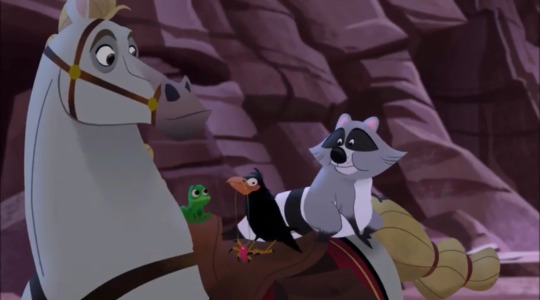
While perhaps not my favorite episode this season, Day of the Animals is easily the best written story of season three. Even so, it still has problems due to the third season’s poor approach to characterization.
Summary: Rapunzel, Varian, Angry and Red are returning stolen loot that the two girls had stolen years ago. They are accompanied by Max, Pascal, Ruddiger and Hamuel who all cannot stop quarreling with each other (or in Hamuel's case, just being useless). While messing with a sea shell pendant, it magically transports the humans into it, leaving the animals to fight over it. A minor thug named Dwayne, steals the pendant forcing the animals to work together to retrieve it.
So Why is a Polynesian Inspired Kingdom Within Riding Distance of a Northern European Country?
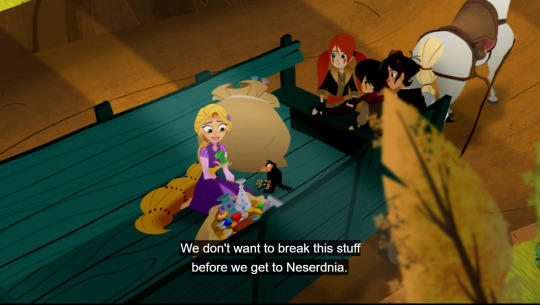
If you’ll remember my review of Beginnings, Neserdina’s princesses were wearing Polynesian garb and dancing the Hula when prepping for the competition. Now I’ve already went into length as to why that’s not good representation, but in addition to that it’s also just plain dumb. You can’t just transport one ethic group and dump them into another part of the world because it’s convenient for you. You don’t earn any brownie points for doing that. Especially when your fantasy world is still based off of our own historical earth.
To make things even more confusing, we actually saw Neserdina way back in season one in Way of the Willow. It’s where Willow bought the gremlin knock-off.

That is an island. How the heck do you get to a volcanic island riding in a horse and cart? And don't tell me they’re riding to a port, because Corona is a port city already. They could have gotten there by boat. It’s also can’t be too far away from Corona’s borders if Angry and Red were able to get there on foot during their year long travels.
The only explanation is that the entirety of the Tangled crew doesn’t understand geography, and this won’t be the last example in the show to back up that statement.
So Why Is Rapunzel Here?
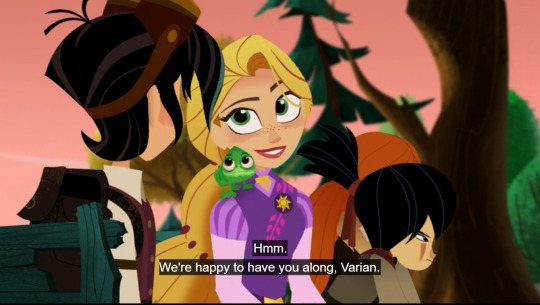
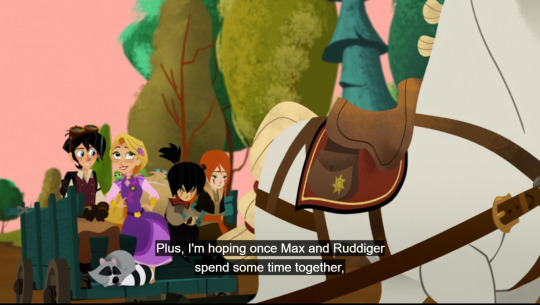
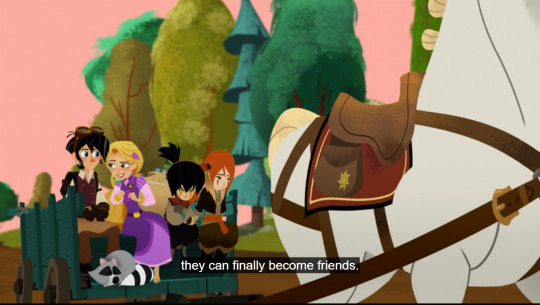
We get explanations for why everyone is on this road trip, except for the main character herself. Red and Angry are trying to return some stolen loot. Varian is wanting to pick up rare alchemy supplies at the market and was invited along because Raps hopes it’ll be a chance for Ruddiger and Max to get know one another better.
But why on earth does Rapunzel feel the need to come on this trip herself? Doesn’t she have a kingdom to run? While I’m sure Eugene is more than capable of handling things, this doesn’t reflect well upon the writers supposed plan of making Rapunzel appear more responsible.
Literally any other adult could have come along on this trip. This wasn’t something Rapunzel needed to waste time on. Lance especially would have been more appropriate here as he’s the one who’s suppose to eventually adopt Angry and Red. And the sad thing is, all they had to do was give Rapunzel a line about needing to attend some sort of diplomatic business in Neserdina. That’s it.
In a show that’s supposed to be all about Rapunzel; Rapunzel sure doesn’t have a whole lot of reasons to exist in the majority of the episodes.
Lack of Worldbuilding Strikes Again
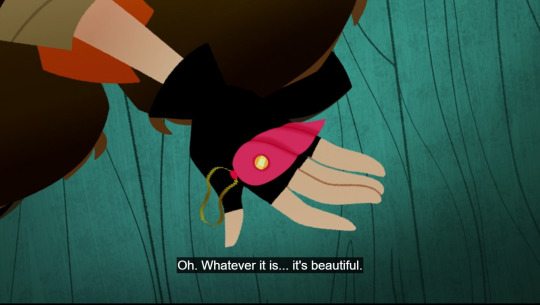

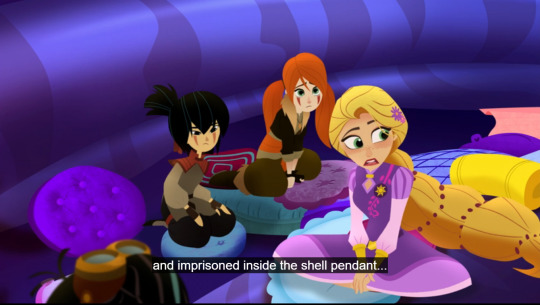
At this point I’m kind of numb to the whole “magical thing just exists for no adequately explained reason” and so I’m not as upset as some people are about the shell necklace. But it’s still not good writing.
Why does this thing exist? How did come to be cursed? How did it get mixed in with their stuff? What activated the magic and why did it only effect the human’s even though the animals were closer to it?
Just something show. Anything. You bothered to give use rules for how this thing works and even stuck to them this time, but you can’t just make the last leg of the trip and give us some exposition?
Yeah, okay.

So Where Exactly Are We in Relation to Corona?

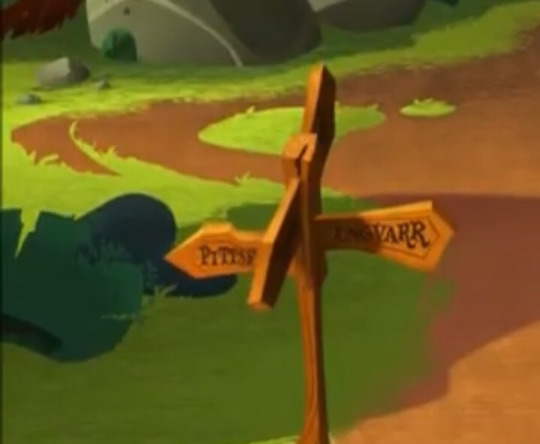
We can see Pittsford and Ivangarr on the road sign and we have to be in riding distance to Neserdina from Corona, but like are we in Corona still? Are we in Koto, which is Corona’s nearest neighbor to the east according to season three. Are we in some no-man’s-land where none of the kingdoms have control, or are we already in Neserdina itself?
The series gives us no sense of direction nor any firm placement for Corona within it’s world. I only know it is a Northern European country because Corona itself is a peninsula with a north sea, uses French, English, and German fashion/customs, and Rapunzel is a Germanic fairy tale. But like those clues are thrown into a blender and contradicted several times over, on top of never being told where it’s closest kingdoms actually lie.
All of this matters when traveling and exploring the wider world are big themes of your show. You need more solid and consistent world building than this. It also impacts how much authority and control your main character has within the episode itself if she range of political power is limited to one area. So like we need to know where the heroes stand here.
(FYI I personally headcannon Corona as former Prussia which was once part of Germany and it’s alliance of smaller kingdoms. It’s also a peninsula next to the Curonian Spit)
This Is Not Progress
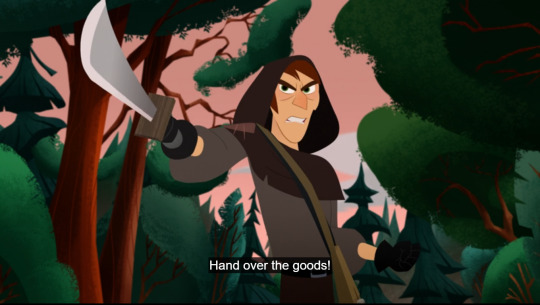
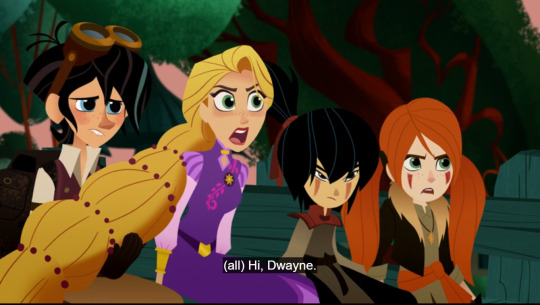
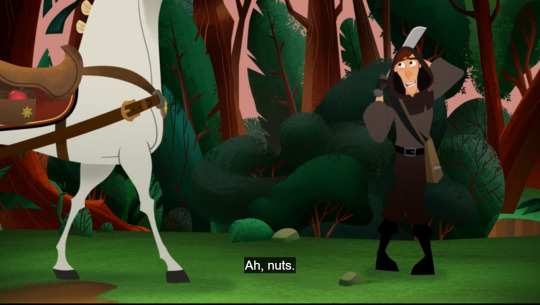
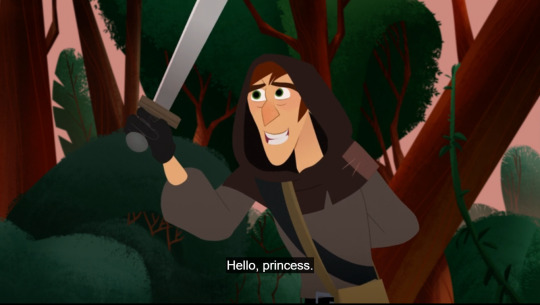
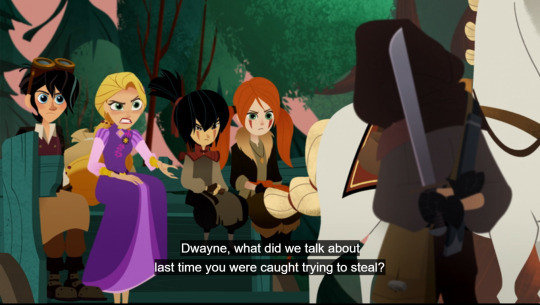

Okay so the idea here, is that the show is implying that Rapunzel is trying to improve Corona’s justice system over Frederic’s previously inhumane crack down on crime. However, this is terribly executed.
For starters the show has never called Frederic nor Rapunzel out for their previous misbehavior. You can not change any system for the better without acknowledging the flaws within said system first. Therefore this comes right out of nowhere and doesn’t stick around long enough to stay within the viewers minds for later.
Secondly, Rapunzel is incredibly fickle about who she does and doesn’t set free. The Saporians were still in the dungeons last time we saw them, Caine was shipped off to the prison island and left to die there as far as we know, and the Stabbingtons are shown shackled together in the wedding short even though they supposedly changed their ways and befriended Eugene again.
Meanwhile Dwayne and Stalyan are free to go their marry way and continue their life of crime, Varian is only released from his overly harsh punishment because he kissed Rapunzel’s ass not because it was wrong to imprison him in the first place, and later Cassandra gets away scot free because she’s Rapunzel’s bestie even though she committed the worst crimes out of everyone in the show and for very little reason.
That’s not justice. That’s not compassion. That’s not progressive reform. It’s just nepotism, and it’s every bit as corrupt as Frederic’s classism and totalitarianism.
Just because Rapunzel is “nice” it doesn’t mean that she is kind. Real reform has to treat everyone with equality and have a set of base standards that are beyond one person’s personal judgment. She is still a dictator and an abuser even if she lets the occasional person go free on a whim.

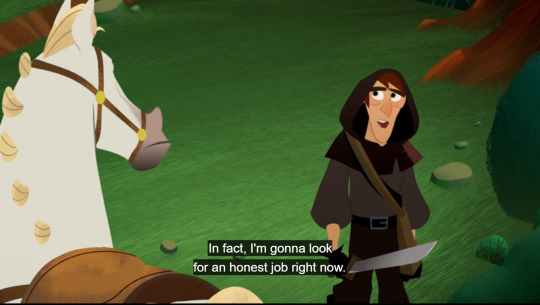
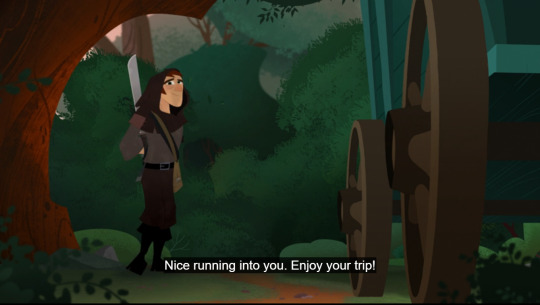
Finally, Rapunzel’s methods are just downright ineffective. Dwyane may not be a threat to our heroes, but that doesn’t mean he’s not a threat to other people. He’s not actually sorry about trying to rob people at knife point and he fully plans on continuing being a thief after feeding Rapunzel the lines she wants to hear.
Furthermore, we don’t know if this course of action is born out of malice or desperate need. He half heartily comments about finding ‘an honest job” but can he even do that? Is it even a realistic option for him? The series has been weaving this class inequality theme through out it’s past three seasons and directly connecting that to Corona’s crime rate.
Eugene had a hard time finding a job during season one directly due to his past record, remember? A life of crime he was forced to lead in order to survive, and he’s the Prince Consort! What chance does Dwayne have? Did Rapunzel even try to help him find work or did she just wag her finger at him and told him “Now, now, stealing’s not nice.”
The show wants to act like Rapunzel is this progressive reformer but then they turn her into a Republican instead. That’s not me being sarcastic either, this approach to criminal justice is the foundation of conservative belief and has been for centuries. The right are not interested in why people commit crime. They don’t care about addressing the fundamental problems in society that lead people to break the law. Let alone bother to analyze why those laws exist in the first place. Instead they resort to doublethink and survivor bias to either write off those that fall through the cracks or make excuses for why their policies repeatedly fail, often ignoring the fact that things aren’t actually working for whole swathes of people who aren’t themselves.
Tangled the Series is far too simplistic and childish in it’s approach to deeper subjects like this to enforce the messages it supposedly wants to enforce. Rapunzel herself relies on magical thinking, double standards, and personal bias to see her through every and any problem and the show just rewards her for it rather than challenging her to grow and in doing so winds up supporting people like her in their authoritarian ideas, whether that was the writers’ intentions or not.
In short, Rapunzel shows no interest in putting in the real work it would take to implement genuine restorative justice. She doesn't honestly care about Dwyane or his victims. She’s just posturing here for the sake of her self image.
You’re Not In Any Position to Talk Rapunzel
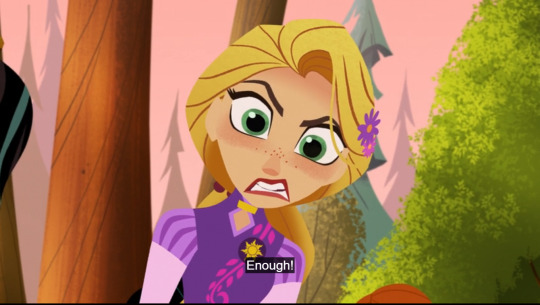

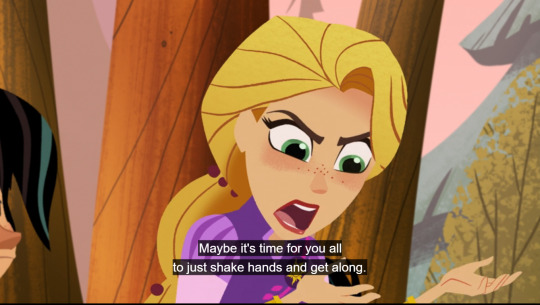
Speaking of Rapunzel being a hypocrite.... The entirety of season three’s main conflict is her having a petty bitch fight with her supposed best friend and needlessly dragging everyone else into it.
In fact that’s the whole show. Rapunzel repeatedly failing to get along with other people because she’s deep down a shitty person despite the veneer of ‘friendliness’ she slaps on to hide it. Having her just say she knows better does nothing to convince me that she’s actually learned anything. You have to show that she’s learned it first, and that requires acknowledging her own wrong doings.
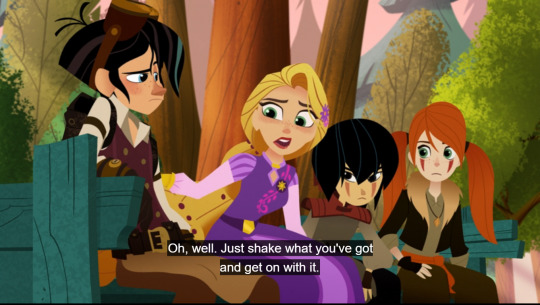
Varian’s face here just tells it all. Rapunzel is full of shit and no one in the show knows it better than him. Why are they even friends again? Why should we trust her with the three kids she neglected more than once? Why should any of these people take what she says seriously?
Well This is Contradictory
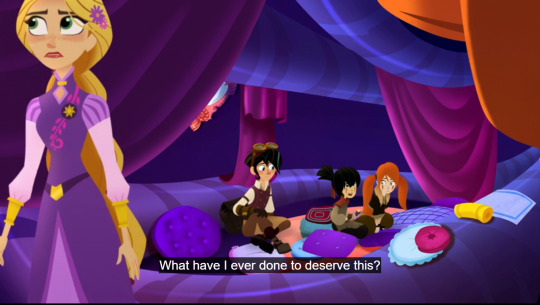
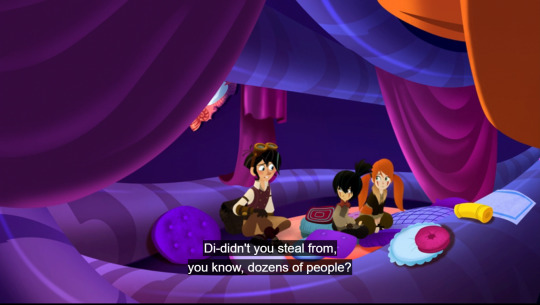
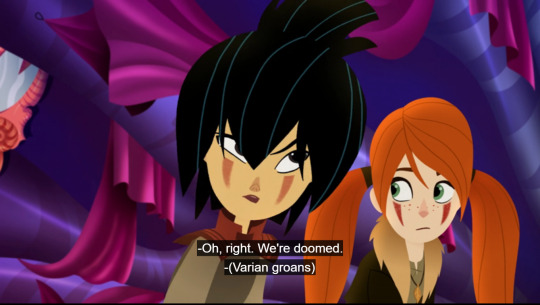
Also, since we brought up double standards, here’s Varian undermining that whole “jail is bad” thing Rapunzel is trying to push with Dwayne and later with Cass. Not only is the show under cutting it’s themes for a joke, but it just reinforces the abuse Varian received. He’s now bought into Frederic’s stupid beliefs and winds up reinforcing to the audience that that his ‘reform’ was due to his past imprisonment.
As an adult watching this series, Varian’s supposed redemption continues to increasingly look like a victim complying with their past abuser out of fear of further harm rather than anyone genuinely learning to be better.
Can We Please Stop Infantilizing the 16 Year Old

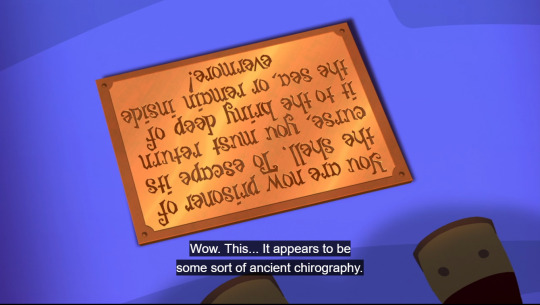
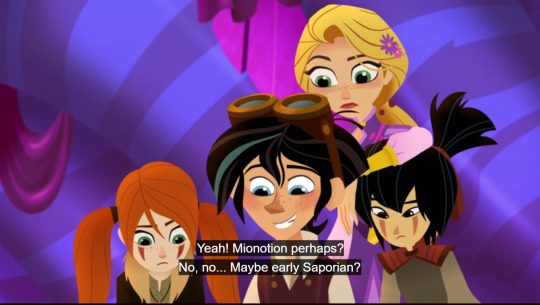
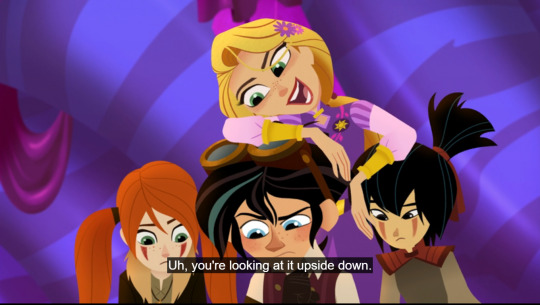

As if to deflect from Varian’s past mistreatment and continuing parentification, the show then goes on to showcase the opposite extreme whenever possible. I know it’s hard to tell just from these few screen shots alone, but over the course of season three Varian is spoken down too and treated condescendingly by the rest of the cast, and by Rapunzel in particular, even as he enters his later teens/early adulthood.
Some of this is just to due to Rapunzel being her usual holier than thou self, but there’s also times, like here, where Varian is lumped together with the actual children of the show, even though he’s 6 to 8 years their senior.
In fact out of everyone Rapunzel interacts with, Varian’s actually the closest to her in both age and development. Queen for a Day forced the two of them into a power imbalance due to a mixture of classism and society’s ongoing unhealthy (and often artificial) divide between younger and older teens, but as we get further and further away from that point in time and as Varian nears the same age Rapunzel started out as, that imbalance becomes less and less relevant.
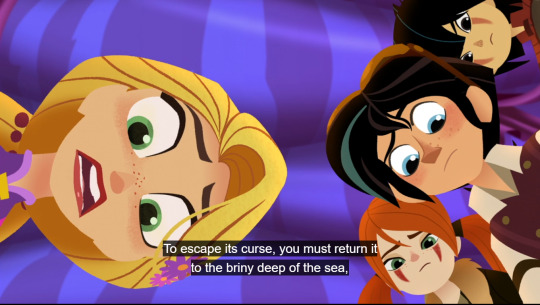
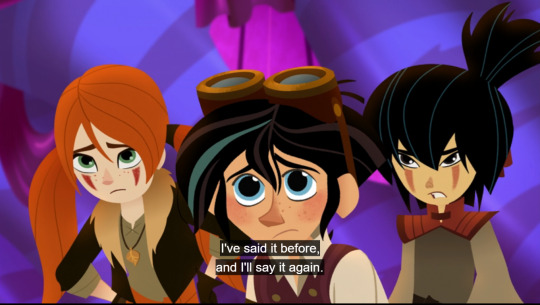
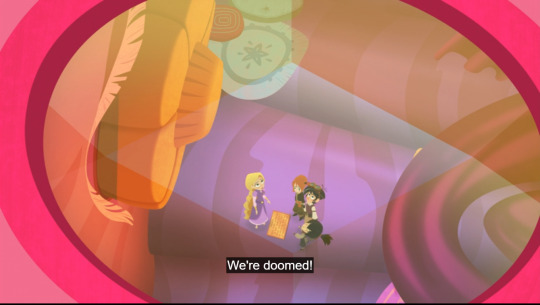
Look at how this scene is framed, He’s standing between Angry and Red and is placed lower than them to make it look like he’s one of them. He’s not.
Varian may still look 12 with his big old eyes and short stature, but seeing as how we’re past Hearts Day, he’s actually close to being 17, if he isn’t already. The timeline gets even wonkier after The King and Queen of Hearts, but trust me, we’re close to being two years past Queen for a Day, if not more so.
Varian, for all counts, should be Rapunzel’s equal by now in terms of story. Not only is he closest in age to her, but he’s also the only other person going through a coming of age arc. And of the two, Varian’s the one who has actually learned and grown as a person. He has more real world experience than Rapunzel ever will and knows how to implement that experience. (He’s also the more mature, but that’s more of a failure to write Rapunzel competently than a reflection of his capabilities.)
No matter how you slice it, Varian shouldn’t be taking orders or advice from Rapunzel; no one should be, really; and he most certainly shouldn’t put up with her condescension. Rapunzel is not his nor anybody else’s mother. She’s not even a big sister like figure, and at no point should be treated as the leader of anything or anyone.
Rapunzel is a Poor Man’s Rose Quartz
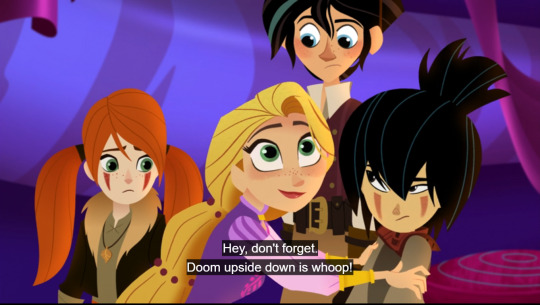
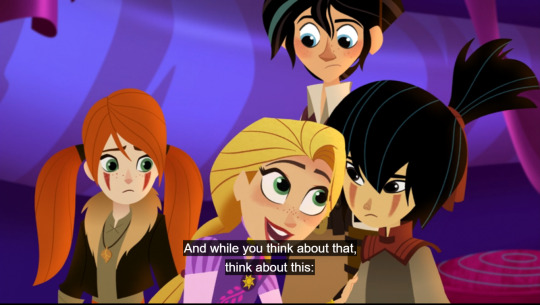
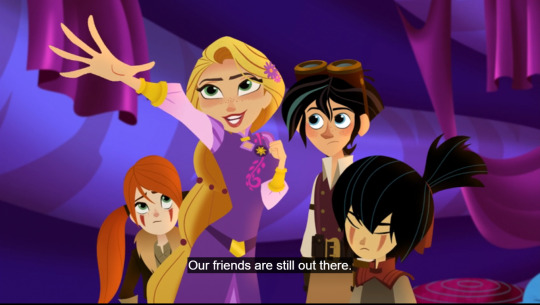
I typically try not to draw too many comparisons between Tangled and other shows outside of the occasional parallel, as a show should be able to stand on it’s own for good or for bad, but it’s hard not to discuss the series without also discussing Steven Universe in some way.
Steven Universe is this generation’s Batman the Animated Series or Scooby Doo. It’s the game changer that everybody else is trying to copy in some manner. Chris desperately wants Tangled the Series to be the next Steven Universe, right down to how the show is structured, paced, and what themes are presented. But unfortunately Chris has no idea why Steven Universe works the way it does.
For starters SU adjusted it’s pacing as it went along, smoothing out its rougher edges while Tangled doubled down on its filler. SU had a planned arc from the get go and stuck to it, so that by the time the twists came they made sense. SU kept it’s focus on Steven purposefully so that the story unfolded from his view point while making to sure to acknowledge the importance of other characters around him and their conflicts. It didn’t make him infallible nor shove aside everyone else’s arcs.
But most importantly, Steven Universe was written by a bisexual nonbinary person who set out to make a show for people in the queer community like themselves. Meanwhile, as a middle aged white man, Chis hasn’t a damn clue about his primary audience and has shown no interest in connecting with them.
This isn’t to say that Steven Universe is a perfect show. No show is beyond criticism. Nor is this to say that straight white cis men can’t write; many of them do and can portray characters unlike themselves competently enough. But if you’re completely disinterested in other points of view than you can’t be a good writer of fictional stories, that’s just a fact. Because in order to understand proper characterization you need to acknowledge that not every character ever will be like you and that even you’re main heroes will hold beliefs and experiences different from yourself. Otherwise there is no genuine conflict to build off of. Either no one will disagree with each other or the conflict will come across as flat and forced, complete with lopsided bias.
Therefore, in the end, Rapunzel winds up being less of a Steven and more of a Rose Quartz/Pink Dimond. Both are spoiled princesses/co-rulers of a kingdom that mistreats it’s people and anyone outside of it, who rebelled against their guardians, supposedly out of a sense of justice, but really for themselves and their own freedom, only to make things even worse for everyone. On top of that they both accidently harmed their friends, freindzone their best friend while also bossing them around, are condescending to their love interests, is controlling of people who trust them, and throws temper tantrums when they don’t get what they want, oh and neglected someone for an inhumane amount of time.
Even then, Rapunzel winds up being the worst of the two.
The whole point behind Rose was that she is someone whom the main characters place upon a pedestal and as the series went along slowly had the scales fall from their eyes and learned to view her for who she really was flaws and all. By the end, in Future, she is even metaphorically removed from her pedestal when Steven removes her picture from the wall.
Rose also grows as a character, unlike Rapunzel. Her story is deliberately being told to us backwards. The awful person she was in the past was no longer who she was by the time of her death. True she was still flawed, and the consequences of her actions continued on even after her demise, but she actually tried to be a better person. She got called out for her behavior, she wasn’t excused for actions even when the show explained why she did what she did, and she stopped doing harmful actions whenever she realized that they hurt someone.
Greg was allowed to stand up to her and show how she was wrong, and she respected him for it and later fell in love with him because of it. She tried to better control her temper when she wound up hurting her friend. Her failed revolution and her mistreatment of Spinel was actually born from a misguided desire to help, rather than outright selfishness.
Rose Quratz/Pink Dimond is a brilliant fucking character. You may not like her, but you can’t deny that she is one of the most complex figures in children’s media to ever be created. She is real, nuanced, and multifaceted. He role within the story is complicated, messy, and intricate. She is the most well rounded female character I’ve ever seen and she is what I had hoped Rapunzel would be when I first watched season one, only even more so as the actual focus.
I want women in cartoons to be people!
But Rapunzel fails at every turn to follow through with this promise. She is not a deep complex character. She’s not a flawed and complicated heroine. She’s a blank canvas in which the creator can shove his creepy ass views upon. She is never taken off her pedestal, she’s never allowed to be wrong, and she is forced to spout the the creator’s personal bias against other characters.
Rapunzel isn’t a person. She had the chance to be one, but then was reduced to .. to this. As a woman, the treatment of Rapunzel and Cassandra in this show is just flat out insulting.
So What Is the Difference Between Angry and Red Now?

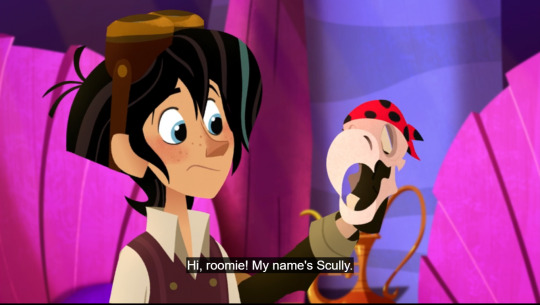
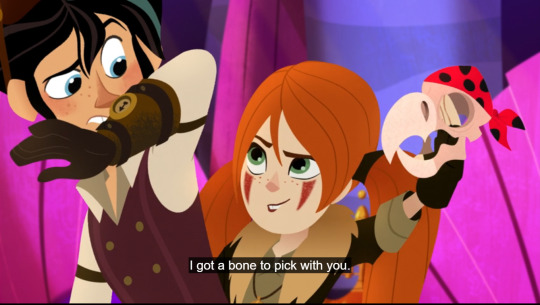

I’m all for character growth, but at this point Angry and Red are just interchangeable. Anything that made them uniquely them has been lost, and they’re now just fulfilling the generic rambunctious little kid trope. Red becoming more assertive shouldn’t mean she stops being an introvert altogether; that’s not how that works. While Angry shouldn’t lose her temper completely just because she’s wiling to open up more.
So Why Dwayne?
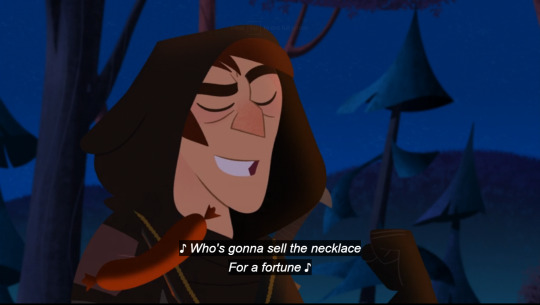

I like Dwayne as a character and in truth I don’t mind his existence here, and unlike that werewolf hunter last time he at least was established in a pervious season. But this is still time that could have went to a more important antagonist.
Also notice that Dwyane gets a villain song, but not Lady Caine or Zhan Tiri. Just saying.
Rapunzel Has Not Earned the Role of the Wise Sage and Mentor
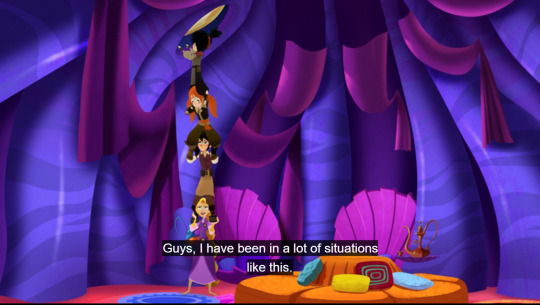
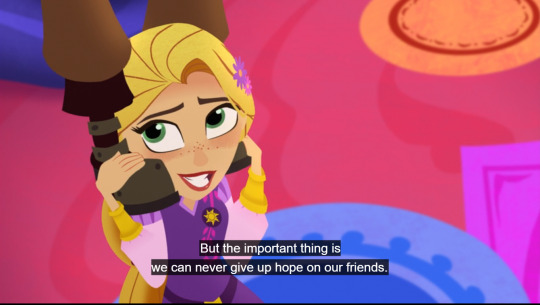
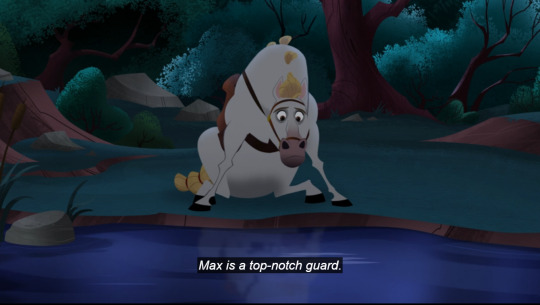
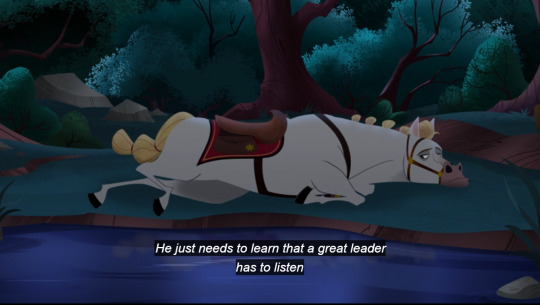
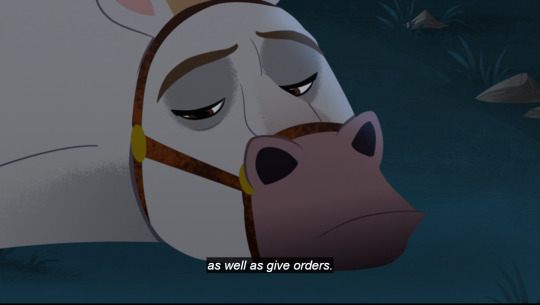
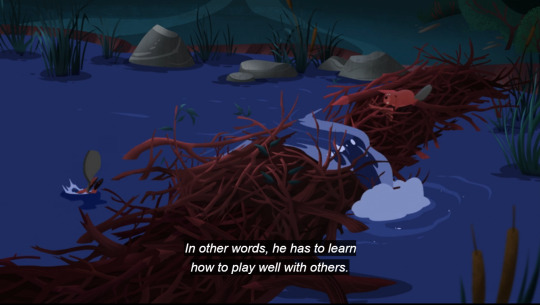
Rapunzel has never learned to listen to others. Ever.
On it’s own this might have been a good speech, but when taken in context of the wider story it just makes Rapunzel look like an ass.
A year traveling does not make Rapunzel suddenly all knowing. She is not wiser nor more experienced than anyone else in this scene. She’s also a crappy leader and big fat hypocrite.
Even when she’s technically right, as seen here, she’s still in the wrong because she never follows through and acts upon her own advice; making this whole story pointless in the grand scheme of things.
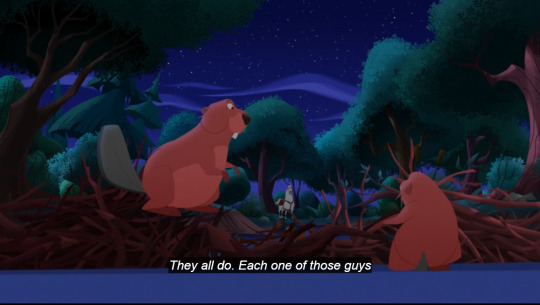
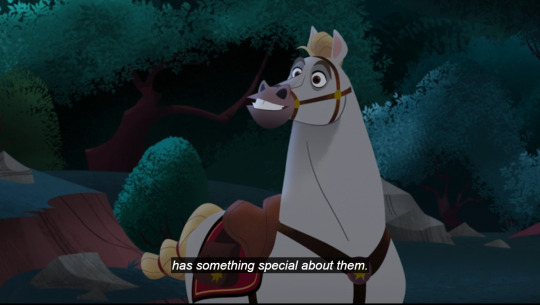

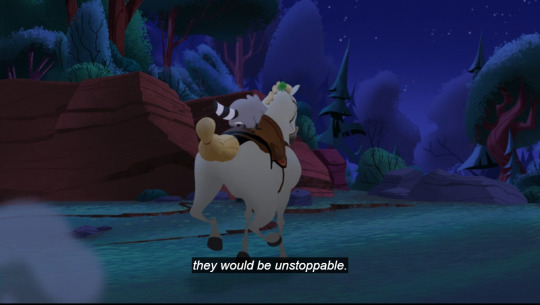
And that’s the core problem with season three. Rapunzel is shoved into a role she is not designed for and the whole premise of the series runs right off the rails. You’re main heroine in a coming of age story can not inhabit the mentor role. She can not simultaneously learn and grow and be always right while instructing everyone else.
All through out season three Rapunzel is either rendered completely useless in her own damn series, or she utterly fails to fulfill any sort of narrative promise laid out for her while she infuriatingly hijacks the story from more interesting and dynamic characters.
Behold The Only Reason Why Varian was Included in the Episode
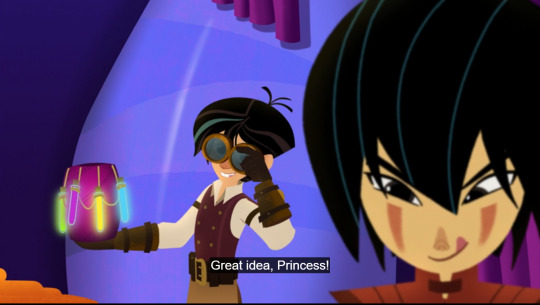
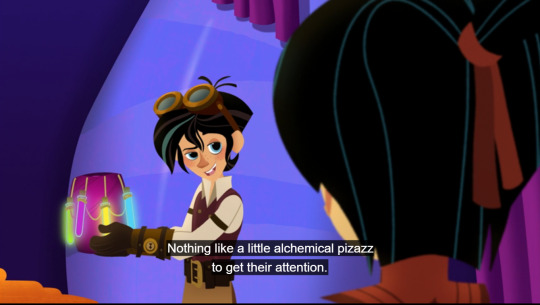
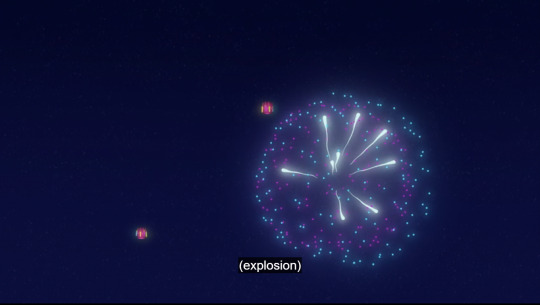
Speaking of hijacking things, Rapunzel of course has to get the idea to save everybody, even though what she thinks of isn’t anything special. It’s not derived from her character as an individual nor from all that experience she supposedly has. It’s literally an idea anyone could have come up with and the show just hands it to her in order to justify her exitance.
Meanwhile the character who actually is useful to the plot is sidelined and reduced to just a plot device. And not just here, Varian is rendered practically pointless in all but two episodes in season three, even in episodes that he actually should have more impact in, like the season opener and series finale.
Good writing treats characters as equally contributing to the plot in ways that complements who these characters are.
Ok I’ll Admit That This Line Is Funny
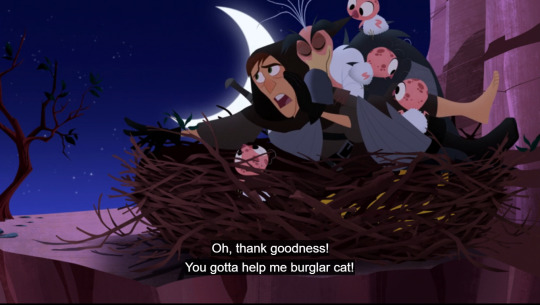
Look, I know this whole review series is about pointing out the negative, and I stand by my opinion that Tangled the Series is one of the worst written shows I’ve ever seen, but I want to make one thing clear.... I do not hate the show. If I hated the show I would not waste my time reviewing it.
Yes the over all writing is shit, but there are a lot of good things to be found in the series beyond just the crap story arc. The humor is usually solid, the animation is gorgeous, the music is a delight, and the majority of the characters are likable even though they don’t develop in the ways that they should. There’s a lot of talent that went into this show and there’s a lot of potential to be had in it’s set up and lore.
Being critical or negative about the aspects of something doesn’t mean you dislike it, or that you’re not a real fan, or that you’re just a ‘hater’, and I actually find TTS to be fascinating because it’s such a mess. I write reviews because they’re fun and because I genuinely think there is something to be learned from Tangled’s mistakes.
So Why Do We Cut Back to Rapunzel Here and Not Varian?
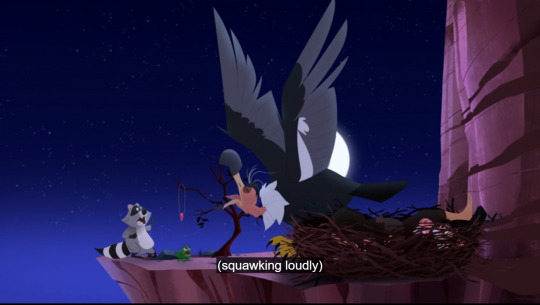
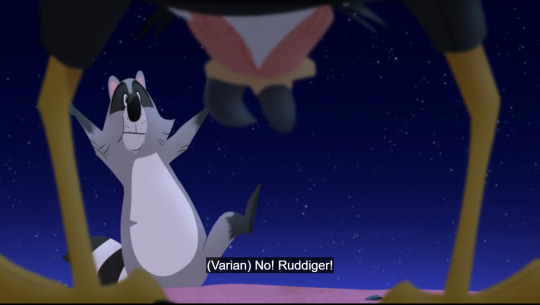
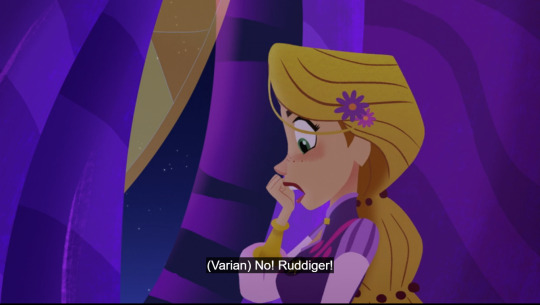
This is such an odd framing choice. Varian is the one who is talking and reacting to what’s happening. It’s his pet that’s in trouble and therefore he carries the emotional weight of the scene, and yet it’s Rapunzel’s shocked face we focus on? Why? What’s the point of that? She has no business being the center focus here. The action does not involve her.
If you wanted to include her for a later set up then why not have both her and Varian present in this shot? Usually I can at least count on the story boarders to frame things better than this, but they really missed the mark here. Unless Chris is just that stupid and petty that he over ruled them and forced Varian out of the scene, but that seems like a pointless fight to pick, even for him.
See This is How you Fulfill a Narrative Promise
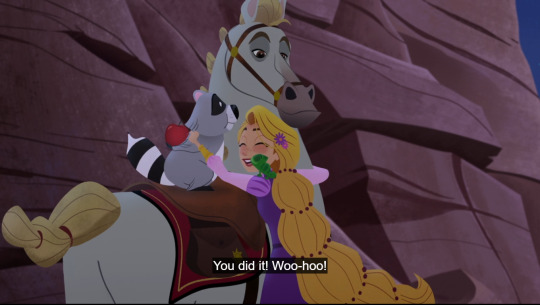
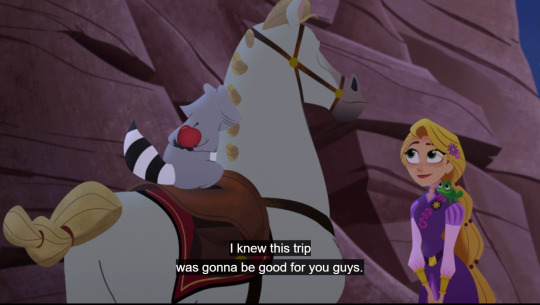
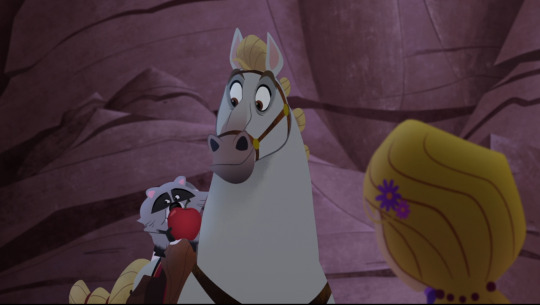
The conflict between Ruddiger and Max was set up in season one with What the Hair, then it was reiterated a few episodes ago during The Lost Treasure of Herz Der Sonne, and then it was reintroduced in this episode along with a stated lesson about working together that they needed to learn. By they end of the episode, guess what, they’ve learned to work together. That is how you properly set up and resolve a conflict.
It’s clear from this that the writers of Tangled the Series know the basic tenants of writing and how to fulfill narrative promises. So the fact that they don’t follow through with this in the majority of the show’s episodes and ongoing story arcs just baffles me.
Is it negligence? Is it hubris? Is it incompetent management and editorial mandates? Is it just one asshole ruining everything or is this a failure in the writers room as a whole?
I just don’t understand what the fuck went wrong here. There’s no reason for why the show got as bad as it did. How does the most acclaimed animation company in the world put out such amateurish tripe?
Just... wow.
Now you know why I’m mesmerized by this show. It is a mystery to be solved, like trying to figure out how the crew on the Titanic fucked up so badly or why Hindenburg blew up. You just can’t look away.
Conclusion
Like I said at the start, structurally speaking this is the strongest episode of the season. I personally enjoy Lost Treasure a little more, just because Rapunzel annoys me less in that, but it’s not a bad story. However when you’re best episode in your final season is filler, then you know you’re in trouble.
If you like my reviews and want to support my writing endeavors you can drop a tip in my kofi https://ko-fi.com/rachelbethhines
58 notes
·
View notes
Text
OC Questionnaire
I was tagged by @enasallavellan Thank You! This was really fun!
Answering for my Dragon Age: Inquisition OC from my ongoing fanfic series on AO3.
(This got a little long so more below the cut)
THE BASICS:
Character’s name:
Anyssa McBride
Role in story:
Inquisition Historian from Earth (MGIT story; Anchor series on AO3)
Physical description:
5ft 6in, wavy honey blonde hair that currently reaches midway down her back (on Earth it was roughly shoulder length, ice blue eyes
Age:
She is 26 when she arrives in Thedas and currently is 29 in my story. (She will be 30 shortly after the events set in Trespasser)
MBTI/Enneagram Personality Type:
I took two different tests when I created Anyssa and both labeled her as ‘ENFJ’—the giver or mentor. (I would argue that while she tested as an extrovert she does appreciate introvertedness and the current situation dictates which she chooses to be)
INTERNAL LIFE:
What is their greatest fear?
Being used and taken for granted
Inner motivation:
To help others and support them, hoping to see them happy
Kryptonite:
Having her self-doubts realized
What is their misbelief about the world?
Anyssa believes that everyone wants help and they just do not know how to ask for it. Unfortunately she has found out that some people just don’t want help no matter how sincere you are.
Lesson they need to learn:
She needs to learn to trust herself. Those around her know of her past on Earth and have made efforts to help her learn that. But no matter what, she still struggles with it, sometimes to the point of questioning whether she deserves the life she now has.
What is the best thing in their life?
A group of people who love and care for her. In other words, Friends
What is the worst thing in their life?
A history on Earth of those that were supposed to care for her, using her instead…and abuse. After her parents died in a car crash during her junior in high school, she went to live with her aunt and uncle who proceeded to steal the money her parents had left her for college. Later she entered into a relationship with a seemingly charming man named Bryan who turned out to be emotionally and physically abusive towards her. After two years she worked up the courage to attempt to leave. After multiple tries, she finally succeeded only to end up in Thedas.
What do they most often look down on people for?
Taking advantage of others, being cruel/mean to others, judging other without taking into consideration what they have been through
What makes his/her/their heart feel alive?
Writing stories based on those around her, sharing her knowledge with people who appreciate it, learning about the cultures and people around her, horseback riding, rock climbing, exploring the tunnels under Skyhold
What makes them feel loved, and who was the last person to make them feel that way?
The people she had come to know as friends in Thedas. They have become her ‘found’ family—something she thought to never have again. The last person to make her feel that way is Cullen. He always knows the right thing to say or the right thing to do to let her know she is loved.
Top three things they value most in life?
Acceptance by others, support of others, friendship
EXTERNAL LIFE:
Is there an object they can’t bear to part with and why?
No personal items from Earth made it through the rift to Thedas with Anyssa. What she has come to cherish most is the small items her friends have given her in an effort to make she feel at home. Most notably is the Cullen’s coin she wears around her neck and a stuffed dragon named Puff he gave her before they ever began their relationship.
Describe a typical outfit for them from top to bottom.
For her normal duties as historian, she wears simple dresses common to Ferelden fashion as well as blouses and skirts. For more formal affaires she wears one the many dresses Vivienne had made for her that incorporates Orlesian, Fereldan, and Free Marcher styles. For when she explores the caverns below Skyhold or travels away from the keep, she prefers typical traveling clothes and pants over skirts.
Most of her clothes are shades of light blue which Cullen said matches her eyes. She also wears purple in various shades being as it is her favorite color.
What names or nicknames have they been called throughout their life?
Nyssa and Nys. Most of her friends have called her Nyssa at some point in her life. Nys is only used by Cullen. He has also been known to use the endearment “sweetling” after they began their relationship.
What is their method of manipulation?
Anyssa isn’t known for manipulating anyone out right. Most of the time, she will rephrase an argument point to make the other party believe they are making a choice freely. This is not something she employs with people she is friends with or allied with. It a trick she holds in reserve when dealing with unreasonable nobles, especially when she has been called on to aid Josephine.
However, she is not above manipulating Cullen to either ensure he does not take on too much or because she would like some private time with him. A bright smile and repeatedly saying ‘please’ usually works. The first time Cullen realized he could not say no to her was when she asked to see a real dragon. In the end, he gifted her a stuffed dragon she named Puff and then took her to Crestwood to see the dragon there (from a safe distance of course.)
Describe their daily routine.
Anyssa’s routine various from day to day depending on the work load and what other duties she’s been tasked with. Normally, she holds any meetings in the morning and she makes time to watch the sparring ring from the battlements (especially if Cullen is participating). After that she may conduct any research she can on historical items the Inquisition has acquired and writes any correspondence to allies that might have knowledge she does not. She frequently checks in with Dagna in the Undercroft and reports the archanist’s progress to those interested. (Most people tend to shy away from Dagna but Anyssa finds her fascinating and funny.) She often finds Cullen for lunch and reminds him to eat. Her afternoons might involve cataloging artfifacts and tomes recovered in the hopes of returning them to their proper owners. If time allows, she can be found exploring and mapping the caverns and tunnels below Skyhold much to Cullen’s dismay. Throughout her day though, Anyssa has learned to work in time for her friends as well as for herself (though it has been a struggle in learning to do so)
Their go-to cure for a bad day?
There a several different answers to this. One is Sera. Both Anyssa and the Red Jenny enjoy pranks. Frequently Anyssa may provide the idea or inspiration while Sera carries out the actual pranks itself.
Horseback riding alone or with Cullen.
Playing Wicked Grace with Varric and/or Bull, Blackwall, and the Chargers. (Drinking and storytelling maybe involved.)
Reading a book with Cullen.
GOALS:
How are they dissatisfied with their life?
Overall, Anyssa is exceedingly happy with her life in Thedas. It is something she never thought to have again after her parents death and the abusive relationship with her ex-boyfriend. She had friends, a family, a career, someone to love her (whom she loves with all her heart), and a new purpose in life. If there was one thing that she would be dissatisfied with, it would be the knowledge that despite all the good the Inquisition did there will still be people who still cling to the old ways. In other words, she wishes that everyone could find the acceptance and support she has found but knows that the old ways are easier for some to hold onto instead of embracing change.
What would bring them true happiness or contentment?
Finally realizing that she did nothing wrong and it was not her fault that anyone left her or treated her poorly. Those were decisions made by others and she is not responsible for that. Cullen has aided her greatly in making progress with this but it is a struggle she will always have. But then again she has found a support network and love, so in the end she is already happy/content.
What definitive step could they take to turn their dream into a reality?
This is something Anyssa initially struggled with. Cullen was the first to admit he loved her and it took seven months before she could say it back. After that, they talked circles around making concrete plans about their future. Finally, they decided to just make the plans as they went (making a list of things they wanted.) When Cullen decided to start a Templar sanctuary after retirement, that solidified things. Now all that remains to be done is see the Inquisition through to the end and then begin their future.
How has their fear kept them from taking this action already?
Her past relationship colored how she reacted to Cullen’s affections and made her question whether she could trust his words. (she learned to trust his actions first and then his words)
Haven and Skyhold were the places she first felt welcomed in Thedas, like she had a real home again.
She questioned whether she could be lead historian in a world she knew nothing of, questioning even the skills she had learned on Earth.
How do they feel they can accomplish their goal while still steering clear of the thing they are afraid of?
Anyssa has decided to focus on what she can do in the present and prepare for the future she wants. She has begun making plans for how to transfer her skills to a slightly different career path aft her the conclusion of the Inquisition and has told Cullen she will support his dream of a Templar sanctuary while pursuing her own path. To ensure that happens, she will more than likely rely on Cullen for reminders to believe in herself and trust that she knows what she is doing. In the end, it all comes down to trust for Anyssa and her Commander is the one she trusts the most.
Tagging @commanderadorkable, @shadoedseptmber, @raflesia65, @noire-pandora and anyone else who would like to play! No pressure, just fun!
11 notes
·
View notes
Text
Druids ain’t shit and here’s why.
Straight from the Pond- here’s a lesson from your friendly neighborhood historian.
It’s a long post so the history lesson is under the cut.
Druidic “history” (or pseudohistory rather) actually begins with early renaissance politics.
Basically Italy is dominating politics and religion by being able to call back to an ancient history that led directly into the formation of the centralized Catholic church. Surprising nobody who's familiar with European history- the German states want in on that action but they don't really have that direct line linking them to antiquity beyond their conquering by Rome- so, like any good 15th century academics, they create that link by just making shit up.
So they look back at ancient roman writings, and see mention of druids, and also realize that they actually don't know fuck all about them, there's no records of them beyond a few classical authors- and for the record, classical authors are NOTORIOUSLY unreliable, there are entire graduate level seminars dedicated to teaching people how to read through ancient Roman propaganda, almost every druid I have ever met has taken classical authors at face value, anyway I digress, they just start making up a history of the druids, German lands used to be populated by Celts, and they create these mystical druids who serve as the direct precursor to The Church in these areas, like they forge documents and everything so when Italy goes "oh yeah since when?" they have something to hold up as a "gotcha" - they fashion statues and hide them in crypts as further evidence. It’s wild.
So, France sees that the German states are becoming more politically popular within the HRE (Holy Roman Empire) because of these druid stories, and so they go "Hey Celts used to live in France too... we should have druids"- and they create druid stories. Scotland at the time is very close with France politically and they go "Hey us too, we're still Celts,” and then it spreads to Wales, and then England. Ireland is mostly staying out of druid nonsense- like in this period of the OG pseudohistories Ireland is like "this is disgusting we don't want druids" so like all the writings in Ireland in this period on druids are like "yeah the Church HATES druids"
Things quiet down for a little bit, because the stories are established, the cards have been played, whatever, but then Neo-Classicism and the Enlightenment- and now suddenly it's cool to have ancient history again - but like... Britain has "we got conquered by Rome" or "hey a few centuries ago people were saying we had druids?”; so naturally the more nationalistic go with druids....which is how we get, Iolo Morganweg. Iolo's real name is Edward Williams but he insisted on going by his "bardic name"- bc druids. Williams was a Welsh antiquarian- who is in some scholastic circles considered the father of “modern” druidry. Williams literally named his son Taliesin after the bardic poet behind the Poems of Taliesin which is frequently in association with the Mabinogi in Brythonic texts. To pull from the wiki on this asshole:
[he made] claims that ancient Druidic tradition had survived the Roman conquest, the conversion of the populace to Christianity, the persecution of bards under King Edward I, and other adversities. His forgeries develop an elaborate mystical philosophy, which he claimed as a direct continuation of ancient Druidic practice. Williams's reportedly heavy use of laudanum may have been a contributing factor
Yeah.... just... yeah. So not only did he forge like hella documents, which today in the 21st century, over 100 years after he was revealed as a fraud, are still more popular than the originals- but he also is the reason that ogham is like that. Williams created a ‘bardic alphabet’ based on combining Scandinavian runes and extant ogham - we are still wading through his bullshit trying to fix ogham.
And this brings us to the Celtic Twilight......
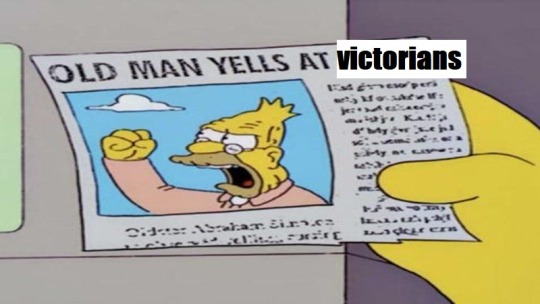
To quote @liminalblessings, “And a bunch of noodle fuckers decide "hey, we didn't bastardize the Irish enough for the last however long.... We should do more of that."” But for those of you not familiar with the term, it's a nationalistic pan-Celtic movement that wanted to like, make the Celts in vogue again? but like their idea of the Celts as "noble savage” - because the modern era was scary. At this point, Pan-Celtic Nationalism is starting to rise as pushback against British colonialism in Celtic nations. Unfortunately it's heavily reliant on the Druid myth as like.... A foundational shared cultural history between the surviving Celtic nations. The point largely is, though, "look at us. We should all be sticking together because we're the same / cousins / brothers". Which leads to a L O T of Celtic culture from various countries kind of getting.... molded into one singular idea- which is USUALLY what we think of today when we think of Celts. Basically everything gets branded as Irish because the Irish were “pure” and a “separate racial identity” as opposed to the Scots and Welsh. It took that idea of a pan-Celtic singularity, and then went ham with it mostly on Irish pre-Christian stuff, and as it occurred not too long after Williams’ fuckery, it really cemented those forgeries and psuedohistories in the cultural memory. And Williams wasn’t exposed as a fraud until after the Celtic Twilight had died down.
Now... Yeats, we all know Yeats- some people recommend his writings for learning about the fairies. DO NOT LISTEN TO THOSE PEOPLE. Yeats makes up an entire tree calendar, and also files all Scottish fairy lore under the “Irish” tab because he’s part of the Celtic Twilight and didn’t you know that everything Celtic is actually Irish? Fuck this guy. #yeetyeats
Enter... Robert Graves- destroyer of histories and all around fuckwit. Graves maked up an ENTIRE religious notion around a mother goddess and shit. And like, the irony of that is the people he supposedly went to originally were like lol dude you're a fucking idiot none of this is real. But he published it anyways and of course it got taken seriously. And then there's a lot of reverse etymology at this point which is just.... really bad linguistics. And because of Graves’ white goddess + said bad linguistics by others, you get Danu.(Danu is a whole thing, please shoot me an ask if you want a post about all of that nonsense).
So.... Gerald Gardener.... to quote @liminalblessings again- “didn’t have a direct role in druidism, except he kind of did.” See, Gardner had a good friend who was hella interested in the Celtic twilight. Said friend was hella inspiried by Gardner's "recreation" of old British trad witch traditions... But he didn't jive with the old British trad witch traditions. HE jived with Irish Druidry. So while Gardner's doing HIS thing, his friend's doing the modern Druid thing- heavily drawing from Gardner's own work but "making it more historically Druid" Except, as you may have picked up- there is no such thing as “historically druid” that can be reconstructed. Basically he can only pull from Williams, but because he had issues with with the old 15th century on stuff, up to the Twilight era (despite those being his sources) so he tries to distance himself from the earlier movements and leans hella heavy into Gardner's work as a result. Which is, if you've ever wondered, why Wicca and Druidry have such incredibly similar ritual structures and beliefs.
SO, this guy starts the Druid Order, decides that he’s gonna like pull his teachings from Williams- but he's also gonna say that Williams has nothing to do with his druidry because y'know, Williams has relatively recently been revealed as a fraud. This guy goes through the grueling process of ripping off his best bud gardner founding Druidry, right. So The Druid Order has this rebranding in 1951, that lauds the “history of the druids” as written by Williams but simultaneously rejects Williams saying “yeah we have nothing whatsoever to do with that guy.” Mix into this narrative, Gardener’s “burning times” bullshit, and now not only do we have mythical pseudohistorical druids, but a rewrite of Williams’ “the druids survived conversion” which then turned into - “The druids were heavily persecuted by the church and survived a horrible burning times but despite this there’s a tradition of continuous druidic belief.” Here begins the bullshit known as “vestiges of pagan thought”- which took actual historians not even a decade to disprove, and yet still circulates in pagan circles, because nobody picks up a fucking book. Theoretical Folkloric archaeology became very popular at this time, which postulates (incorrectly) that all folk traditions and folklore absolutely stems from Pagan times and is 100% the Christianization of pagan practices and thoughts- which is not at all true. (Not-so-friendly reminder that Eostre? DOESN’T FUCKING EXIST. STOP FALLING FOR A JOKE MADE BY A MONK)
Td;lr so far- the druids went from
the Catholic clergy before the Catholics existed
to
a religious group that survived conversion
to
druids survived an intense and violent persecution
And now? In this our 21st century?
Well.... druidic organizations today tend to still push these ahistorical narratives, that buy into the pagan persecution complex.... and several of these organizations also have known racists and terfs on their recommended reading lists. And while some organizations have made attempts to become more historically accurate- but the end result is usually.... bad. It tends to result in them using a source from like 1960 that’s been disproven 1000 times since by other historians to go “look a historian agrees with us!” rather than like... keep up with current research trends and academic standards. Druids also tend to be hostile to the syncretism of the Irish church which is just..... so fucking dumb. Don’t worship gaelic deities if you can’t accept that our lore are Christian texts about pagan beliefs.
So yeah..... druids ain’t shit and I can prove it historically. I am also more than willing to send anyone links to full length books on the history of druids if you want to learn more.
158 notes
·
View notes
Text
The New Nihilism
It feels increasingly difficult to tell the difference between—on one hand—being old, sick, and defeated, and—on the other hand—living in a time-&-place that is itself senile, tired, and defeated. Sometimes I think it’s just me—but then I find that some younger, healthier people seem to be undergoing similar sensations of ennui, despair, and impotent anger. Maybe it’s not just me.
A friend of mine attributed the turn to disillusion with “everything”, including old-fashioned radical/activist positions, to disappointment over the present political regime in the US, which was somehow expected to usher in a turn away from the reactionary decades since the 1980s, or even a “progress” toward some sort of democratic socialism. Although I myself didn’t share this optimism (I always assume that anyone who even wants to be President of the US must be a psychopathic murderer) I can see that “youth” suffered a powerful disillusionment at the utter failure of Liberalism to turn the tide against Capitalism Triumphalism. The disillusion gave rise to OCCUPY and the failure of OCCUPY led to a move toward sheer negation.
However I think this merely political analysis of the “new nothing” may be too two-dimensional to do justice to the extent to which all hope of “change” has died under Kognitive Kapital and the technopathocracy. Despite my remnant hippy flower- power sentiments I too feel this “terminal” condition (as Nietzsche called it), which I express by saying, only half-jokingly, that we have at last reached the Future, and that the truly horrible truth of the End of the World is that it doesn’t end.
One big J.G. Ballard/Philip K. Dick shopping mall from now till eternity, basically.
This IS the future—how do you like it so far? Life in the Ruins: not so bad for the bourgeoisie, the loyal servants of the One Percent. Air-conditioned ruins! No Ragnarok, no Rapture, no dramatic closure: just an endless re-run of reality TV cop shows. 2012 has come and gone, and we’re still in debt to some faceless bank, still chained to our screens.
Most people—in order to live at all—seem to need around themselves a penumbra of “illusion” (to quote Nietzsche again):—that the world is just rolling along as usual, some good days some bad, but in essence no different now than in 10000 BC or 1492 AD or next year. Some even need to believe in Progress, that the Future will solve all our problems, and even that life is much better for us now than for (say) people in the 5th century AD. We live longer thanx to Modern Science—of course our extra years are largely spent as “medical objects”—sick and worn out but kept ticking by Machines & Pills that spin huge profits for a few megacorporations & insurance companies. Nation of Struldbugs.
True, we’re suffocating in the mire generated by our rule of sick machines under the Numisphere of Money. At least ten times as much money now exists than it would take to buy the whole world—and yet species are vanishing space itself is vanishing, icecaps melting, air and water grown toxic, culture grown toxic, landscape sacrificed to fracking and megamalls, noise-fascism, etc, etc. But Science will cure all that ills that Science has created—in the Future (in the “long run”, when we’re all dead, as Lord Keynes put it); so meanwhile we’ll carry on consuming the world and shitting it out as waste—because it’s convenient & efficient & profitable to do so, and because we like it.
Well, this is all a bunch of whiney left-liberal cliches, no? Heard it before a million times. Yawn. How boring, how infantile, how useless. Even if it were all true... what can we do about it? If our Anointed Leaders can’t or won’t stop it, who will? God? Satan? The “People”?
All the fashionable “solutions” to the “crisis”, from electronic democracy to revolutionary violence, from locavorism to solar-powered dingbats, from financial market regulation to the General Strike—all of them, however ridiculous or sublime, depend on one preliminary radical change—a seismic shift in human consciousness. Without such a change all the hope of reform is futile. And if such a change were somehow to occur, no “reform” would be necessary. The world would simply change. The whales would be saved. War no more. And so on.
What force could (even in theory) bring about such a shift? Religion? In 6,000 years of organized religion matters have only gotten worse. Psychedelic drugs in the reservoirs? The Mayan calendar? Nostalgia? Terror?
If catastrophic disaster is now inevitable, perhaps the “Survivalist” scenario will ensue, and a few brave millions will create a green utopia in the smoking waste. But won’t Capitalism find a way to profit even from the End of the World? Some would claim that it’s doing so already. The true catastrophe may be the final apotheosis of commodity fetishism.
Let’s assume for the sake of argument that this paradise of power tools and back-up alarms is all we’ve got & all we’re going to get. Capitalism can deal with global warming—it can sell water-wings and disaster insurance. So it’s all over, let’s say—but we’ve still got television & Twitter. Childhood’s End—i.e. the child as ultimate consumer, eager for the brand. Terrorism or home shopping network—take yr pick (democracy means choice).
Since the death of the Historical Movement of the Social in 1989 (last gasp of the hideous “short” XXth century that started in 1914) the only “alternative” to Capitalist Neo-Liberal totalitarianism that seems to have emerged is religious neo-fascism. I understand why someone would want to be a violent fundamentalist bigot—I even sympathize—but just because I feel sorry for lepers doesn’t mean I want to be one.
When I attempt to retain some shreds of my former antipessimism I fantasize that History may not be over, that some sort of Populist Green Social Democracy might yet emerge to challenge the obscene smugness of “Money Interests”—something along the lines of 1970s Scandinavian monarcho-socialism—which in retrospect now looks the most humane form of the State ever to have emerged from the putrid suck-hole of Civilization. (Think of Amsterdam in its heyday.) Of course as an anarchist I’d still have to oppose it—but at least I’d have the luxury of believing that, in such a situation, anarchy might actually stand some chance of success. Even if such a movement were to emerge, however, we can rest damn-well assured it won’t happen in the USA. Or anywhere in the ghost-realm of dead Marxism, either. Maybe Scotland!
It would seem quite pointless to wait around for such a rebirth of the Social. Years ago many radicals gave up all hope of The Revolution, and the few who still adhere to it remind me of religious fanatics. It might be soothing to lapse into such doctrinaire revolutionism, just as it might be soothing to sink into mystical religion—but for me at least both options have lost their savor. Again, I sympathize with those true believers (although not so much when they lapse into authoritarian leftism or fascism)— nevertheless, frankly, I’m too depressed to embrace their Illusions.
If the End-Time scenario sketched above be considered actually true, what alternatives might exist besides suicidal despair? After much thought I’ve come up with three basic strategies.
1) Passive Escapism. Keep your head down, don’t make waves. Capitalism permits all sorts of “lifestyles” (I hate that word)—just pick one & try to enjoy it. You’re even allowed to live as a dirt farmer without electricity & infernal combustion, like a sort of secular Amish refusnik. Well, maybe not. But at least you could flirt with such a life. “Smoke Pot, Eat Chicken, Drink Tea,” as we used to say in the 60s in the Moorish Church of America, our psychedelic cult. Hope they don’t catch you. Fit yourself into some Permitted Category such as Neo-Hippy or even Anabaptist.
2) Active Escapism. In this scenario you attempt to create the optimal conditions for the emergence of Autonomous Zones, whether temporary, periodic or even (semi)permanent. In 1984 when I first coined the term Temporary Autonomous Zone (TAZ)
I envisioned it as a complement to The Revolution—although I was already, to be truthful, tired of waiting for a moment that seemed to have failed in 1968. The TAZ would give a taste or premonition of real liberties: in effect you would attempt to live as if the Revolution had already occurred, so as not to die without ever having experienced “free freedom” (as Rimbaud called it, liberte libre). Create your own pirate utopia.
Of course the TAZ can be as brief & simple as a really good dinner party, but the true autonomist will want to maximize the potential for longer & deeper experiences of authentic lived life. Almost inevitably this will involve crime, so it’s necessary to think like a criminal, not a victim. A “Johnson” as Burroughs used to say—not a “mark”. How else can one live (and live well) without Work. Work, the curse of the thinking class. Wage slavery. If you’re lucky enough to be a successful artist, you can perhaps achieve relative autonomy without breaking any obvious laws (except the laws of good taste, perhaps). Or you could inherit a million. (More than a million would be a curse.) Forget revolutionary morality—the question is, can you afford your taste of freedom? For most of us, crime will be not only a pleasure but a necessity. The old anarcho-Illegalists showed the way: individual expropriation. Getting caught of course spoils the whole thing—but risk is an aspect of self-authenticity.
One scenario I’ve imagined for active Escapism would be to move to a remote rural area along with several hundred other libertarian socialists—enough to take over the local government (municipal or even county) and elect or control the sheriffs & judges, the parent/teacher association, volunteer fire department and even the water authority. Fund the venture with cultivation of illegal phantastice and carry on a discreet trade. Organize as a “Union of Egoists” for mutual benefit & ecstatic pleasures—perhaps under the guise of “communes” or even monasteries, who cares. Enjoy it as long as it lasts.
I know for a fact that this plan is being worked on in several places in America—but of course I’m not going to say where.
Another possible model for individual escapists might be the nomadic adventurer. Given that the whole world seems to be turning into a giant parking lot or social network, I don’t know if this option remains open, but I suspect that it might. The trick would be to travel in places where tourists don’t—if such places still exist—and to involve oneself in fascinating and dangerous situations. For example if I were young and healthy I’d’ve gone to France to take part in the TAZ that grew around resistance to the new airport—or to Greece—or Mexico—wherever the perverse spirit of rebellion crops up. The problem here is of course funding. (Sending back statues stuffed with hash is no longer a good idea.) How to pay for yr life of adventure? Love will find a way. It doesn’t matter so much if one agrees with the ideals of Tahrir Square or Zucotti Park—the point is just to be there.
3. Revenge. I call it Zarathustra’s Revenge because as Nietzsche said, revenge may be second rate but it’s not nothing. One might enjoy the satisfaction of terrifying the bastards for at least a few moments. Formerly I advocated “Poetic Terrorism” rather than actual violence, the idea being that art could be wielded as a weapon. Now I’ve rather come to doubt it. But perhaps weapons might be wielded as art. From the sledgehammer of the Luddites to the black bomb of the attentat, destruction could serve as a form of creativity, for its own sake, or for purely aesthetic reasons, without any illusions about revolution. Oscar Wilde meets the acte gratuit: a dandyism of despair.
What troubles me about this idea is that it seems impossible to distinguish here between the action of post-leftist anarcho-nihilists and the action of post-rightist neo-traditionalist reactionaries. For that matter, a bomb may as well be detonated by fundamentalist fanatics—what difference would it make to the victims or the “innocent bystanders”? Blowing up a nanotechnology lab—why shouldn’t this be the act of a desperate monarchist as easily as that of a Nietzschean anarchist?
In a recent book by Tiqqun (Theory of Bloom), it was fascinating to come suddenly across the constellation of Nietzsche, Rene Guenon, Julius Evola, et al. as examples of a sharp and just critique of the Bloom syndrome—i.e., of progress-as-illusion. Of course the “beyond left and right” position has two sides—one approaching from the left, the other from the right. The European New Right (Alain de Benoist & his gang) are big admirers of Guy Debord, for a similar reason (his critique, not his proposals).
The post-left can now appreciate Traditionalism as a reaction against modernity just as the neo-traditionalists can appreciate Situationism. But this doesn’t mean that post-anarchist anarchists are identical with post-fascism fascists!
I’m reminded of the situation in fin-de-siecle France that gave rise to the strange alliance between anarchists and monarchists; for example the Cerce Proudhon. This surreal conjunction came about for two reasons: a) both factions hated liberal democracy, and b) the monarchists had money. The marriage gave birth to weird progeny, such as Georges Sorel. And Mussolini famously began his career as an Individualist anarchist!
Another link between left & right could be analyzed as a kind of existentialism; once again Nietzsche is the founding parent here, I think. On the left there were thinkers like Gide or Camus. On the right, that illuminated villain Baron Julius Evola used to tell his little ultra-right groupuscules in Rome to attack the Modern World—even though the restoraton of tradition was a hopeless dream—if only as an act of magical self-creation. Being trumps essence. One must cherish no attachment to mere results. Surely Tiqqun’s advocacy of the “perfect Surrealist act” (firing a revolver at random into a crowd of “innocent by-standers”) partakes of this form of action-as-despair. (Incidentally I have to confess that this is the sort of thing that has always—to my regret—prevented my embracing Surrealism: it’s just too cruel. I don’t admire de Sade, either.)
Of course, as we know, the problem with the Traditionalists is that they were never traditional enough. They looked back at a lost civilization as their “goal” (religion, mysticism, monarchism, arts-&-crafts, etc.) whereas they should have realized that the real tradition is the “primordial anarchy” of the Stone Age, tribalism, hunting/gathering, animism—what I call the Neanderthal Liberation Front. Paul Goodman used the term “Neolithic Conservatism” to describe his brand of anarchism—but “Paleolithic Reaction” might be more appropriate!
The other major problem with the Traditionalist Right is that the entire emotional tone of the movement is rooted in self-repression. Here a rough Reichean analysis suffices to demonstrate that the authoritarian body reflects a damaged soul, and that only anarchy is compatible with real self-realization.
The European New Right that arose in the 90s still carries on its propaganda—and these chaps are not just vulgar nationalist chauvenist anti-semitic homophobic thugs—they’re intellectuals & artists. I think they’re evil, but that doesn’t mean I find them boring. Or even wrong on certain points. They also hate the nanotechnologists!
Although I attempted to set off a few bombs back in the 1960s (against the war in Vietnam) I’m glad, on the whole, that they failed to detonate (technology was never my metier). It saves me from wondering if I would’ve experienced “moral qualms”. Instead I chose the path of the propagandist and remained an activist in anarchist media from 1984 to about 2004. I collaborated with the Autonomedia publishing collective, the IWW, the John Henry Mackay Society (Left Stirnerites) and the old NYC Libertarian Book Club (founded by comrades of Emma Goldman, some of whom I knew, & who are now all dead). I had a radio show on WBAI (Pacifica) for 18 years. I lectured all over Europe and East Europe in the 90s. I had a very nice time, thank you. But anarchism seems even farther off now than it looked in 1984, or indeed in 1958, when I first became an anarchist by reading George Harriman’s Krazy Kat. Well, being an existentialist means you never have to say you’re sorry.
In the last few years in anarchist circles there’s appeared a trend “back” to Stirner/Nietzsche Individualism—because after all, who can take revolutionary anarcho-communism or syndicalism seriously anymore? Since I’ve adhered to this Individualist position for decades (although tempered by admiration for Charles Fourier and certain “spiritual anarchists” like Gustave Landauer) I naturally find this trend agreeable.
“Green anarchists” & AntiCivilization Neo-primitivists seem (some of them) to be moving toward a new pole of attraction, nihilism. Perhaps neo-nihilism would serve as a better label, since this tendency is not simply replicating the nihilism of the Russian narodniks or the French attentatists of circa 1890 to 1912, however much the new nihilists look to the old ones as precursors. I share their critique—in fact I think I’ve been mirroring it to a large extent in this essay: creative despair, let’s call it. What I do not understand however is their proposal—if any. “What is to be done?” was originally a nihilist slogan, after all, before Lenin appropriated it. I presume that my option #1, passive escape, would not suit the agenda. As for Active Escapism, to use the suffix “ism” implies some form not only of ideology but also some action. What is the logical outcome of this train of thought?
As an animist I experience the world (outside Civilization) as essentially sentient. The death of God means the rebirth of the gods, as Nietzsche implied in his last “mad” letters from Turin— the resurrection of the great god PAN—chaos, Eros, Gaia, & Old Night, as Hesiod put it—Ontological anarchy, Desire, Life itself, & the Darkness of revolt & negation—all seem to me as real as they need to be.
I still adhere to a certain kind of spiritual anarchism—but only as heresy and paganism, not as orthodoxy and monotheism. I have great respect for Dorothy Day—her writing influenced me in the 60s—and Ivan Illich, whom I knew personally—but in the end I cannot deal with the cognitive dissonance between anarchism and the Pope! Nevertheless I can believe in the re-paganaziation of monotheism. I hold to this pagan tradition because I sense the universe as alive, not as “dead matter.” As a life-long psychedelicist I have always thought that matter & spirit are identical, and that this fact alone legitimizes what Theory calls “desire”.
From this p.o.v. the phrase “revolution of everyday life” still seems to have some validity—if only in terms of the second proposal, Active Escapism or the TAZ. As for the third possibility— Zarathustra’s Revenge—this seems like a possible path for the new nihilism, at least from a philosophical perspective. But since I am unable personally to advocate it, I leave the question open.
But here—I think—is the point at which I both meet with & diverge from the new nihilism. I too seem to believe that Predatory Capitalism has won and that no revolution is possible in the classical sense of that term. But somehow I can’t bring myself to be “against everything.” Within the Temporary Autonomous Zone there still seems to persist the possibility of “authentic life,” if only for a moment—and if this position amounts to mere Escapism, then let us become Houdini. The new surge of interest in Individualism is obviously a response to the Death of the Social. But does the new nihilism imply the death even of the individual and the “union of egoists” or Nietzschean free spirits? On my good days, I like to think not.
No matter which of the three paths one takes (or others I can’t yet imagine) it seems to me that the essential thing is not to collapse into mere apathy. Depression we may have to accept, impotent rage we may have to accept, revolutionary pessimism we may have to accept. But as e.e. cummings (anarchist poet) said, there is some shit we will not take, lest we simply become the enemy by default. Can’t go on, must go on. Cultivate rosebuds, even selfish pleasures, as long as a few birds & flowers still remain. Even love may not be impossible...
25 notes
·
View notes
Text

Christmas in The Devildom | Home Alone Edition
desc :: Mari tells a tale of what happened during her Christmas during her exchange student program.
word count :: 2247
note/s :: I got this idea about Mari having to defend herself from demons while she’s alone on Christmas. But then I realised... “Hey! This is literally just the premise of Home Alone!” so I decided to write it.
relationship/s :: implied fluffwings | jack x mari / implied greedwings | mammon x mari
art credit :: KEMM01 on Deviantart
edit credit :: me

Holiday season was a lovely time of cheer and giving for most people. Mari gave a sigh of relief, finally done giving her last gift of the day. Yes, seeing the generally happy reactions of the people she cared for brought joy to her weary heart, even if those people didn’t necessarily care for her back. Now it was just time to relax during the NRC Christmas party.
Everyone from every dorm had gathered to the cafeteria to partake in the festivities. Every nook and cranny had been decorated to perfection. But maybe that was pushing things a bit since Mari was the one that had to decorate everything after Crowley pushed the work onto her for the hundredth time she’s lived in Twisted Wonderland at the last minute when he just decided that a Christmas party might help bring students together more. At least she can rest while the first years talked about how they spent their Christmas at home.
“Mari.” The girl looked up to see Epel looking at her with a curious gaze. “What was Christmas like for you when you were in your world?”
“Yeah, we’ve been the ones talking here but you haven’t shared anything the whole time,” Ace spoke up as he bit into some cookies.
“Ah, sorry—”
“Didn’t you live in Hell for a year? What’s Christmas there like?” Deuce asked, placing a finger to his chin in thought.
Mari was silent for a moment, trying to get her thoughts and memories in order.
“Um… it’s kind of a long story. Are you guys alright with that?” She glanced at each of their faces for confirmation.
“You’re an excellent storyteller, Mari. It’d be wonderful to hear it,” Sebek chimed in, placing his food on the table and sitting with them.
She nodded, relieved that they seemed to be alright to tell them.
“So… I was mostly left alone during the holidays—”
“Eh? Left alone?” Ace raised an eyebrow.
“Yeah… We were going to celebrate but the demon brothers and the folks at Purgatory Hall were called to a meeting and had to take care of some business in a farther area in the Devildom. I wasn’t able to come because that place had particularly deadly air for humans…”

“Why do I have to go?! There’s gonna be a whole bunch of Christmas special limited edition figurines for Rurichan and all my favorite idols!” Levi had complained as he stuffed his fifth Rurichan figurine into his luggage.
“I was planning on eating a Christmas feast…” Beel had also whined, rubbing his stomach. In his hands were three gigantic bags filled with snacks and snacks only.
“Is it really okay to leave Mari here?” Asmo asked, who was mostly just clinging onto her body; She’s had to swat his grabby hands from touching her more intimate parts a couple times but cuddles with him were generally still quite lovely. Among them, he had the most packed luggages that was all dedicated to his beauty and fashion.
“Yeah, lesser demons might take this opportunity to sneak into this place and eat Mari.” Satan at least had a reasonable amount of bags. Though, he held one novel in his arm.
She sighed, running her hand through her sift chocolate locks. “Guys, no offense but you were the ones to put me in the most danger here during my exchange program here.”
They all seemed sheepish now. “Uhh—“
“Enough whining. We’re going to be late already,” Lucifer spoke up. “Mari should be fine. No one would be stupid enough to harm her if they knew the consequence will be being charged with treason and being tortured for eternity.”
Mari gave a thumbs up. “Yeah. There’s nothing to worry about.” Her eyes widened, noticing something rather odd.
She looked around. “Where’s Mammon?” She asked.
“He said he had something to do,” Satan answered.
Lucifer turned around and started walking. “We’ll leave him behind. He can catch up,” he spoke. His shoes made light clicking noises against the floor as he left the premises, the rest of the brothers followed him.
“Hey! Wait up!” Mammon yelled as he darted out of his room, carrying a bunch of stuff with him.

“Hey! Are you guys telling stories?” Kalim’s bright voice interrupted her speech. A large grin was plastered on his face.
“Kalim, don’t just barge into conversations like that,” Jamil scolded him. He carried two trays filled with food, one for him and one for Kalim.
“It’s fine! I was getting to the interesting part.”
“Très bien! How wonderful to see you all spending quality time during this festive party! It touches my heart,” Rook’s voice appeared from behind them, causing some of the first years to jump in surprise.
“Your bodyguards left you alone during Christmas? That seems rather irresponsible of them if they knew there was still a chance of you being attacked by demons,” Vil spoke as the two also sat down at the table next to theirs.
She nodded, looking down and biting her lip. “Well… The house did end up being attacked.”
“EH?!” Their eyes were as wide as the plates they were eating from.
“How did you manage to survive?”
“During the last day of school, a bunch of lesser demons had whispered about taking the opportunity to come by and eat my soul after classes. Little did they know, I had overheard their conversation and that gave me some time to prepare…”

Mari rushed around the House of Lamentation, rope and other sorts of equipment that she hastily purchased from Akuzon in her arm. Knowing that this house had a variety of magical items that even she could use despite having a lack of it.
Satan’s room had all sorts of cursed books and Levi’s room had magical merch. If worse comes to worst, she’ll use the grimoire underground. It’s more of a last resort since she knew what happened when Luke was lost and ended up there. Lucifer would’ve killed her if it weren’t for Diavolo.
She stopped in her tracks when she looked into Mammon’s stuff in case he had anything that could be used. Her eyes widened to see a murder of crows in his room.
… What?
One of the crows flew up and landed on her shoulder. “Hey there! You’re Mari, right? We’re Mammon’s familiars! He told us a lot about you. He had us stay here to watch over you.”
“That idiot is so reckless that she’d probably get herself into trouble without me so make sure nothing bad happens to her!” … were his exact words.” A different crow spoke up, imitating his voice and tone with such perfect accuracy that it startled the girl.
A grim pulled at her lips. “Great! A bunch of demons are coming here soon and I’ll be needing your help to defend the place.” She explained her plan to them.
“Wow! You already got this thing planned out,” the first crow commented. “Just give us the order and we’ll do our best!”
Mari nodded, smiling in gratitude for them. She turned around and rushed out the room to start setting everything up.
Using her knowledge of the items in the House of Lamentation, she set up a bunch of traps around the place and sat in the living room, waiting for them to trigger. Near each trap was at least one crow to lure the demons into the traps. In one hand was a controller for one of Levi’s consoles. The other held a specific book that was just titled “Void”.
“Really hope this works…” The girl muttered, her grip around the items tightened.
A cacophony of screams echoed throughout the place and several crows flew to her from different directions, signalling that the traps were successful.
She gave a sigh of relief, happy that they worked. There had been this worry that gnawed at her heart when she thought of the possibility of her ropework being too weak. Fortunately, that seemed to not be the case.
Mari checked the bands she put on their feet. Each crow had a different color so that she would know which traps got triggered.
Red, white, yellow, and green… Ah!
Red was in charge of luring the demon into a tripwire trap where if they triggered it, it’d pull the pin from a makeshift grenade she made out of Ruri-chan’s Extra Devilish Spicy Powder that she got from Levi’s room. Levi described it to be so spicy that it can cause a demon to pass out as soon as it comes into contact with their nose and eyes.
White was in charge of watching the catapult. If the door with the trap gets opened, the demon would get Asmo’s “special rope” launched at them. It would completely immobilise anyone if it makes contact with someone’s skin.
Yellow was the one watching over the gun trap. If the window was opened, it’d pull the trigger on the replica gun she got from Levi’s room. It had been from “I Got Isekai’d To A Fantasy Historical Drama But I Didn’t Expect To Find Out That 7 Generals Would Fall For Me”. The bullets weren’t lethal or anything, but they were the magical sort that could knock out a demon with one bullet.
Last but not least was green, who watched over the back door. She roped up a bunch of cursed books from Satan’s room, careful not to touch them with her bare hands, and hung them over the door. If triggered, it would drop all the books and curse the demon into 5 months of deep slumber. 5 months felt a bit excessive, but it was probably better than being charged of treason and being tortured for eternity.
However, it seemed that the other two crows didn’t return just yet.
Then, rushed footsteps started approaching the living room. She looked up to see the last crows flying and two demons running towards her. The looks on their faces oozed with murderous intent as they neared her.
… Shit, looks like the last two traps either didn’t get triggered or they found a way around them.
But all she did was bite her lip and opened the book with the pages facing them.
The room started shaking as a dark aura covered the book. The demons screamed when they started getting pulled into the pages of the book, scrambling to keep their ground. However this was in vain, as they ended up getting sucked into the book anyway.
And with that, Mari gave a loud sigh of relief, dropping her body onto the couch. She pressed a button on the controller.
Nothing around her really happened upon pressing it. But the other demons that were immobilised were put into Levi’s game. She had to know their identities first, which was surprisingly easy to find on Devilgram. She should be able to let them out later. Hopefully they don’t die in the game. She had set it to easy mode, after all.
“Yay! We did it!” The crows cheered, gathering close to each other and even doing a little dance in the process.

“... And that was the end of that story. After that night, the demon brothers came back and we spent a lovely Christmas together, the Devildom way.” Mari’s story came to a close. She looked at all the students that were immersed in her story.
“You were able to defend yourself against a whole group of demons in a single night?!” Ace’s eyes were wide open. His expression was mirrored by the others.
“Très bien! You’ve displayed such wonderful resourcefulness against opponents who are much stronger than you!” Rook praised her in his own fashion, gazing at her with his amused hunter green irises.
Jamil nodded, placing his hand to his chin in thought. A small smile could be seen on his face if one were to look close enough. “Using what you had around the house to use as traps… How clever,” he mumbled.
“You’d be a great fit for Scarabia!” Kalim grinned.
“You were able to set all those traps in such a short amount of time. With that sort of workspeed, Pomefiore could make use of your efforts,” Vil retorted, crossing his arms.
A new voice spoke up, “Oh, but her cunning wit should be further honed in Octavinelle. I’m sure I’d make better use of her skill.”
Jamil’s expression turned sour at the sight of the dorm leader of Octavinelle.
“Nonsense! She belongs in Diasomnia with the young master!” Sebek’s voice boomed across the cafeteria.
“Oi! Quiet down, you noisy brat,” Leona spoke up from another table beside them. He glared at the first year.
And that was the start of a rather chaotic argument between all the dorms.
Jack and Mari looked at each other with exasperated expressions.
“You wanna get out of here?” She offered.
All he did was scratch the back of his head and nod. “Yeah, it’d be better if we just went somewhere else.”
The two of them got up and sneaked away from the group that was too absorbed in their fight.
Although, Mari couldn’t help the smile creeping on her face as she processed the fact that they had complimented her. At the time, she didn’t think it was all too special. But it felt really nice to receive such validation.
Perhaps they saw her better now. Someone who isn’t weak all because she had no magic.
The thought soothed her.
33 notes
·
View notes
Text
Dragon Raja IV - Chapters 3 & 4 (Abridged)
Hi everyone, continuing with today's chapters, these are centered around Nono and Caesar and their lives after he returned from Japan.
Previous chapters
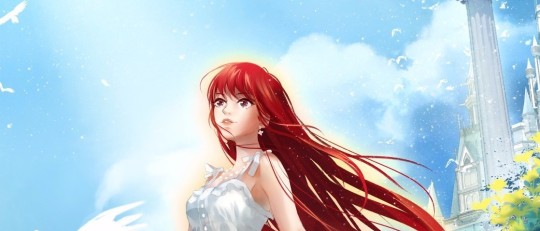
Chapter 3
Mediterranean Sea, Republic of Malta.
The Island of Frefra is mostly an ecological reserve, there is a white building on top of a natural harbor with luxury yachts and sailing boats. Tourists and locals have always been interested in knowing more about its residents, but the government is very secretive about it. It is well protected against binoculars and often, music can be heard coming from the inside. Girls in white dresses walk around it and they're known as the "Iris girls".
At 5:45 am, a rotating alarm clock started playing a terrible heavy metal song, making its way through fashion magazines and snacks, it ran around the bedroom of Chen Motong, who finally trapped it and took its batteries out.
She slept for another 20 minutes and woke up in a hurry. She had classes to attend. Cooking lessons, Japanese tea ceremonies, British literature and music appreciation, amongst other things. This was the Golden Iris Shuyuan Academy. It was meant to educate Nono on how to live among nobility.
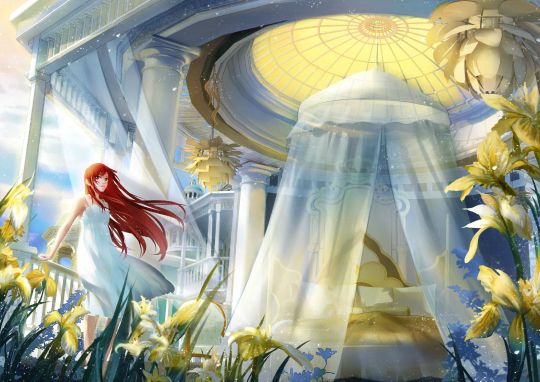
She arrived late at the breakfast table only to realize the other girls were betting on her punctuality. After she accepted Caesar's proposal, he took her to Rome to meet his relatives, some of which were more than 300 years old, they left their cryogenic beds and unexpectedly blessed their marriage (after evaluating her from head to toes). Nono's own family was rich and powerful, known as the Black Prince Group. After both families signed the marriage contract, they agreed to make Nono drop out of Cassell to take a years-long bridal training in the Shuyuan Academy.
During her dancing lessons, a yawning Nono was the only one who couldn't keep up with the rhythm, prompting her teacher to whip her foot.
At her cooking class, she kept eating bits off her dish, leaving almost nothing for the teacher to evaluate.
She managed to succeed on her tea ceremony while her boredom made her toes fight each other behind her back. She was distracted during literature and used her profiling skill to cheat on her analysis of classical music.
She unwillingly started regretting the moment she accepted the marriage proposal, but not because of Caesar, it was all about the life that awaited her. The lessons were relentless and the academy was isolated from the outside world. She didn't sleep enough because she used her Cassell training to sneak out at 10:00 pm to swim by the beach, that was the only time in her day when she felt truly free.
She toyed frequently with her obnoxious alarm clock, it was a gift from her old classmate, Luminous. On her last birthday, he casually carried a backpack with him all day, it was pretty obvious that he was preparing to give her a gift, which he nervously did, and he was the only person who dared to do so, as everyone else felt intimidated by Caesar.
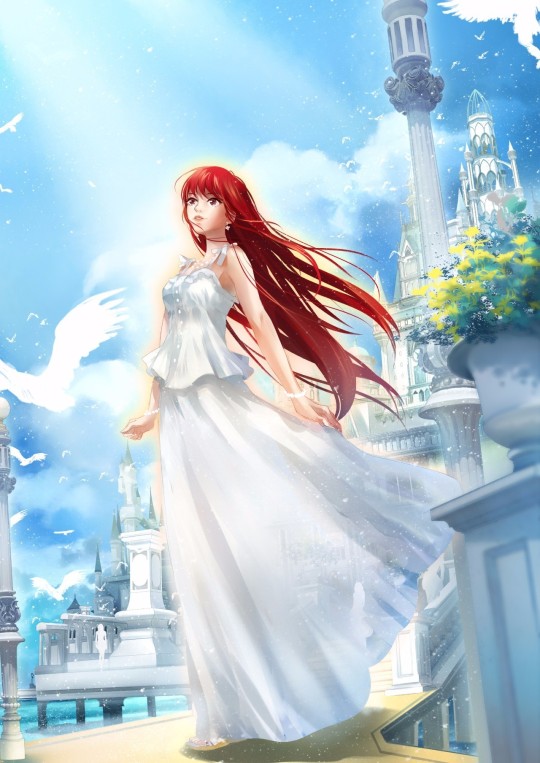
She knew about Luminous's feelings for her. All of the male classmates who liked her could easily fill the whole cafeteria. Luminous was just one of them. She considered herself a passer-by in his life, thinking some girls of his age (like Zero) would be a better match for him. One day he'd mention it as a thing of the past and they would both laugh about it.
She hoped to finish the bridal course in months, but it had already been a year. She brought mostly books but she quickly ran out of things to read.
Suddenly, she realized someone was hiding in her bedroom, right after the cleaning lady left. The intruder took one of her books and a bag from her secret stash of potato chips. She turned off the lights and grabbed a knife, more excited than scared, she searched for the thief.
After finding nothing, she remembered her bathtub, and there he was, asleep with the missing book on his face and a bag of chips in his belly. She punched him in the stomach. A patrolling Nun showed up, concerned, Nono hid the intruder in the tub and pretended to take a bath. If someone found Luminous in her room, they would accuse Nono of having an affair.
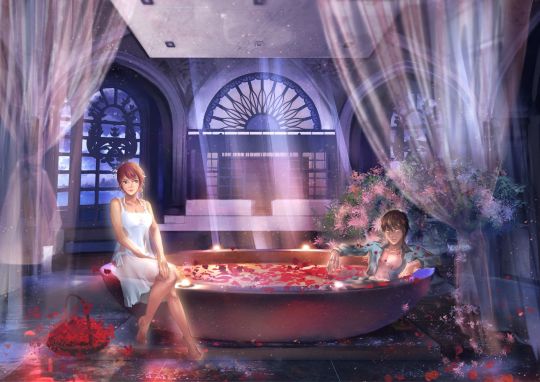
The nun searched the whole place with a revolver but couldn't find anyone, before leaving, she had a conversation with Nono about her situation in the academy, specifically her wish to leave. In the lady's words, "Her soul seemed to lag behind her body". Luminous finally understood that she was there to become the perfect bride. When the nun left, Nono scolded him for his presence, she realized he looked different, he was clearly taking care of himself, better dressed, he definitely had a better haircut. He also thought she looked somehow different, more elegant, but exhausted.
His stomach roared, breaking a long awkward silence and she took him out to steal some food for him. They took wine from the cellar, along with some ham and cheese.
-Sister, do you know Johann Chu? -Maybe, was he your boyfriend or did he just owe you money?
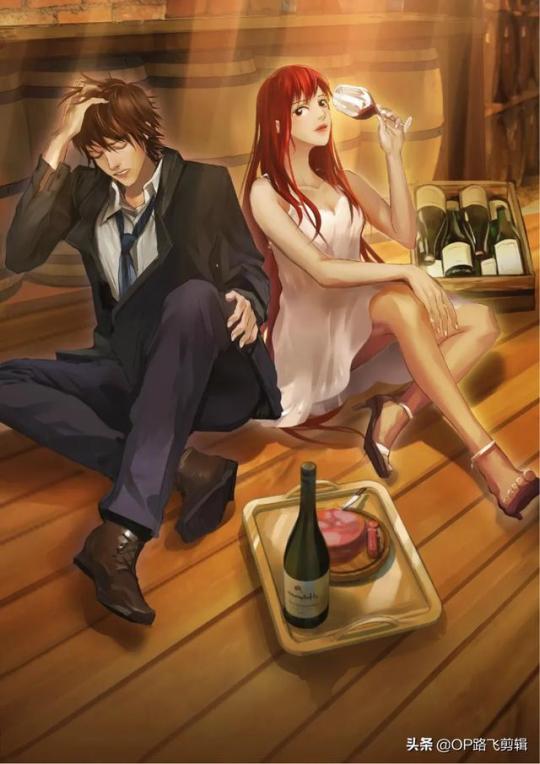
Luminous explained his situation to her: he decided to go with the school's psychologist, professor Toyama, who diagnosed him as schizophrenic. Toyama attempted to erase Johann off his memory, but Luminous responded by making a scene and drawing out his desert eagles. He tried to track Johann in everyone else's memories but his missing classmate didn't have many friends.
Anjou couldn't remember him either. Back during Luminous's second year, there was no trial against a Blood Rage user, Frost Gattuso only accused the principal for his terrible administration. The rollercoaster incident happened way after they finished their ride with Shavee. Anjou gave Luminous the location of Chen Motong, telling him to use her profiling ability to find some clues.
However, Nono also believed Luminous had schizophrenia and convinced him to stop his search and look for treatment instead. Luminous lamented his condition and how he couldn't trust the world he lived in anymore, however, despite how enticing it was to forget Johann and go back to the real world, he felt his brother was still out there, waiting to be saved, but everyone forgot about him. Nono couldn't do much for him in his situation.
-Years ago, you were not the president of the Student Union, but a scared boy that I rescued from a theater. Now that you don't trust the world anymore, you came back to me. How many more times do you think I'll be here to save you?
Suddenly, a security guard noticed the candle they lit in the cellar. Nono didn't know how to react, but someone broke a bottle of wine on the guard's head and knocked him down. It was Finger, who informed Luminous that now he was wanted by Cassell, as they thought he was an undercover agent sent by the Dragon Raja.
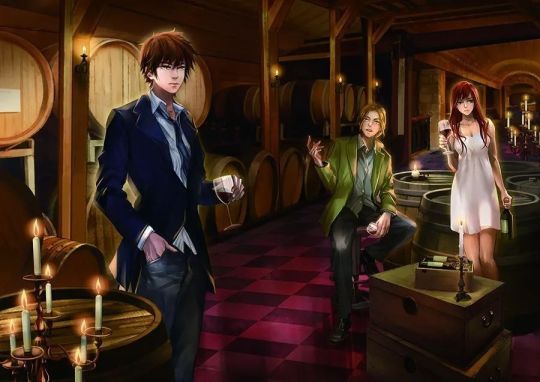
Apparently, on the same night that Luminous left the college, someone entered the Ice cellar and stole Constantine's skeleton, severely injuring principal Anjou in the process. The only student with such clearance and power was the S-Rank himself.
Agents of the Execution Bureau went looking for Finger in Cuba, so he buried them in a tobacco field, with their heads out, of course.
Nono urged them to understand the seriousness of what it meant to be hunted by the secret party, which essentially made them targets of the whole world. They could leave no traces for Norma to track down. She considered there were three possibilities:
1- Luminous was insane.
2- He was an undercover agent sent by the dragon raja all along.
3- He was the only person in the world who was't hypnotized.
The only being who could be responsible for the third option is the white dragon king. Its skeleton was never recovered. Their only option was to travel with Luminous in secret to track down any trace that Johann might have left in the world before he disappeared.
-I really hope my brother is alive... -True Love! Said Finger and Nono in unison.
Finger then urged them both to leave and "go save the world" but Nono refused to leave. She had a responsibility with her family and with Caesar. As Luminous turned around and started walking, Finger stunned her, urging Luminous to help him carry her outside.
Chapter 4
Caesar Gattuso was sitting down in a church. This was the anniversary of his mother's death, so he wore a suit, drove a Harley Davidson motorcycle on his way there and brought her a bouquet of white flowers.
When he was younger, she bought him a miniature bike, she also loved to see him wearing little suits. Most of Caesar's style was based on her taste, he thought that would please her while she watched him from heaven.
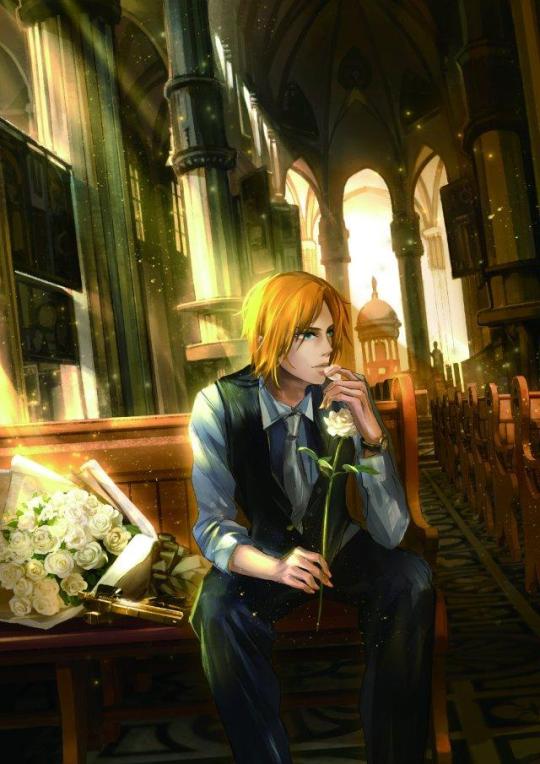
The first time he had been on the Milan cathedral, he was attending her funeral. The ceremony was presided by the pope himself. Knowing of his family's involvement in her death, he poured kerosene on the coffin and lit a fire on the church. The authorities managed to save the historical building and despite of it all, Caesar was still allowed inside every year to mourn Gulweig, (as long as he wasn't carrying any dangerous chemicals).
Parsi Gattuso arrived in a car to give him some urgent news, his wife Chen Motong had gone missing. He brought with himself a letter that she wrote for her fiancé, it expressed Chen's dissatisfaction with her new life, asking him to give her some time.
Caesar immediately realized the poetic letter was fake, since Nono wouldn't bother to express herself in such a way. According to him, Nono would just write "Caesar, I'm leaving" In a napkin and leave it on top of her bed. The letter was probably written by a narcissistic person like Finger.
However, this left him reflecting on Nono's true feelings towards her future, wondering if all he did was capturing a bird (that he initially admired for its freedom) just to lock it in a cage.
Far away in Cassell College, the elders of the Secret Party reunited for an emergency meeting, the first one since 1961. Many famous individuals that once shaped the course of history were in it, still alive after faking their deaths to cover up their slow aging. In the principal's chair, Leonardo Flammel, the vice-principal and a direct descendant of Nicholas Flammel sat down and started the meeting.
He welcomed EVA, Norma's war personality with 140,000 times her processing power, and asked her to project a life-like hologram of Anjou's assassination attempt.
According to the recording, the previous night, the principal intended to access the ice cellar, but he stopped meters before reaching the entrance. He looked behind and said:
-Is that you?
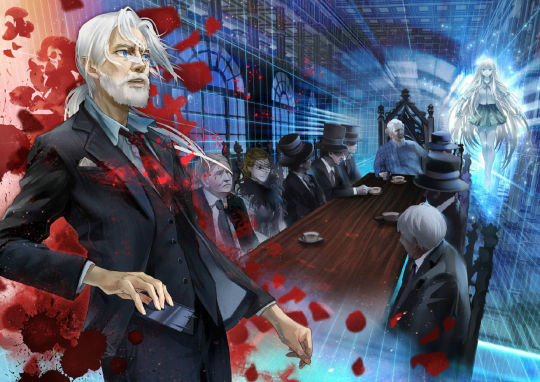
In a fraction of a second, his access card had left his pocket after something cut through it. His entire body started bleeding from multiple cuts to his skin. He had no time to react and tried to use the card as his weapon, since the attacker didn't give him enough time (even using Time Zero) to draw his dragon slaying knife. It was guessed that his opponent could use Time Zero as well, but was more skilled in combat than the principal himself.
The security system identified the situation in time and called the police and medical assistance, otherwise, Anjou would have died. The conversation quickly turned to Luminous's possible involvement in the situation, Flammel had a conversation about it with "Mr. Beowulf", who was also present.
The legendary Beowulf was not an individual but a family of dragon slayers. They had a strong attraction to dragon blood, for them it was almost like drugs to an addict.
They were the most fierce dragon hunters in history, pouring the blood of their prey and drinking it after every successful kill. Their newborns were poisoned with dragon blood and only those who survived the process were considered worthy of living. Their latest descendants were almost dragon-like in appearance, but they were unlikely to turn into death servitors. Whenever that happened, the family killed them immediately.
Considering there's an imminent crisis ahead, the leader of the family showed himself in the table for the first time in a hundred years. That's because he strongly opposed the establishment of Cassell College, since "a true dragon slayer can only be born in the battlefield".
Back in the day, he led the "Action team" of the secret party, which eventually became the Execution Bureau. Initially he was expected to lead it, before he expressed his dissatisfaction with the college. Compared to the Action Team of the old days, the cruel Bureau is almost a charity.
Beowulf immediately started discussing Luminous's background. His parents were apparently in the records of the Execution Bureau, but their achievements are not registered. They never reported themselves and their location is currently unknown.
Caesar Gattuso was responsible for the defeat of Norton, Abdullah for Fenrir and the Gattuso's orbital weapon for the White King. Luminous was present during all of these events, but his actions are not registered either. He theorizes that Luminous is in fact a dragon, taking advantage of the war to slay his fellow kings. Since his use of Yanling was unknown and Time Zero belonged to the King of Sky and wind, the most mysterious of the dragon kings, the elders came to the conclusion that this dragon was none other than Luminous himself.
As soon as Beowulf questioned the absence of Frost Gattuso, Pompeii himself made an entrance by making EVA project his hologram on an empty chair. The man was semi-naked as multiple women applied sunscreen on him, annoying everyone on the room, specially Beowulf. Pompeii focused on the importance of Constantine's skeleton, since everyone else seemed more focused on Anjou's assassination attempt. Those bones contained the power of the king of bronze and fire, who was conformed by twins, so the college kept Constantine's skeleton, while the Gattuso family kept Norton's. In that very moment, Frost was transporting their half of the dragon king to an underground vault in the bank of Rome.
Pompeii linked Frost to the call, who was now 120 meters underground and descending. The vault was heavily protected against Time Zero users.
Just as they were discussing the security measures, the loud sound of an alarm silenced everyone in the room, when the members of the meeting asked about its purpose, they quickly realized that it wasn't coming from Cassell, it came from the elevator in Rome. The intruder was in the vault.
Frost was instructed to forget the original plan and leave with the bones of Norton. His bodyguards quickly mutated into dragon-like creatures to protect him. Corrosive acid and bombs were released as the elevator rose back to the surface, but there was something heating up the place and it was greater than any bomb they detonated.
Every guard stayed behind to guard the doors, hoping to witness the intruder. Finally, one of the doors was blown away. In the fire, there seemed to be dragons and snakes dancing. The mummy-like figure in white robes slowly walked towards Frost, as he exclaimed:
-It that... you? Is it really you? It is you!

EVA instructed him to step back, as he had no chance of winning against this "reaper", Frost took out his phone and transferred control of the vault to EVA before the strange creature reached him. Suddenly, the camera was broken and the visuals lost. The sound of the doors being blown up one by one was heard. Beowulf commanded EVA to close the sole entrance of the vault, which could easily resist ten-million-ton nuclear weapons, (Not enough to contain certain dragons).
Believing this to somehow signal the end of the world, the council awaited quietly. Investors in Rome were ecstatic when the value of gold suddenly increased (Since one third of the monetary gold in the world was just destroyed). EVA used the surrounding cameras to confirm the worst, Frost Gattuso was dead, crystallized by the extreme heat. Their diamond-like statues were left behind and soon collapsed, turning to dust.
The possibility of the resurrection of the black King soon reached their heads, its return would signal the end of humanity.
Caesar soon appeared in the room. He was named the new representative of the Gattuso family, so he ordered EVA to kick his father Pompeii out of the meeting. He defended his education in Cassell in front of Beowulf, saying it made him prouder than his last name ever would. He explained that this dragon was more dangerous than the others due to its ability to understand humans, their organizations and its capability to hide among them. It was more similar to humans than it was to dragons, which was its more terrifying feature.
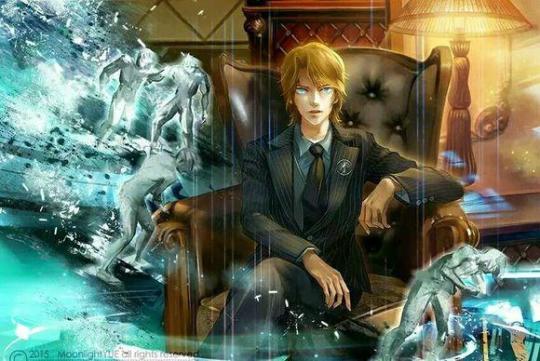
He impressed Beowulf, specially when he ordered to investigate anyone who had come into contact with his uncle, since he recognized his killer. He then brought up Luminous. EVA explained that his unprecedented progress in combat skills was due to his participation in the Nibelungen project. It allows Luminous to surpass the dragon blood limit without turning into a death servitor. He was an artificial emperor, like Chisei Gen from Japan. Beowulf was enraged, since he considered it was a waste of resources to use Nibelungen on such a weak student instead of picking one of their A-Rank fighters and ordered EVA to put all of her computing power in finding Luminous and Finger. However, EVA found no records of Finger in her database. Everyone concluded that he deleted himself.
Since Luminous already worked for the Executive Department and therefore knew how to hide from them, Caesar proposed to employ a different type of hunter, specifically the ancient creatures that the college kept under the ice cellar, originally intended to be used against the black king. The elders voted in favor, but even Beowulf was frightened by the idea of employing them. Flammel suddenly stood up and contacted Finger, warning him of the impeding threat. Moments later, a veteran knocked him down.
Parsi had noticed a change in Caesar. In years prior, he'd make childish requests, like asking him to empty a restaurant because he wanted to drink tea in peace. It looked like he was never going to grow up. Ever since he came back from Japan, he was far more mature, taking bigger responsibilities and doing most of the work by himself. He asked Caesar about his friendship with Luminous, specifically if he wasn't worried about the beasts hurting him.
-I don't want to harm Luminous, but he made a mistake, he shouldn't have involved Nono.
He seemed extremely silent, stopping in his way out to stare at a decorative kimono, one that he brought from Japan as a souvenir, he was wearing it the day he arrived. He wondered about the weaknesses of the dragons, if Constantine was Norton's, who was Shavee's?
He felt like he was forgetting something.
22 notes
·
View notes
Text
Humans are Space Orcs, “Black Tie.”
I hope you guys like this. Writing has been weirdly difficult for me these past few days, so I sort of hope it isn’t showing lol
This is a little peak into the way that humans try to subtly one up each other in social situations, so Karma is fun :)
Krill was mildly uncomfortable, and so was Sunny. They had all been invited to what the humans described as a “black tie” event on mars mostly for political delegations, rich sponsors, a couple of famous people, and the occasional member of the UNSC or the GA. Most of the GA reps were Rundi since they tended to like this political sort of thing. There was at least one Tesraki, who had made the executive decision to come since he saw financial opportunity in getting to know some rich humans.
Sunny had been invited to stand in for the Drev counselor, who could not attend due to some issues back on Anum. Dr Krill and Dr. Katie had been invited to attend the event in case medical personnel were required for any reason.
Adam was the only one who had been invited for himself.
The black tie event had been sent by way of a physical letter which Adam had called, “Excessively pretentious.” in a day and age where everything was sent electronically. The fact they had managed to get a letter to him out in the middle of space in the first place was pretty impressive.
Sunny hadn’t really known or cared what all of this meant, but Adam had been nervous and very serious about the dress code. Despite thinking the entire thing was pretentious, that didn't stop him from immediately sending away for his mother’s help.
Sunny was, of course, encouraged to wear ceremonial formal armor to the event.
Krill was keeping very close track of this odd human behavior constantly asking questions as Adam was preparing himself.
“Why don’t you just wear a regular suit?”
“Because that would be a social faux pas.”
“A what?”
He sighed, “I don't know, it's french or something. I think it’s a ballet term. IT just means it would be a social screw up and people would totally judge me for it.”
“They would judge you for wearing the wrong thing?” Krill wondered curiously.
Adam nodded, “That is the point of these parties, and has been for the last two and a half thousand years. These parties are honestly just the biggest pissing contests where people try to out dress each other in subtle ways, and the old people who know what they are doing make fun of the new people for having no idea how to do it properly.”
Krill looked interested, “how fascinating. So it is a way to show your status subtly.”
“Oh yes. Status is a big deal. It started to go out of style for a while, but this whole adherence to dress code has come back with a vengeance in the last few years. The fashion world has seen an upheaval in pretentiousness, and celebrities have been laughed out of parties for trying to be avant-garde.”
“To be what?”
“Sorry, pretty sure that’s also french too. It means new, interesting, or out of the ordinary usually to make a statement.”
Sunny leaned in a little, “And they expect an air force commander to know how to properly dress for black tie?”
“They don’t, which is why they invited me. I am supposed to make others look good by looking bad. Of course I also make them look good by being invited in the first place. Of course joke's on them because i have a secret weapon on my side…” He patted the front of his shirt, “Thank you mother.”
“I am now confused.”
Adam waved a hand, “Yeah, I know, It’s pretty stupid
“I thought you recently decided that you like dressing up.” The human turned in place a couple of times in front of the mirror trying to get a better view of himself, “Correction, I have always enjoyed dressing up -- got that from my mom -- what I don’t enjoy is the pissing contest that comes along with it.
“What is that?”
“Bow tie.”
“You look like someone’s Christmas present.”
He adjusted the bow tie, “Well than someone is getting a sexy as fuck Christmas present now aren’t they.”
He buttoned up the front of the ‘waistcoat’ and pulled on the jacket.
When he was done, the two aliens had to admit that he really did stand out, all in black black pants black tuxedo jacket, cuff links, black tie, black waistcoat, and a purple/blue carnation threaded through the buttonhole on the lapel.
His shoes were almost as reflective as the mirror behind him.
“How do I look?”
“Like a goofy idiot, but the suit wasn’t going to change that.” He lifted a finger to flip Sunny off.
“Not very dapper of you.” Katie said from the doorway.
They looked up to see Katie, who had also commissioned a dress from Martha, and honestly made Adam look a little plain.
“Ready to go.”
“As I will ever be.”
***
Krill kept a shrewd eye on all the strange human protocols. As far as dressing up went Krill could immediately see who the in-crowd included. Ost of those people understood the rules Adam had laid out for him wearing the proper evening attire, where those not in the-in wore clothing that approximated the rules but missed them on several occasions.
The way the evening was set up was a little bit more like a ‘ball’ as Adam described being announced as they were walked in, and then ordered to mingle with the crowd. Adam and Katie got a few glances from the in-group who seemed surprised that a simple ship captain would known anything about formal evening attire.
Sunny just found the entire thing hilarious. All of this subtle dressing up to impress each other.
If Drev held balls, instead of dancing they would probably just beat each other to death.
But here, there were a lot of subtle clues and hints that went right over her and the Doctor’s heads, while Adam seemed to know what he was doing.
As they walked in waiters offered Adam an alcoholic drink, while Krill received water, and sunny a rather strange tincture that was generally just water with plant flavoring. It was pretty good though so she didn’t complain.
They were met on arriving by the event coordinator whose eyes opened wide when she saw Adam pausing and holding out a hand.
Due to the conflated and rather twisted nature of black tie events in the future, Adam took the hand, and bowed a bit lowering his head, a strange area between the less formal handshake and the more formal kiss on the hand, which was also not a thing in societies post WWIII
“Commander, I… you look…” She trailed off
Even to sunny it was clear the woman hadn’t expected him to know anything.
He smiled icily at her.
Krill leaned in in fascination.
This was one of the most intriguing parts of humanity. The polite way in which they were totally rude to each other, “Well than you. My mother has a Ph.D in the information age and a masters in historical fashion.”
That shut the woman up and she politely dismissed herself walking away straight back.
Adam smirked, “Her dress isn’t the right length for an evening event.”
“I thought she coordinated the event.” Sunny muttered
“She couldn’t coordinate herself out of a paper bag.” He winked at Sunny and Krill, “You can’t out-dress the son of a historical fashion expert. Simply not possible, she even used the correct materials.” He tugged lightly at his jacket.
Dr. Katie had disappeared on entry leaving the three of them to wander about the room as Adam pointed out the other important people.
There were a few military commanders, rundi, and the aforementioned Tesraki. There were at least five major political leaders, and even larger handful of actors who had their hands in charities or political causes related to the event.
Adam was only halfway through his first drink when he was waylaid by one of the younger actors. Even Sunny could tell straight off that he was not dressed appropriately. He had clearly tried very hard, but his efforts were in vain. While everything looked alright from a distance, up close something was wrong about everything. The material of his jacket, the style of his shirt, the type of pants, the lapels on the coat, and even the patterned pocket square which should have been a solid color but wasn’t.
He was joined by another group of men who then began some pretentious conversation about noticing how Adam was new to these sort of events. The way they spoke made it pretty clear they had no idea who he was or what the proper dress code was either.
Adam smiled and didn’t say anything.
“And what do you do for a living?” One of them asked
“Simply a UNSC representative.”
“Ah that explains a lot.” They glanced down at him with pointed looks
The conversation continued. Sunn wondered why Adam didn’t just shut them all up by telling them exactly who he was, but Krill had a theory that Adam was just playing with them as a human way to build up the moment so that he could socially crush them.
As humans do, their conversation wandered until it eventually moved around to the UNSC and other related topics.
One of the men nodded knowingly, “I am somewhat knowledgeable on the subject myself.” Adam raised an eyebrow.
“Are you?”
“Well yes, I have a brother in law who flies shuttles and planes for the UNSC. Tell me, what is your opinion on the D-4 class engine on a F-90 darkfire. I honestly think they are rather overpowered for what is being asked of them.”
Adam frowned, “The darkfire doesn't have a D-4 engine. That is a warp classification which-”
The man raised a hand, “No no. I heard my brother in law talking about it. Personally I think they should have just kept the jet engines they would have been plenty enough power to make it into orbit.
The Commander’s face scrunched in confusion as he shook his head, “No, it's a fusion engine, and the jet engine can’t fly in the upper atmosphere because there is no lift-”
“Look, Adam, was that your name. I generally tend to know what I am talking about. The darkfire jet engines would have plenty of power to make it into atmosphere,”
“But its a jet engine which implies it is for a plane and not for a rocket-”
The guy cut him off again and continued to ramble onward about how he took some engineering classes in college and would know what he was talking about. Since Adam Joined the UNSC and didn’t go to college, that he probably didn’t know anything at all, or at least that is what they said in not so many words.
Sunny was getting a bit annoyed and would like to have squished the guy, but Adam just shook his head at her.
She stayed silent and grumpy as the other men continued to correct Adam on knowledge of his own favorite aircraft.
“My brother owns a spaceship with a class E warp core one of them boasted.”
Adam rolled his eyes, “There is no such thing-”
“My brother owns the craft, I am pretty sure I know what I am talking about. It’s one of the most powerful cores in the galaxy.”
“Um, I don’t think.”
“Yes the E is more powerful than the A. A ship like the Harbinger or the Enterprise would only make it part of the way across the galaxy but the-” He kept going.
Adam looked like he was dying but why didn’t he say anything.
It was just then that someone appeared from the crowd. Sunny recognized a political figure they had met at GA summits on occasion.
He raised his glass and stepped into the group, “Ah commander! I am glad to see you could make it.”
The group of men glanced at each other in confusion.
Adam nodded, “It’s good to see you two counselor.” He motioned to the group we were just having a fascinating discussion on warp engines.”
“Oh yes.” He turned to look at the men, “Than I am sure the commander has told you about his escapades as a darkfire pilot.”
The satisfaction Sunny got from watching their faces was priceless, almost orgasmic. She could tell from the look on Adam’s face that he was feeling similarly, “Well no we had not made it to the subject, “I was just going to explain to them how the duel E 20 engine has both a jet engine and a fusion engine. The jet engine for flying in atmosphere and the Fusion engine for moving out of atmosphere considering that the jet engine is not powerful enough to lift the craft without air buoyancy.”
Sunny was laughing on the inside.
“Ah yes. I seem to recall a discussion along those lines. Tell me commander, what about the Harbinger’s engine is it a class A-1.”
Adam nodded, “Could potentially get you to the other side of the universe if you asked her. The classification system is A-D 1-4 on each, so my ship has one of the most powerful engines mankind has ever bothered to build.”
He glanced out of the corner of his eye and the other men who were beginning to slink away.
Sunny chirped in pleasure.
The rep nodded as they left, “I heard the futility of your conversation from the other side of the room.”
“Thanks for the help. I was dying inside.”
The two men laughed and took their drinks.
Krill was very pleased with his examination on how humans subtly tried to one up each other with their dress and understanding of certain topics, though it seemed odd to him that someone would claim to be an expert when it was, in fact, their brother or brother in law who knew about the subject and not them.
But he supposed that was the social nature of humanity.
506 notes
·
View notes
Note
fashion queen! which nct era has the best fashun in ur opinion?? and if u were a designer which neos would u pick as ur models?
I was so excited to answer this that I wrote several pages and it basically turned into a style analysis for each unit so I sure hope you have some time on your hands to read everything I’ve just written! (I did not reread so sorry for any typing mistake)
NCT is known to be experimental in their music and that’s also the case in their styling so there’s a lot for me to get into even though sometimes it’s a miss. One thing I will say though is that when it comes to the styling in mv/teasers, what’s around the clothes is super important because if you have a very specific styling concept, your set design or graphic design needs to complement that and give the audience more clues on how to read all these elements together (the cherry bomb era is a great example of that with all the added graphic elements and the predominance of the colour pink) and recently I’ve found that the creative team has not really gone further than just putting nct in an outfit in front of a basic background so it makes for a pretty underwhelming result
But let’s move on to my favourite styling eras. I’m going to do this per unit (I’ll finish with NCT U) and define an era by its teaser pictures and the mv (and not go through all the performance looks during the promotion period)
I’m putting this under a read more because it’s reaaally long (I put pictures so that it’s not just one big chunk of text)
NCT 127
Easily the most experimental unit when it comes to fashion, especially in their first years where they would wear mix of sportswear, grunge references, avant-garde fashion and a lot of layers. When it comes to their debut “Firetruck”, I think it fitted the song really well but that it didn’t fit all the members equally (especially the younger ones, for me Taeyong and Taeil pulled it off the best – it’s expected of Taeyong but I also think that Taeil always stand out when they go for edgy/unconventional look, I think it really suits him).
Anyway, just to say that they were off to a very strong start and then I’m just going to kindly ignore the Limitless styling and move on to Cherry Bomb!
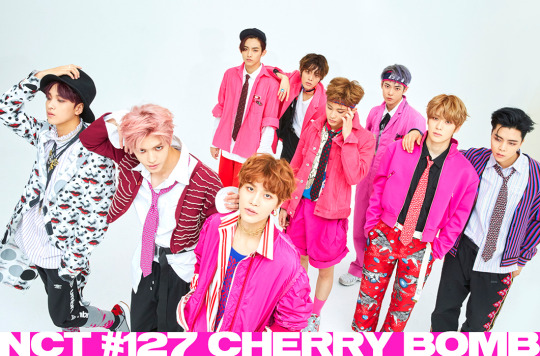
One thing nicely done for CB is how when you look at a group picture they’re clearly all following the same concept but they’re not necessarily matching or giving off the same vibes if you take them individually. I love the use of the colour pink which brings a) a great visual impact (you don’t ever see that much pink at once – especially on men) and b) an harmony despite the shapes and styles of their outfits being so vastly different, you’ve got ties, tousled, shirts, little frilled collars, stripes and all-over prints, sportswear and formal wear… (ex: taeyong’s short jacket is reminiscent of something a little luxurious, even maybe historical/noble with the little added embroidery-like details, it reminds me of these boleros jackets worn by toreros that are often red/gold VS doyoung’s overalls is an outfit that has a much more recent origin as it was first worn by factories workers, it’s usually blue or grey and is meant to be practical rather than pleasing to the eye -> here it fits very well with the general setting of the mv in what looks like an empty industrial storage space)
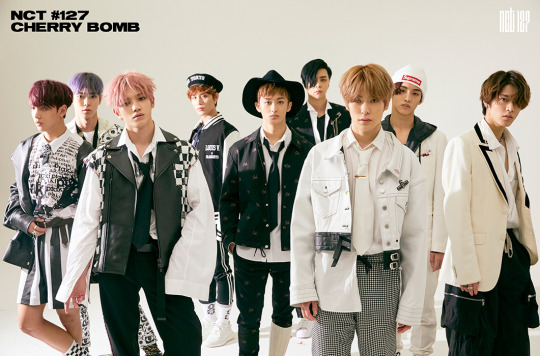
This second look is more of a game on how to deconstruct formal wear (there are less prints and no bold colours, their hair is less messy…) but they don’t just add sportswear like the bomber jacket, you can find rock or more “modern” elements with the leather jackets or the jean jackets. All in black and white so great contrast with the previous looks, although that mix and match concept is still there. My favourite elements are the checkered ones (worn by taeyong, taeil and haechan) as it reminds me of the strategy element of the chess game which fits pretty well with all the weapons and other arms visible in the mv (a bit like a nod to the game battleship)
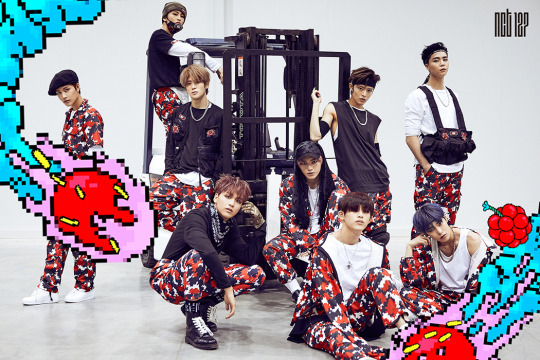
This one I love that they developed their own print, especially since it’s another graphic element used elsewhere (see their album cover), because it’s a great way to really introduce their identity as a group, through the different visual elements they put out in a comeback, it’s like a logo but as a print. And all the teasers and the mv did a great job at mixing 2D/3D contents so that’s another nice way to be cohesive. It’s not my fave look out of the 3 (especially because I do not approve of that belt-suspenders-bag they gave Johnny, it’s like everything you don’t want to put a dancer in and it’s ugly as well) but I still like the fact that’s it’s another nod to the battle/strategy aspect of this comeback, like they’re on a mission to hit the stage and conquer it
Then fast forward to my other favourite one, Simon Says! (No teaser pictures here because they don’t show anything or they show not enough lol)
First of all THE MASKS
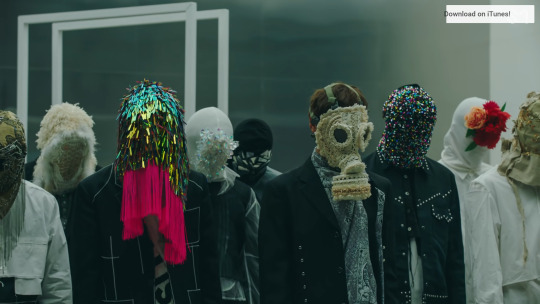
Oh how I wish they could’ve been shown more (imagine teasers with the members wearing them!!! I would’ve loved individual teasers based on each of the masks concepts) Once again, a great to have group concept without making everyone wear the same thing. They’re all super different and full of details. Haechan’s is the only one from what I could who’s mask is actually a mask and not a fully covering hood. The materials and techniques used on these are either evocative of “fragile” things like glass and flowers but theses elements have their own hidden strength. Some others are covered in lace, pearls, fringes or fur…all these things are usually considered to be precious or even luxurious but it covers their faces and their identity and they throw it away in rebellion (and I think it’s also super interesting how Taeyong who takes off his mask first has the least ornamented one)
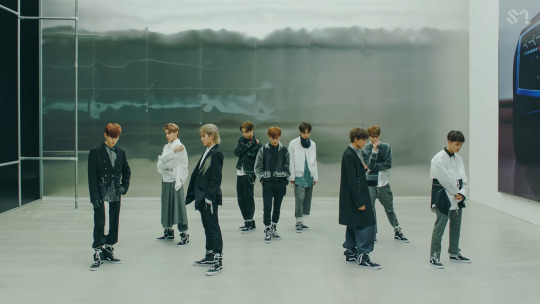
Then the outfits themselves. Simon Says in an interesting MV because unlike most others they wear one outfit for most of the MV (the second one appears quite late in the mv and is lit and staged in a way that makes it less visible). It’s a mostly grey/white set of outfits which is usually a colour combo for office wear or maybe factory workers, it’s not something that can seem very exciting or edgy. The styling in these outfits reminds me of the works of Japanese designers who came to Paris in the 80’s and kind of shook the whole high fashion system by bringing a different type of shapes, aesthetic and purpose to fashion (Rei Kawakubo, Yohji Yamamoto…). These designers went on to become super successful and inspired another wave of “avant-garde” designers nicknamed “the 6 of Anvers” (Anvers is a city in Belgium), this group includes Martin Margiella, Dries Van Noten…And to me the outfits in Simon Says really fit into this aesthetic. Unconventional fits, various layers, it’s not so much mix and match than a work on contrast between structure and fluidity (Yuta’s half skirt with un-trimed edges, Haechan’s long shirt with the long bow and the fitted jacket, Mark’s top with the various see-through layers of different lengths…).
An other interesting details (which to me calls back to the mask and that tension in the song/concept of letting go/being free of expectations), is the way they all have thick strings tied on their feet/ankles. Not holding them back because their feet aren’t tied together but there’s still this clear restriction of the garment itself, a reminder that there are tied to something and not completely free (also an interesting choice when dressing dancers who would need to have no added weight or discomfort in their outfit to dance but visually something is holding their ankles)
Honorable mentions:
Kick It– they managed to create very memorable outfits while taking inspirations from already well known elements (both for the fighting/training outfits and the bomber jackets). The black and white outfits especially are very original as performance outfits/dancing clothes since the og garment they’re inspired by has already such a strong identity outside of the performing arts and I don’t think I’ve ever seen it be used as a stage outfit? Or concept? It’s a nice exemple of how you can take inspiration for something designed to be useful and to be efficient (in fighting) and turn it into an aesthetic.

Truthfully, martial art training outfit was already an “aesthetic” on its own but they made it a performance costume and now I do feel like it’s one of these looks that everyone will remember (like if there was a “most memorable kpop outfits” list it could easily have kick it’s black/white fits). The rest of the outfits for that concept weren’t as memorable/original to me although I feel like it showed a new approach to the styling of nct 127 as a group since they all had very similar outfits this time (especially when wearing the jackets).

Also, interestingly, that shot of Jaehyun that had everyone go “wow” ? Well it’s impactful because it’s him and he looks like that and it’s shot in a very specific way, but it’s also even more impactful because he’s the only one who gets to wear that kind of outfit in the mv. Everyone else has 3 sets of outfits (black and white, shiny black, red jacket and black pants) but he has 4 and that suit is only used in that shot which makes for a greater impact!
And I feel like Kick It in terms of styling opened a new era for NCT 127 has it kind of broke their usual mix and match/edgy concept. This time they were clearly referencing something already well known (either martial arts, the 90s…), and the members were all matching and they kept on doing that with the military jackets in punch, the other 90s concept in nct 2020…
Touch – for the way the outfits match the sets (in all their individual sets their outfits have a detail in a matching colour), the focus on colours !!! You can see that this whole concept was designed with this colour game/colour progression between the outfits and the set in mind. It’s just very pleasing to the eyes and a great contrast to their usual stuffs (also I wrote my graduation paper on colours so I am really into creative use of colours like this)
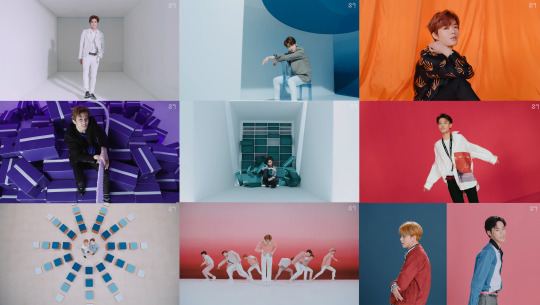
OK now moving on to Dream!!
The interesting thing about Dream compared to NCT 127 is that from the beginning although their outfits had to match the song an the concept of the comeback it also had to match their age. Dream’s a group that had to look young when debuting (to the point where they wore outfits that made them look even younger than they were which is rarely done for boy groups) and then they had to transition into adulthood, and all of that had to be made visible. In that aspect, I really like the styling for We Young and Boom (especially when you look at them at the same time).
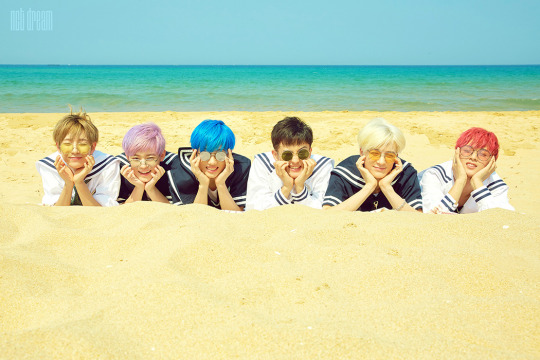
For We Young, the styling is meant to be reminiscent of school/boy scout uniforms but with a marine vibe. It makes for playful outfits that aren’t too childish but that also aren’t grown up. I prefer the “seaside” outfits as I don’t really like school uniforms as a concept for styling and I think it’s really a choice that suited them and the song so well, it really fitted their energy. It’s playful but it also has a vintage touch to it as these outfits with their stripes and their squared flap at the back date back to the XIXth century (I just found out that it all started with the queen Victoria dressing up her kid in an outfit inspired by the royal navy uniforms for a painting after a cruise ).
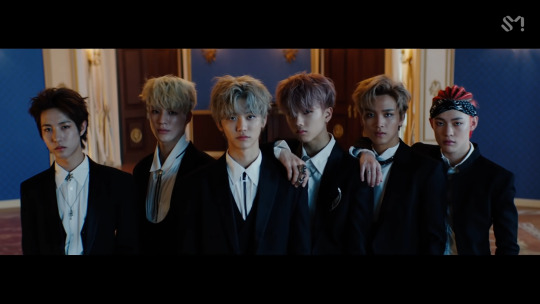
Boom on the other side is their first proper “grown-up” concept. We go up was already more grown up but still very “teenager-ish” and although they were mostly teenagers when they did Boom it was clear that this was supposed to be their first entry into “adulthood” as a group at least. And although they did wear a sportswear/casual outfits which is something that isn’t related to age (and I really like the black and white “skeleton” set which already feels more grown-up and more “stylish” than the other casual outfit) , they wore two other “grown-up” elements: suits and all-jean outfits.
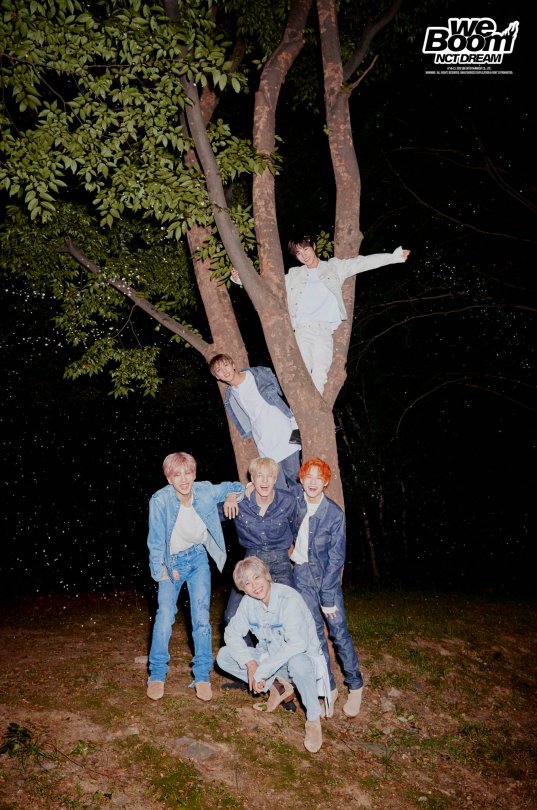
And yeah teenagers, and kids wear jeans too but a full jean-on-jean outfit is more of a “grown-up” fashion choice and it makes them look like young men rather than boys. As for the suits, I just really love when stylists play with the codes of that garment (length of the jacket, tightness of the pants, the way the shirt is tucked in…).
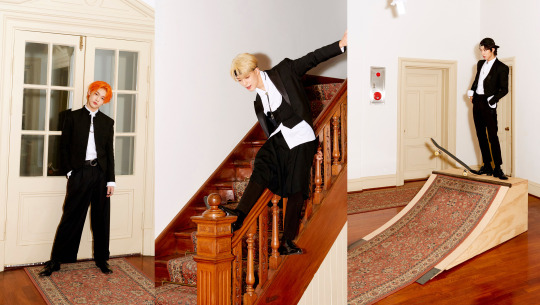
Notice how Renjun has a really short jacket, Chenle’s pants are wide, Jeno has a tail…Once again, a really interesting aspect of Kpop is the variations of the same concept based on the members. In the mv, there is a tension between their more grown up selves (the one in suits, the one with a craft/a path) and their young selves (the one running around in the field, the one laying down in the flowers and eating a cake). And there is also in these outfits and the contrast between them this tension, this contrast…which path should they go? The jeans are the more laide back, innocent outfits, whereas the suits come with responsibilities and status (and you’ll notice that in the scene where jisung is left alone to blow his candle it’s when he’s wearing jeans not when he’s in the suits).
Now on to WayV!!
WayV are different from the two in the sense than when they debuted they couldn’t have an “age” concept or an edgy concept because 127 and dream had already taken those and I feel like for that reason they’re still looking for what makes them stand out visually from the others (and in my opinion it’s not in whatever they were wearing for turn back time!). WayV’s concept is space and time travel, it’s building a new life, a new worl, going beyond anything! In my mind, they’re either supposed to feel a bit “otherworldly” (either spectacular or literally like they’re from another world/another universe, a little bit futuristic maybe?) or to look like explorers/travellers (they have a lot of travel/transportation “gears” references in their outfits). Their MVs also have a very different production than the other nct mvs (the scale and the way it’s filmed, the sets…it’s a different approach and it’s usually much more “grand” for their title tracks). The great thing about WayvV styling is usually that they match the outfits well with the world that the mv is set in (like in Moonwalk for example you get a sense of the world they’re in and the fact that it’s not ours or at least not as we know it now through the way they dress – you can’t really say oh it’s inspired by this era or by this or that because -at least- to me it immediately gives me a vibe of something that could be worn in a sci-fi movie, almost like a costume) or that they allude to travel in their styling.
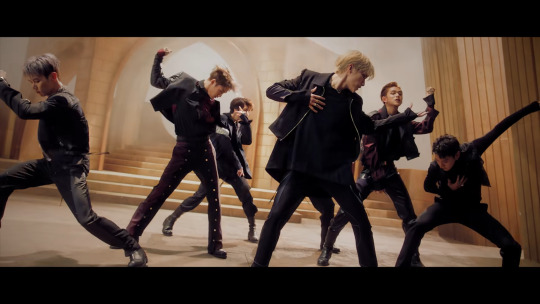
When they debuted with Regular they went for a very sleek and high fashion look which worked really well for them! Even their more “casual” looks were a bit striking and I think that’s very “wayv-like” to me.

Same goes for Take Off where they mix the individual styles (and I don’t like ten’s leopard fur sleeveless jacket at all) and the group concepts – the “flying” outfits and the “racing” outfits (that last one is my favourite! I love the silhouette it creates with the tight pants and the larger tops with an emphasis on the waist).

There’s something a bit extra to WayV - which is why some of their outfits remind me of costumes more than fashion while at the same time they’re the most “high fashion” unit– like the “flying” outfit in Take Off are recognizable as “flying gear” but you can’t really tell what they’re flying, it feels once again like something that they could wear in like star wars or a similar kind of story.
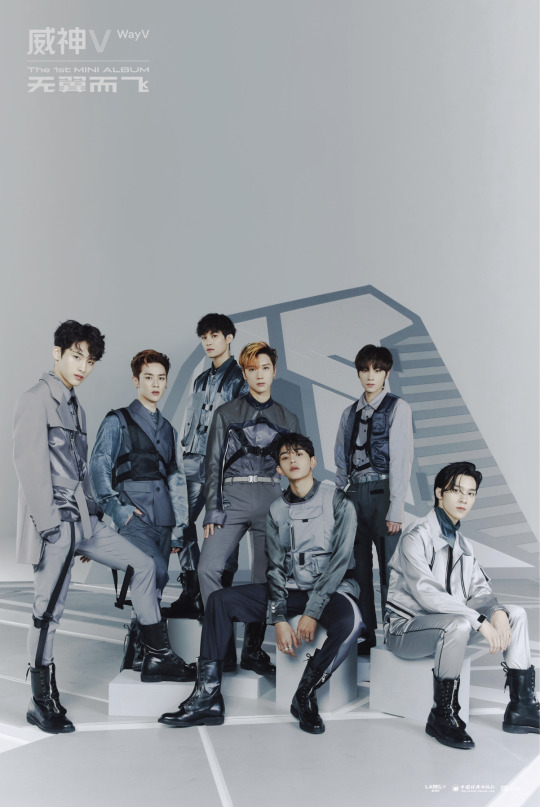
Imagine a movie about 7 men on another planet trying to come together to overcome the dark forces or whatever’s bad on their planet in a futuristic society with a mix of “traditional” and “trendy” outfits? That’s WayV. The movie the 5th Sense? That’s WayV but on steroids. They’re also the only group with actual characters in their mvs, they’re all supposed to have a backstory or an individual setting and find a way to get together in their mvs.
Anyway all that to say that it’s hard for me to pick an era for them because they’ve only had a few and they still feel like they’re looking to solidify their concept, and since moonwalk and turn back time really set the styling in different worlds than ours, you have to look at how they fit in that world rather than ours and I think Moonwalk does it best since it’s the most cohesive one visually. But then I think Regular had the best individual styling!
Okay this is super long but we’re finally getting to NCT U!!!!
Number one favourite:

The Year Party outfits!!!! I’ve already talked about this but I love when they say we’ll put them in suits and then since they have to make a different one for each of them they cut bits an dpieces of the suits here and there, play with lengths. It’s not a revolutionary concept but in terms of searching for a shape, searching for variations of an already so famous, so well-known garment (everyone has seen a suit, and so many designers have already deconstructed it and then put it back together and so on) it’s so nice, it’s almost like a full collection given how many members there are and it’s just a good tailoring work.It almost feel like an exercise of how many variations of an outfit can you think of? And it looks fun to do! It’s all about the details and the way the layers are set together.

The accessories add to the “formal attire” aspect of it. It almost has a ceremonial look to it. A bit of royalty with the futuristic vibe usually associated with WayV. The dark blue suits were pretty classic, the most interesting details (for me at least) were on the light blue ones. Especially since it’s a rare colour to find in formal wear or in ceremonial wear. In general, I feel like it’s a pretty rare colour in fashion outside of like shirts and baby clothes? I think it was a great styling choice for a content like the year party although I do wish they (either NCT or WayV who’ve touched upon this kind of outfit a bit already) would do a full comeback with this kind of styling (like the lighter version of the black and green outfits in SuperM’s One). It’s not revolutionary but it was something new for NCT and I really hope they use that elegant/futuristic concept once again.
Also in these outfits, the jewelry is super important and adds to the “grand” aspect of these outfits. The concept is that these aren’t ordinary outfits for ordinary men, we’re witnessing something “special” and so they aren’t wearing their usual jewels either (of course the big chains are still there but differently look at that necklace jaehyun is wearing)

Honorable mention:
Boss & Baby Don’t Stop (they’re different but they go together in my mind lol). Look at them in their uniforms! And also they had doyoung wearing these sunglasses
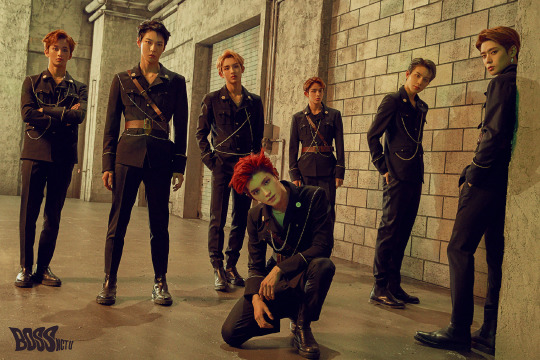
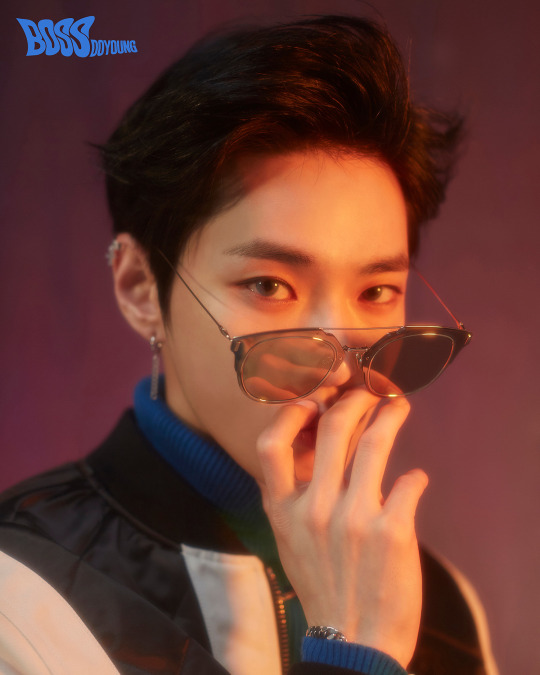

Ok I think I’m done, if you’ve made it this far thank you so much and I hope it was a nice read!!
As for who would I chose as my models…it really depends on what I’d make them wear tbh for menswear the things I’d like to design would either be something like formal wear or knitwear – I’d pick Lucas, Taeyong and Doyoung (I think they’re the most model-like members and could pull off pretty much anything even my non-edgy concept because I can’t do that lol and they pose very well) and then depending on the concept I’d pick between Winwin, Jaehyun, Kun, Jungwoo, Taeil, Haechan and Shotaro (the way I struggled to remember all the members at once…there are too many really)
#this is soooo long omg I didn't know I had that much to say wow#I hope you've managed to read it all and that it was somewhat coherent and clear#now it's time to eat#nct#nct 127#nct dream#wayv#nct 2020#fashion#leemarx#I've got mail#vinformation
34 notes
·
View notes
Text
The Eye of the World: Prologue
Alright, time to start diving into this series! Fair warning: I was an English major, and WILL be analyzing as I go. But as far as I’m concerned, analyzing is half the fun of fandom :)
As for the prologue...There is SO MUCH HERE! The it gives the feeling of coming in at the end of a long, epic story, but one that doesn't have a happy ending. There were numerous references to things that feel like they might be important and potentially come up again: saidin, True Source, One Power, Shai'tan, possibly Hundred Companions, Servants, Sisters, and we will obviously be returning to the concept of the wheel of time.
Reading this definitely gave gave me a feeling I often get when starting a novel, especially a fantasy novel: wait, what's going on now? It's the feeling of trying to piece things together, and having no idea what the author is talking about, but since this is the prologue, it's not really a place to expect a bunch of explanations. The best course of actions is always to just go with it, and assume anything important will be clarified as I get farther into the story.
That doesn't mean I don't sometimes turn into a 5 year old, whining "but I want to knooooooow!"
Aside from the details I want to know more about, a few things stood out to me:
1: The writing itself is interesting, being fairly stylized and feeling somewhat archaic, but without coming across as confusing or awkward. I think it's going to take me a bit to connect with and really get into, but it probably won't be that long before it gets so far into my head that I start talking like that. Despite the stylized language taking some getting used to, I can already tell that it's really GOOD writing: the way the twisted "Healing" the Betrayer used on Dragon set up the comparison for Dragon's reaction to his wife's death, the way Betrayer took an involuntary step back from Dragon's gaze and everything that tells us about their historical dynamic, I can tell Robert Jordan really put a lot of thought into everything he put in, and the care he put into the details.
2: The prologue really sets up the scale that the series is going to be taking place in: they were talking about things going from the beginning of time to the end of time.
3: Betrayer of Hope is SUCH a great name for a villain; I love it. The guy also seems super petty in terms of the grudge he has against poor Dragon.
4: Considering Betrayer talked about how they had been battling since the beginning of time, it seems like we're going to be seeing them (or at least their influence) again. So I'm trying to figure out as much as I can about them. Betrayer seems cruel and petty, both fairly stand for bad guys. What interests me is his thought process. When informing Dragon about what actually happened to his (Dragon's) wife, instead of making a bold declaration to tell Dragon, he instead asked a series of questions, with statements that address those questions in a round about way. I'm wondering if this is because Dragon wouldn't believe him, or if it's because it would be crueler to make Dragon remember. I suspect a bit of both.
As for Dragon, he was given an achingly vivid depiction of what a broken man looks like. He gives the impression of being a good man, who tried to do something good and it backfired in a rather spectacular fashion. Along with being a leader amongst his people, he seems like he was a loving husband, and likely a loving father. This whole thing with him really feels like a case of the road to hell being paved with good intentions.
5: I'm wondering to what degree names and/or identity will be themes in the story (series?) It seemed like names were highlighted several times.
6: It's not often you get a twist the the PROLOGUE! I did not anticipate that the guy would turn into a freaking MOUNTAIN!
7: "...the mountain and the island stood alone. Waiting." Waiting for what?!
Over all, this was a really interesting way to start the book: an ending left unresolved. It manages to feel like we are both going to start a new story, and continue the old one.
39 notes
·
View notes
Text
The 02 epilogue and “realism”
While the following thoughts have been something I’ve been thinking about for a very long time, the official Kizuna Twitter posted some interesting tweets this morning about the 02 epilogue that made me feel very much like I wanted to talk about this in detail today, so I’ve written this up. Considering how historically controversial the 02 epilogue is (or having an opinion on the 02 epilogue at all, really), I’m probably standing on thin ice by even talking about it, but I’ll do my best.
I think there’s no way getting around the fact that the 02 epilogue was really sudden for pretty much everyone -- it pretty much jumps at you without warning at the end of episode 50, a sudden 25-year timeskip when we had just gotten out of Oikawa’s death (and a very chaotic finale in general). But there is another quirk about the epilogue, which is that a lot of what seems “illogical” out of it...is most certainly illogical to someone approaching it as a kid thinking in terms of media tropes, but gains a very different nuance when you become an adult and have a certain degree of life experience under your belt.
(Note: This post does not discuss Kizuna, despite being inspired by something from it, so no fear of spoilers.)
Before we begin for real, I just want to get it out of the way that I’m not trying to “defend” the epilogue in the sense of implying that people are unreasonable for being blindsided. Like I said, it was sudden, and it was a giant timeskip where a ton of incredibly massive changes happened, leaving the audience likely to be disoriented wondering what on earth happened in the middle there to lead up to that. On top of that, although the rest of this meta is basically dedicated to “analyzing the meaning behind the epilogue writing choices from the production perspective”, I will be very honest in that, yes, I do think that, regardless of good intent, it may not have been the best decision to go ahead and make these decisions in this degree of lack of thought as to how the audience (especially one that was expected to be largely comprised of children) would take it -- creativity is a two-way street, after all, and communicating with your audience and understanding how your work will come off is very important.
Still, nevertheless, I’m writing this meta because I think, well...now that we’re all adults, and now that we’ve gotten a plethora of development information over the past twenty years, especially in the light of Kizuna, it’s worth doing an analysis about why these kinds of writing choices were made, because even to this day you get a lot of people who feel completely blindsided about it.
Everyone’s careers
Actually, the reason I decided to make this post was that I was inspired a bit by this morning’s post from the Kizuna Twitter discussing why, despite being a lead-up to the 02 epilogue, some of the cast in Kizuna seems to be in careers or aspirations that are slightly off from the careers we saw them in during the actual epilogue. (Most notably, Sora still working in ikebana instead of fashion design, Mimi being into online shopping instead of her future cooking show, etc.) The official statement was that Seki Hiromi (producer for the original Adventure and 02) personally stepped in and warned them that, in real life, a lot of people will end up changing their career aspirations at this age, and that it wouldn’t hit close to home if everyone had it exactly figured out by this point.
Kizuna is a movie about the Sad Millennial Adult Experience, so of course it is very important that it be relatable to adults in the modern era. But, in all honesty, this principle applies to 02′s epilogue itself as well. Back when the epilogue first aired -- and for the last twenty years, really -- you got a lot of comments like “why didn’t Taichi become a professional soccer player? why didn’t Yamato go into music?” and such. The thing is, though...well, this is a personal anecdote, but I first got into Digimon when I was a preteen, and, having already had an experience where my childhood interests had changed completely, I actually severely disliked seeing people say that because it felt too straightforward. Even that early, that kind of thing felt unrelatable.
Kizuna as a movie, right now, would be impossible to make in the form it is now if it hadn’t been for the 02 epilogue setting that kind of precedent -- because of the idea of your childhood hobbies not feeling as appealing as they used to be and being very lost about what to do now, feeling that everyone lied to you about that whole “having things figured out by adulthood” thing, and maybe you’ll never really figure it out. But even taking out the fact that the 02 epilogue most likely wasn’t written with the idea they’d need to make an adult-relatable movie 20 real-life years later, I think it’s easy to glean that this philosophy was behind the 02 epilogue as well. Especially since, well...Adventure and 02 themselves were both famous for this kind of writing, for depicting the lives of children in surprisingly realistic and close-to-home ways that avoided generic anime tropes.
Actually, Kakudou said it straight-out:
There were a lot of anime normally made with the idea that a given rule must occur, but I decided to do them while having doubts about whether or not it was a good idea to take on such given rules without any detail. Even if we went on with these given rules, I tried to take appropriate steps in showing why such things had occurred through step-by-step arrangements and reasoning. That is why I tried to add a little bit of realness each time to the characters, despite the restrictions that they are from anime.
So yes, that actually was the point -- no using anime tropes unless they felt they could feasibly happen with these characters. Daisuke is commented on as having “the most anime-like” and idealistic personality, but as I commented in my earlier 02 meta, he still doesn’t quite hit all of the check marks on the shounen hero archetype. So after going for a whole series on the line of going into a grounded take on human mentalities and thought processes...it probably would be inappropriate to suddenly shift into an extremely idealized fictional trope-ish depiction of everyone just going into a more exaggerated version of their childhood hobbies.
Again, that doesn’t mean that some of these don’t come off as really sudden -- the most infamous being Yamato becoming an astronaut. This was eventually revealed in 2003 and several times later to be a holdover from the original beta concept for a third Adventure series, so in that light it makes a little more sense -- Yamato probably would be the most passionate about keeping up the fight as a Chosen -- but nevertheless, it’s ambiguous whether that actually still holds (especially since the actual, uh, “third series” was...a bit different), and since we live in a world where that hypothetical Digimon in Space series never happened, it still blindsides the viewer.
On the other hand, though, both the tri. stage play and the official Kizuna profiles only took less than a paragraph to explain the disparity of why Yamato isn’t doing music anymore: he wanted to keep it in the range of hobbies. Which, incidentally, is an extremely common thing for many who experiment with creative work in their youth -- many realize that if they make it into their job, they’ll actually start hating it. Conversely, while I haven’t talked to a lot of astronauts myself, I really do sometimes wonder how many of them actually knew they were going to get into it from childhood.
So that’s the thing. We have no idea what happened, we’re left with very little recourse as to bridging the gap (at least, until Kizuna came 20 years later and helped us out a bit), and that’s why it feels implausible to many -- especially for a kid in the audience who may not have had that experience of having their hobbies change or feel less appealing. In the end, like I said, I’m not sure that going about it this way was the best decision when the very target audience was likely to be confused about this, and since, after all, fiction does have to have some acceptable breaks from reality for the sake of being a followable story. But at the very least, it is very much in line with Adventure and 02′s philosophy towards writing and its characters -- that things would be the case based on what would be these characters’ likely trajectory as actual people, and not as what you might expect “because it’s fiction” or “because they’re this kind of character”.
That everyone has a Digimon partner
I have a very distinct memory of, as a preteen, going around the Internet and seeing a fansite where someone made their “better version” of the epilogue, where their favorite ships got married instead and everyone got the careers they thought they should have, but one major thing that stuck out was that it had the now-adult kids still keep the existence of Digimon a secret, and that it’s kind of a “secret club” that they still have. In general, one of the biggest arguments against the “everyone has a Digimon partner” thing is that this, allegedly, diminishes how “special” the Chosen are when they’re not the super-amazing sole people in the world to have a partner.
When you’re a kid, being the “Chosen One” sounds romantic. You’re a special selected hero with fated abilities to save the world. In the context of Adventure and 02, however, this would actually be very contradictory to the constant reminders given by both series that magical powers selecting you out of nowhere means absolutely nothing if you’re not the one with personal will and volition to do the right thing with what you’re given. In fact, I’d say it’s actually the opposite of what all of those people have said -- if you did something amazing because of fate or because some higher power said you should, it says a lot less about you than if you were given abilities and choices and actively made an attempt to do something good and change the world, by your own volition.
But the other very important thing about the epilogue is that people keep seeing this development of Digimon proliferating all over the world like it was completely out-of-nowhere, to the point I’ve even seen conspiracy theories that the epilogue was a last-minute decision. This is especially funny because the epilogue was one of the first things decided in the entire series -- “the entire series” in this case being not 02, but Adventure -- before they’d even finalized the characterizations for everyone! The 02 epilogue was, infamously, intended to be Adventure’s ending, before 02 was greenlighted and they postponed the plan there resulting in 02 ultimately taking the fall for it.
Because it was a new television series, without an original novel or manga to use as its reference, we had to cut back on the aspect of explaining the character to each voice actor, something that we would usually do under normal circumstances. We only described their basic personality during auditions because it was likely that those personalities would change drastically in the future depending on the plot’s developments. We did not omit the explanations because there were too many characters. I swear.
But in exchange, we began post-recording by saying just this: “This story is one that’s being reminisced on by one of the children in the group who becomes a novelist 28 years later. The narrator here is that child as an adult.” Those who watched the last episode of the continuation series “Digimon Adventure 02” would know that this was Takeru, but back then, that information was kept secret. At the time of the show, it was planned that the last episode of “Digimon Adventure” would end with ‘where are the characters now’ 28 years later. However, in mid-run, production for its sequel “02” was decided and its story contents were established to be juxtaposed to the previous show, so we carried over the 28 years later scene to the sequel series instead.
(From the afterword from Adventure novel #3, from director Kakudou Hiroyuki.)
25 years after 02. 28 years after Adventure. We calculated that very precisely. In 1999, there was Taichi’s group of eight, and there were also eight other people who didn’t appear in Adventure. Before that there were only eight total, and before that only four, and before that only two, and at the beginning, only one. If they were to double every year, then it would be 28 years until everyone in the world would be able to live alongside a Digimon. Threaded through both Adventure and 02 is a story about humanity’s evolution. For everyone to have their own Digimon partner is the final step of evolution. Because there’s not much left for our actual bodies to change in terms of evolution, it is a story about how the hidden parts of our souls use the powers of digital technology to manifest in the real world, resulting in humanity’s evolution.
Statement from Kakudou Hiroyuki, from the Digimon Series Memorial Book.)
About Digimon 10: The initial trigger for humanity receiving partner Digimon was the Hikarigaoka incident in 1996, but at the time the Internet network was not ready and it was too early for anything to happen. The following years resulted in two and then four people getting involved, and after that it doubled every year (twice, because digital and binary). About Digimon 11: Twenty years later, in the world depicted in the final episode of 02, all human beings have received a partner Digimon. This is the ultimate result of Digimon Adventure’s story of evolution.
Statement from Kakudou Hiroyuki, originating from Twitter and later moved to his blog.)
While the 02 epilogue taking place in the year it did sounds like it’s because they just wanted to add an arbitrary neat number of “25 years later” to 02′s finale, in actuality, the original goal was not for that 25 years but to specifically hit the year of 2028 (not 2027, actually), where, calculating the number of humans that could be partnered to a Digimon based on the global population, everyone would have a partner by exactly 2028. The “doubling every year” principle was only brought up in actual anime-centric canon in a drama CD, and even then it was in a context of speculation instead of being stated as hard fact, but it should be noted that even Kizuna is compliant with this principle, since To Sora states directly that the number of Chosen Children as of 2010 is over 30,000, which is the approximate correct amount you should be expecting by 2010 under this principle. (So yes, really, despite ostensibly not being compliant with his original concept, presumably thanks to the nail added by partnership dissolution and how that ties into his theory of Digimon being part of the soul, Kizuna actually goes out of its way to otherwise be compliant with even the more obscure parts of his lore.)
But the really interesting thing that this epilogue concept brings out is that “the adventure of the Tokyo Chosen Children” actually had nothing to do with the proliferation of Chosen Children around the world whatsoever. From the very beginning, even since the original conception of Adventure, the proliferation of Digimon was something that was going to happen whether anyone liked it or not.
In fact, let’s look at what Koushirou actually says in the aforementioned drama CD:
Yes. I’ve figured it out… The meaning behind the term “Chosen Child.” The number of “Chosen Children” has been growing at a steady rate. Having a partner Digimon isn’t really that special. Being a “Chosen Child” means… to cease the hostilities that break out and inconvenience the Digital World. In order to do so, that child gains a partner Digimon faster than another. In other words, we are children chosen to fight. That’s what it means, isn’t it? ... Oh, is that so? That’s surprising. I didn’t expect that not even you would know what countries the Chosen Children come from when they go to the Digital World… It’s Qinglongmon that’s helping you, is it, Gennai-san? Do the other Holy Beasts who have revived not know either? The Digital World is still so full of mysteries. I’ll do my best to look for them over here.
I think a lot of people tend to have misconceptions about the nature of a Chosen Child, and those who picked them, because the way everyone became “chosen ones” is actually very different from how most media usually would play the trope. In particular:
Homeostasis, the Agents, and the Holy Beasts are explicitly not gods nor omniscient. Homeostasis admits their own lack of abilities in Adventure episode 45, and there’s a recurring undercurrent of the “I don’t know” coming from them and the Agents not actually being because they’re deliberately cryptic, but because they really don’t know. In fact, the Digital World itself is depicted as being about as confused about this whole human contact thing as the human world is.
Note that Koushirou makes a distinction between “being a Chosen Child” and “having a Digimon partner”. If you’re deemed someone who might be able to do something important in this very early time when the Digital World is still trying to figure all of this stuff out, in a world where humans overall still don’t understand Digimon very well, you get first dibs because you’re someone who can be a valuable pioneer. In other words, just because everyone else will eventually get a partner doesn’t mean your contributions aren’t still historical, valuable, and important.
The Digital World was mentioned in Adventure episode 19 as being approximately as big in scale as the real-world Earth itself. That means the Digital World is huge. Of course, its time and space doesn’t exactly match up with the real world’s, as demonstrated multiple times in 02 when the kids abuse it to circumvent travel distance, but nevertheless, there is presumably a lot of the Digital World that neither the Adventure nor the 02 kids have seen in their lives. When they meet Qinglongmon in 02 episode 37, he introduces himself as being in charge of the Eastern side -- and we never meet the others. In effect, there’s probably a huge area of the Digital World that needs protecting that even twelve kids from Tokyo can’t cover by themselves. And that answers the question of what the international Chosen Children are there for -- what do you think they’re doing with those Digivices, twiddling their thumbs? The Tokyo Chosen’s adventures were the ones we were blessed with being able to bear witness to, but that absolutely does not exclude the idea that there were other kids going through their own tales of growth and adventure -- especially since, as I said, Homeostasis and the others protecting the Digital World are not omniscient, and there are a lot of known factors beyond their control.
On that note, you might notice that, by the doubling-every-year principle and by running a math calculation, in 1999, there were eight other Chosen Children besides Taichi’s group. This also tracks with the fact that Adventure episode 53 revealed that there were other Chosen Children prior to Taichi et al. who performed an incomplete seal on Apocalymon, ones that even Gennai wasn’t aware of (remember how I said that the Agents aren’t actually omniscient?). While the fact that such an ostensibly huge fact was dropped so casually is jarring for the viewer, in retrospect, the fact that this was dropped so casually was indicative of the idea of how...not very much of a big deal this was supposed to be. Taichi and his friends may have been instrumental in the selection process for Chosen Children back in 1995, but they weren’t the only ones who witnessed the Hikarigaoka incident nor to have contact with Digimon, and they weren’t even the first to save the Digital World, nor will they be the last. But the journey of personal growth they took was still important to themselves -- just because they weren’t the only ones who took it didn’t change the fact that such an important thing happened, nor that we got the benefit of being able to meet and resonate with these kids.
In fact, the Hikarigaoka incident wasn’t even the first point of contact with the Digital World. 02 episode 33 hinted very heavily that what humans have perceived as youkai and other spirits were actually Digital World contact, just not something actually noticeable until digital technology started connecting the worlds. Episode 47 revealed that Oikawa Yukio and Hida Hiroki had made contact sometime in the 80s via video games -- even though they weren’t Chosen Children themselves at the time. In short, the concept of the Digital World and its contact with the human one is something that spans throughout history, of which the Tokyo Chosen Children are only part of in very recent years.
And finally, one of the most important parts: the idea that the Digimon would stay a secret to the world for very long is inherently infeasible. The 1999 “Digimon in the sky” incident was international. It made international news. Everyone in Tokyo has clear memories of the “Odaiba fog” incident, and, as revealed in 02 episode 14, even a boy from America, Michael, has clear memory of seeing a Gorimon. Reporters like Ishida Hiroaki didn’t hesitate to get in on the scene and try to cover what was going on, and 02 episode 38 revealed that Takaishi Natsuko was doing intensive enough press coverage on the Digimon incidents that Oikawa actually sought her out for information on it. They’re probably not the only reporters around the world doing the same. One episode later, Gennai revealed that the government/military and scientific worlds had actually caught onto the existence of Digimon and did make active attempts to research it -- but, fearing that the world wasn’t quite ready to do that without exploiting Digimon for evil purposes, Gennai and the other Agents wiped out any data records so that they couldn’t do organized research or swap notes. But just wiping out data doesn’t wipe out the public memory, and, especially when the number of Chosen Children is proliferating, and with all of the Digimon-related disasters that happened around the world in 02 episodes 40-42, at some point the world is going to start becoming very aware of what’s going on with this whole thing.
And finally, about that thing where a lot of people claim that a world where everyone has a Digimon partner must be some kind of dystopia: I think this camp severely underestimates how adaptable the world is.
This is something that might not be as resonant to those who were very young at the time they aired, but Adventure and 02 were written in what was a very shocking and scary world for adults that were living at the time. The rate at which the world changed and adapted to digital technology in the late 80s and all of the 90s was ridiculous, and in some ways even terrifying. Many tech people have pointed out how much it feels like the entire structure of the world has changed in light of technological developments, AI, and the Internet in only the last few decades compared to centuries before. International policy has changed, daily life has changed, business structures have changed, in time much less than 25 years. Hell, I’m writing this post smack in the middle of the COVID-19 pandemic; I think anyone reading this right now at this time can attest to how terrifyingly quickly the world changed itself in only a few months in response to such a thing.
Compared to that, a whole 25 years of slow burn where the Digimon partner rate at least had the decency to double every year and give people a chance to acclimate and make public policy seems practically luxurious. On top of that, while there will certainly be more people like the Kaiser out there abusing their power, Digimon evolution at least happens to be tied to human emotions (unlike many other weapons out there), and there is some stifling factor in less-than-pleasant people being a bit less likely to have the same access to overwhelming power as those who are more selfless and virtuous. That kind of limiter is something I wish modern technology could have sometimes.
So what is the Tokyo Chosen Children’s place in this narrative? At the forefront of such incredibly massive incoming changes were children who were living in a completely different world than that familiar to even people who were born five to ten years earlier -- much like the real children born in the world of technology in the late 90s. The Tokyo Chosen Children were some of the earliest pioneers in this regard, being the ones who had to figure out logistics and Digimon and the Digital World and what it meant to be a partner in a world that hadn’t figured any of this out yet, and arguably wasn’t ready yet.
Yet they did, and they saved both worlds with no precedent nor support on what to do. This, I think, is a massively more meaningful accomplishment than the idea that they were exclusively selected by some higher power.
On romance and marriage
I feel like this topic is one I’m setting myself up to end up with my head on a pike by daring to breach it -- there is pretty much no way I can cover this without setting myself up for some risk of this -- but I do want to talk about it. I really don’t want to make this post into a pro- or anti-shipping discourse post, so you’ll have to forgive me as I try to be about as diplomatic about this as I possibly can. For all it’s worth, I’m a firm believer in shipping and shipping headcanons being an integral part of the fan’s experience (heck, anyone who knows me knows that I often talk about my own ships more than I really should), and so, as I said before, I’m writing this largely from the perspective of elucidating “the most likely reason it was written this way”, and not “should it have been written this way” nor “how I think people should feel in spite of this”.
In any case, I’m going to start off this section by a statement from a friend that left a particular impression on me. I’d introduced them to Digimon recently, with both of us as adults, and one thing they commented was that the idea of shipping any of the characters felt a little too odd, because they were all elementary school kids. They, of course, understood quite naturally that I had been shipping some of these kids since I was their age (and that my current round of shipping usually was more about whether they’d get together later than whether they would during the time of the series), so it wasn’t an accusation of me being creepy or anything -- it’s just that, as an adult coming into this for the first time without a lot of preconceived attachments, it felt too weird for them to ship children at that young of an age, and it was something that made me think a lot about it.
As I said, shipping is often an integral part of the fan’s experience, even for those who don’t do “fandom” -- romance is such a huge priority that it permeates all of our media, and how it’s handled is often one of the first things deeply scrutinized. Part of the reason the 02 epilogue is so controversial is that it went pretty much against the face of the most popular ships in the fanbase, and the two that did go forward (Yamato/Sora and Ken/Miyako) weren’t ones that people would conventionally expect given what you’d generally look for when it comes to fictional relationship development.
But that’s kind of the issue here: remember when I pointed out earlier that Adventure and 02 were trying to stay away from anime tropes unless they found it to be particularly relevant to the characters’ arcs? In actuality, the way that people generally expect romance and romance tropes to happen in a series -- especially a not-particularly-romance-centric series like this one -- isn’t how romance generally works, and especially not for kids at the age we saw them in Adventure and 02. It doesn’t seem like coincidence that the first hard show of romance we get (Sora asking Yamato out during Christmas) is when the relevant characters were 14, which is around the earliest age you can imagine two kids actually taking a relationship seriously and having some depth of what they’re getting into. As if to drive this in further, Daisuke’s crush on Hikari is portrayed as a sign of him acting shallow and not having a good sense of priorities at the moment; the whole 02 main cast, as of 02, is probably still too young to entertain anything serious for at least a few more years.
If you look at actual couples, as romantic as “childhood friends to lovers” is as a trope, it’s actually not very common in real life, especially for “childhood” being defined as 8-12. There might be a slightly higher chance when it comes to the Tokyo Chosen Children, considering they’d gone through some shared experiences others might not understand, but even that gets slightly mitigated by the fact that more and more people around the world are becoming Chosen themselves. So while it can happen, and while it’s probably somewhat more likely for this group in particular, it’s not as likely as the average shipper would probably want it to be. Even those who support the canon ships don’t really favor the idea of them being in a continuous relationship all the way up to adulthood -- my personal experience as someone closely following Ken/Miyako fanfiction and comics in both the West and in Japan indicates a common thread of it being treated as a mutual pining ship until several years later, and the Yamato/Sora fans I’ve personally talked to have a very high rate of feeling that the two of them have experienced at least one breakup before getting back together. Or, in short, even people who like those ships have a hard time imagining a unbroken, continuous relationship all the way from elementary/middle school to adulthood, because of how much that generally doesn’t happen.
I promise I am not writing this as a treatise against the ship itself, I swear I’m just using this because it’s the best example I can pull out at the moment, but I’ll put it this way: I think the clearest example of this is Takeru and Hikari, the only pairing that has the unfortunate distinction of being explicitly confirmed as not being married (by Seki Hiromi in V-Jump), whereas everyone outside the scope of Yamato/Sora and Ken/Miyako is still technically in “believe whatever you want” territory. Takeru/Hikari is, depending on which scale of ranking you use, a ship that consistently ranks as one of the three most popular Digimon ships globally, and them not getting together is cited as one of the most common things disliked about the epilogue. But despite its overwhelming popularity to the point you’d think it’d be easy to cater to such a humongous fanbase by pairing them together -- and so few people would dispute it, really! -- not only were they not made an item, but they were explicitly confirmed as not being one.
Why?
Takeru and Hikari probably feel “baited” to anyone who’s looking at this from a romantic trope perspective. They’re constantly in each other’s company to the point where it almost feels like they like hanging out with each other more than they do others. Takeru is shown as having a particular investment in Hikari’s welfare in 02 episodes like 7, 13, and 31. They’re constantly associated with each other in promotional materials, too. But when you look at them in terms of their actual relationship as children...well, I’ll put it this way with another personal anecdote: I actually had multiple platonic friends like that back when I was their age in elementary and later middle school, and, uh...well, people did actually ask if we were in love with each other, and it genuinely, no-strings-attached, annoyed the hell out of me, because we weren’t, and I hated being pigeonholed into that.
In real life, platonic relationships happen a lot with kids in that age group, and it’s not actually all that surprising that 02 would have wanted to portray a healthy one without any strings attached -- the same way the series also portrayed other unconventional situations with kids, such as Iori being a nine-year-old who hangs out with kids much older than him (there are most certainly kids who can attest to being in that position!). I mentioned in my earlier 02 characterization meta that both Takeru and Hikari are actually rather inscrutable (especially in the first half of the series), and in fact, episode 13, usually quoted as a Takeru/Hikari episode, is actually centered around Takeru having difficulty reaching out to Hikari because, despite the fact he was closest to her at that point in time, she still was too closed-in to open up about anything. They almost never talk about what they actually think about each other, other than obviously having an investment in each other’s welfare and enjoying each other’s company, but, again -- this isn’t unusual for platonic friends at this age. And the fact that this is the one ship where there was actual official word putting a foot down and saying, no, this did not end up in marriage...everyone interprets this like it’s some kind of callous move made to make people miserable for no good reason, but I would say that, given the writing philosophy applied to the kids in nearly every other respect, the intent was likely to make a statement that this kind of relationship can exist without it ending up in inevitable marriage somewhere down the line.
We’re inclined to see “two people being emotionally close means a higher chance of being a couple” because this is how romance has been portrayed in media for as long as any of us have been consuming media, but in actuality, relationships are very multifaceted and complicated, and there are many ways to be “emotionally close” to someone in ways that don’t overlap with being “romantically attracted” to someone. This is especially once you start becoming an adult and end up needing to navigate the web of who’s a friend and whom you might have a crush on, and in actuality the person you start flirting with because you think they’re attractive might have been someone you just met last week, or at least someone you don’t know very emotionally intimately (which is why crushes can be intimidating, even in adulthood). This is also what I think fuels the disparity between why Taichi/Sora gained such a huge following and what actually happened with them, because many, many fans will testify that they felt baited by the ship, but if you look in the actual series in terms of what counts as “romantic attraction” and not just emotional closeness, there’s...not a lot; they happened to know each other before the events of the series (but so did Koushirou!), Taichi had a bit of a mental breakdown about saving her (because he’s not someone who abandons important friends), and in Our War Game! they had a bit of a spat with traces of tsundere (which, ultimately, are circumstantial and don’t necessarily indicate they actually have serious mutual feelings for each other). Official word implies that Yamato and Sora were planned since rather early in the series, and it doesn’t seem like coincidence that “pairing up the main hero and heroine” (Taichi and Sora) was given as an example of an avoided trope in an official booklet, so it lends further support to the idea that “not following typical romance tropes and expectations” was a significant priority.
Again, this isn’t me saying anything about those who ship it or those who have been able to figure out ways in which the relationship could work in some very wonderful headcanons I’ve had the benefit of reading over the past decades, nor those who are having a marvelous time with fanfic and headcanon and comics and being a bit more willing to indulge outside the scope of the series’s canon. (Nor the multitude of very good headcanons and meta I’ve seen about the possibility of Takeru/Hikari at least trying out dating somewhere along the line, even if it doesn’t end up anywhere permanent.) Nor does that mean I think that this was the best way for the writers to go about it -- as I’ve said in this meta already, there is an inherent fallacy of not paying enough attention to how writing will be taken and interpreted by people with certain reasonable expectations cultivated from years of media consumption, and especially by kids who aren’t going to pick up that nuance or don’t have the appropriate relationship life experience. Regardless of intent, there’s still a lot that can be criticized about its handling; in many ways, it could be considered a bit cruel that the series had things known to be considered romantic subtext in most other series that may not have been actually intended this way. But, nevertheless, I do feel very strongly that there’s a high likelihood that this is what they were at least going for, even if it didn’t come off that way to most of the audience.
Extrapolating this concept further, it’s also interesting to see how Adventure and 02 treat romance as a relatively insubstantial thing in the grand scope of things. I said earlier that it’s quite understandable that romance and shipping have become the main obsession for media -- and it’s probably been that way for as long as human civilization has even existed -- but when you really think about it, Adventure/02 treat romance as “a thing that is a big part of your life, but not the sole controlling factor”. Again, note how Daisuke’s precocious crush on Hikari manifests when he’s at his most shallow, and even after Yamato and Sora start dating in episode 38, we really don’t hear a lot about it -- granted, neither were in the lead protagonist cast by that point in the series, but whenever they do appear thereafter, it’s almost always about their work helping out as Chosen than it is about their relationship, which is presumably a private thing going on in the background. It’s a part of their lives, but it’s not the only thing going on with them. Of course, shounen anime with casts of these ages don’t tend to breach the topic of romance much at all, but it’s interesting how it touches on the topic and then leaves it in the background -- again, something probably frustrating and a bit too cavalier for those inclined to see shipping and romance as life or death, but from a real-life perspective, makes sense in the realm of friends’ relationships largely not being your business, even if it is significant.
(Ken and Miyako are a trickier matter because their pairing was allegedly based on their voice actors’ friendship, but considering that it has been cited multiple times across multiple Digimon series production notes that character outlines were often subject to change even mid-series based on impressions of the voice actors’ performance -- it happened in Tamers too, and it’s not even unusual for original anime in general -- it’s still ambiguous as to when in production this decision was made, and, considering the flip between Miyako having jealous pettiness over him in episode 3 to fantasizing over him and considering him exactly her type in 8, I would not be surprised if the decision were made somewhere in between there, especially since the fact the epilogue would eventually happen was already established in production over a year prior. Unlike with Yamato and Sora, we don’t get to see the two of them at a reasonable age to start doing anything serious within the scope of 02, which led to the unfortunate result of the reveal of them getting married in the epilogue being a very startling and sudden jump for many.)
In any case, I’m going to close this with yet another disclaimer -- I know I’m repeating myself too many times at this point, but I really, really want to make it clear that I am not, in any way, trying to imply that I don’t understand why people would be blindsided by the epilogue in any of the above ways (careers, the status of Digimon partnerships, shipping) because, as I said, I do think there is some merit to the philosophy that maybe they should have paid a bit more attention to how people -- especially kids -- would actually see the events rather than the writing philosophy behind why it should be written this way. (And, to be honest, I think I might have this complaint behind not just the epilogue, but both Adventure and 02 as a whole, for a multitude of different reasons.) Moreover, there are a million other cans of worms that could be feasibly discussed regarding the epilogue that I’ve only barely scratched the surface of here, because there are so many different topics to unpack when it comes to it, and I could go on forever (and further increase my risk of ending up with my head on a pike...). And of course there’s the wider issue of how to handle timeskip epilogues in general (they don’t really tend to be very popular, do they), so, really, there’s only so much I can cover in one post before dragging this on for too long. But in the end, even after writing all this, I understand that there are a lot of people who still won’t like it or don’t want to accept it, and that’s fine; it’s not my place to try and convince people to.
But, nevertheless, the reason why I made this post -- and what I hope the take-home can be -- is that, no, I don’t think this was made as a random off-their-rocker decision with the intent to make everyone miserable, nor some kind of fever dream that the writing staff must have pulled out while drunk, nor whatever accusations I’ve seen levied about it as a weird spontaneous idea (and the fact it really did come out very suddenly at people), but that -- regardless of how it landed -- there was some idea behind why it played out, and why, even 20 real-life years later, principles like “not everyone’s going to stick with the same career even in adulthood” continue to hold.
70 notes
·
View notes
Text
Okay, I know, I know, it's already old news, everybody and their uncle in the costuming community has already talked it over, but anyhoo, I made notes when I crawled my way through effing Bridgerton and I will be damned if I don't vomit them onto this site. I have 32 pages of this shit, I'm not gonna throw that away.
I'm also typing this on my phone because I'm stuck on a trainride that's just doubled in length because this is the 2021 Northern German snow storm. What, there's snowflakes on the rails? We cannot possibly keep up our schedule, say goodbye to 90% of the connections.
Okay, on to Bridgerton, Episode 1
We're in Britain (oh, London, okay), allegedly 1813. I see people who are clearly meant to be asympatico, but is this size incusivity I spot there? Daring! Gasp! Me li...
Oh wait, no. The character is promptly shamed for her figure (which is mostly caused by the horrible cut of her dress. Every size can look great in Regency garb, but never mind, we need to make the "fat one" look bad!).
Also, no shifts under the stays. Why. There was obviously enough budget, don't tell me you couldn't afford a few strappy tops - it's not like the rest is historically accurate, so it would have sufficed to send some poor underpaid intern to H&M and get some. Nvm, that wouldn't be sexay.
Wait, is the garishly dressed (always a sign of a character of bad character in a costume drama) woman Delphine from Selfridge? Does she always have to play bitches? That's not nice, and just because she has a recognisable face, which by modern (read: americanised) standards is not favourable enough. Ugh. But I like the actress, so I'll let it slide (for now).
Lol, buttocks.
Not sure about the girls' dresses. Also, the Queen is a WOC, cool!
Oh no, one of the Featherington sisters faints! But that's okay because the Featheringtons are just comic relief and foil anyway.
I get weird incest vibes from the Bridgertons.
So the court is clearly 18th century and the show is set in the 1810s. I've by now seen several explanations for this decision, I still think it robs the Queen of reproductions of her actual historical gowns which were heavily inspired by the 18th century but so. Magnificently. Weird. It would have been so neat, and more of a "hey, I'm kinda out of touch with things" vibe, but hey, I'm not the one getting paid for making those taffeta gowns here (her hair is glorious, tho).
I'm very into the intro.
That Regency gossip girl is a real b, not unlike the Dowager Countess of Downton (unpopular opinion, I think she's pretty overrated, yes, I like Maggie Smith).
Again, no shifts.
Where do I know the "pragmatic" Bridgerton sister from? Ah, it's The Paradise. And Jonathan Strange. (Wait, she's my age. And she's supposed to be a teenager. Man, do I love a good Dawson casting. I like the actress, though, she has a face ™!).
Aaaah. We get it. She's the spirited one. She also doesn't care about dresses because she's not like other girls™. I really like her voice (but she still doesn't sound like a teenager).
The heck is up with Lady F's dress and that of her friend? Oh, yeah. Antagonist fashion.
Of course the Featheringtons are Horrid Hags™ aside from Penny who's nice, but the pudgy one (at least we don't get a case of "she's not conventionally attractive so she's bad").
Oooh, the cousin! Supposed to suck, but ofc she's a stunner, and only Penny (who's the nice one, remember!) is delighted to have her around. She's also a POC, which is nice but apparently that means she does not follow fashion, hair-wise. I would have loved to see some Regency hair on her, it would have been so pretty *cries in Greek updo*
Ugh, we're still in Ep. 1, typing this on my phone was a bad idea.
Lady Danbury and the Duke guy are delightful with each other (more POC! So neat!).
The girl the oldest Bridgerbro screws is apparently a singer, which isn't up to status for his doucheship, and she doesn't wear a shift.
The music at the ball sounds like something from the Top 40s, but I'm woefully ignorant of contemporary music charts so I can't tell what it is. I like it when they do that in historical-ish works, making well-known pop or rock stuff work for the ambience (ugh, that dance scene to Golden Years in Knight's Tale. My heart. In a good way.)
I dig the Ducktail hair of Penny's crush. Oh, wait, that's a Bridgerbro. I don't quite get why the hair trends of the time don't apply to the POC characters or extras, but seeing how most white characters also show a shameful disregard for the weirdnes and gloriosity (that's not a word) that is early 1800s hair (the 1830s take the cake, tho) despite those hairdos being basically designed for white people hair, I don't think I care much (well, I do, but about all of them). Overall the hair is horrid and not very 1810s. Let's just leave it at that.
Like a good old romance novel (I've since been told that Bridgerton is supposed to be a pastiche of such novels, but I really couldn't tell from the series, not at all, and I'm not inclined to read the books) we have
a pretty, kind, superpure daughter of the main family
the mean matriarch (could have been an aunt, too, but here she's the mum) of the rivalling or antagonist family
a spirited daughter of the main family (in most romance novels this would be our heroine but so far she refreshingly lacks a love interest and pretty daughter seems to get the most screen time)
a Horrid Suitor™
a Hot Suitor™ who doesn't want attention
a really good and doting good parent
Lol, misheard Greece for Grease with Ducktail Bridgerbro, whose name is Colin, apparently. This is funny because of his Danny Zuko memorial hair.
Overall a bit too much bling for my taste, and too few pearls. It looks like an episode of My Super Sweet Sixteen with a Regency theme.
Of course the romance is going to be the Pretty One aka. Daphne and the Duke and he's even bros with her eldest bro. Wait, are they exes? I can haz bi? No? Aww, shucks. Maybe in another episode (spoiler: no).
Okay, WHAT is it with Lady F's dresses and hair. Like, she reminds me of Mars Attacks. Which, as you might remember, was not set in the Regency period.
Lord B (Bridgerbro the Eldest) sucks, he's screwing Opera Girl without any intention of marrying her but he's bitchy about his sister being ogled by his Eton (or wherever) bestie?
Oh, I'm in Hamburg now. And my train back home got canceled, so back to Berlin it is because there's not a single option to get to Hanover tonight, at least that's what the lady from the train station is saying, "oh well, you'll have to go back and try again tomorrow", so that's awesome...
Honestly, if it weren't so late and I didn't have things to do at home I'd find this terribly exciting.
Back to Bridgerton!
Where were we? Ah.
I can't even read my own annotation. Something about George III. I think I was upset about how they totally ignored that it's called Regency because George IV acted as the regent king, and he doesn't even feature in the series, I guess because they wanted to play up the Queen? Not a fan, because thanks to Horrible Histories I'm quite fond of that guy.
Again, no shifts.
Oh, look, it's Horrid Suitor™, destined for leftovers.
The Featherington cousin gets all the attention but no fleshed-out character.
Penny Featherington's dog is named Lord Byron, which ❤️
I like the Duke! He's there, drinking in his club (even though they're a patriarchal remnant of the past I have a weird appreciation for stuffy Gentlemen's Clubs, I blame Bertie Wooster and the Drones), calling Lord B out for his general fuckery.
Oh no, Ducktail Colin is more into the Cousin than Penny, who obviously pines for him!
Thank you, Lord B, for enabling Horrid Suitor™. Nobody asked you to be such a fucktwit.
The Queen is, of course, a bit of a bitch, but patronage from cool Lady *scrolls up for name* Danbury ensues for Protagonist Girl™ Daphne.
"I wish they had found a better trend language", what the heck did I even mean by that? That's what you get for just scribbling down notes while watching and simultaneously sewing. 18th century pants, in case you wanted to know.
Cousin is angry, probably because Lady F behaves like Cinderella's evil stepmother, because Cousin is prettier than her daughters and gets, like, all the suitors because Lord B bitched away everyone who wanted to get into Daphne's dowry ifyouknowwhatImeanwinkwinknudgenudge, right across the street into Cousins parlour.
The Bridgertons are annoyingly perfect. Ugh.
Oh look, it's "banter" between Daphne and Dukey! It's so Pride & Prejudice! It's almost a tiny bit Shakespeare! I put banter in parentheses because wow, nope, I'm not getting any chemistry here.
Uh, Lady B calls out Lord B (aka. her son aka. Bridgerbro the Eldest) for his screwery with Opera Girl and his outpimpery of his sister to Horrid Suitor™, buuuurrrrrnnn. He promptly calls of his affair with Opera Girl.
No shifts!
Penny gets to dance with Ducktail Colin at the thing! Good for her, but it's a country dance with jumping and fun, because she's a) the pudgy character and b) a Featherington, so it can't be something romantic and pretty (I personally like country dances, but they aren't protagonist dances).
Oooh, Cousin had her period, oh no, oh snap, oh she didn't, because she's PREGNANT! Shit, that's problematic, and not because she's an unmarried woman in the 1810s, but because she gets close to no lines at all so far, and suddenly she's pregnant and telling Lady F that she sucks for being privileged, violence ensues, this is ugly. Man, I get what some critics mean by "the POC actors*actresses get all the problems" and that not exactly being great.
Horrid Suitor™ makes property claims about Daphne, eeewwwww, thanks to Lord B's general suckiness, ewww, r@pe attempt ensues, was that really necessary? It doesn't really fit in with the rest of the series and generally nope, yay, broken nose! (which was indeed totally necessary). Nice one, and probably the only scene so far (spoiler: overall) in which I actually like Daphne. Dukey thinks a mean left hook is attractive, and, generally speaking, he's not wrong.
Daphne and Dukey come up with a pseudo-shakespearean plot to pretend to be totally into each other so she can attract suitors by being not available and he gets not to have fangirls by being not available, and as someone who has read a few too many historical-ish bodice rippers I know exactly where this is going. I mean, come on.
I can't see enough of the following choreography to complain about it. Man, I miss historical dance classes.
And that concludes Ep. 1! Finally! Thank you for getting this far, sorry for all of it (especially typos, it's the bane of unwanted autocorrect), I guess?
Update on the train situation: I've been told by the ticket control person that I shouldn't get my hopes up until noon tomorrow.
To be continued,
because I didn't take these 32 pages of notes for nothing.
#Bridgerton#Hedgewatch#historical costuming#Well not really because wow these costumes#Thank you for travelling with Deutsche Bahn#2021 norther Germany snow storm#Trainwriting#Snarky commentary#I wish I was better at captions but it's late and I've been wearing a mask for four hours straight now and I'm hungry#Bridgerbore
16 notes
·
View notes
Photo
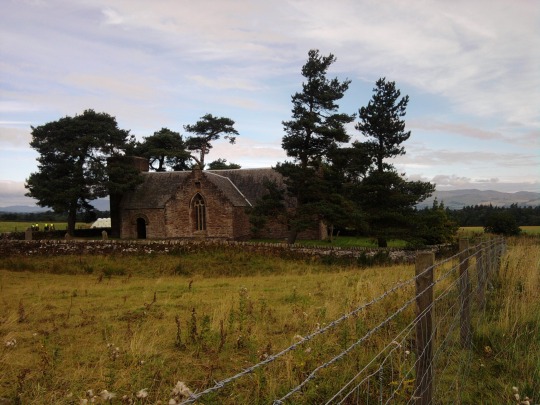
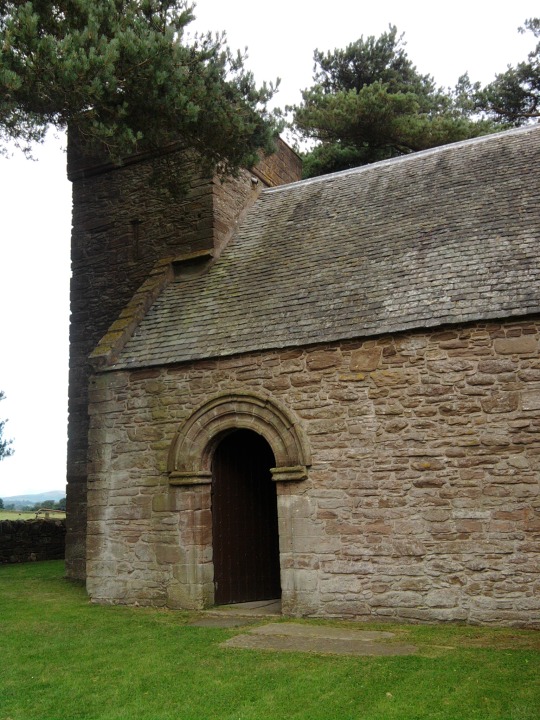

Places to Go: Tullibardine Chapel
A small kirk sheltered by Scots pines, Tullibardine Chapel has an air of tranquility and simple elegance. Formerly the private chapel of the Murrays of Tullibardine, it is one of the few buildings of its kind in Scotland to have survived with many of its medieval details intact.
The Murrays acquired the lands of Tullibardine in the late thirteenth century, when William ‘de Moravia’ married a daughter of the steward of Strathearn. Later, through judicious marriages and court connections, they first became earls of Tullibardine and then Dukes of Atholl. But even as lairds the Murrays were a significant power in late mediaeval Perthshire. In those days Tullibardine Castle was one of their main strongholds, and the close proximity of royal residences like Stirling meant that the Castle also hosted several notable guests. Mary, Queen of Scots, stayed there in December of 1566 (allegedly in the company of the earl of Bothwell). One laird of Tullibardine became Master of Household to the young James VI, while his aunt Annabella Murray, Countess of Mar, oversaw the king’s upbringing. Thus James VI was also a frequent visitor and it was he who created the earldom of Tullibardine in 1606. The king is known to have attended the wedding of the laird of Tullibardine’s daughter Lilias Murray, though it is unclear whether this took place at Tullibardine itself. The castle grounds were probably an impressive sight too: the sixteenth century writer Robert Lindsay of Pitscottie claimed that a group of hawthorns at the “zeit of Tilliebairne”* had been planted in the shape of the Great Michael by some of the wrights who worked on the famous ship.
Thus the tower at Tullibardine, though presumably on a small-scale, was apparently comfortable and imposing enough for the lairds to host royalty and fashion an impressive self-image. But the spiritual needs of a late mediaeval noble family were just as important as their political prestige, and a chapel could both shape the family’s public image and secure their private wellbeing. The current chapel at Tullibardine, which originally stood at a small distance from the castle, was allegedly founded by David Murray in 1446, “in honour of our blessed Saviour”. At least this was the story according to the eighteenth century writer John Spottiswoode, and his assertion is partly supported by the chapel’s internal evidence, though no surviving contemporary document explicitly confirms the tale. A chapel certainly existed by 1455, when a charter in favour of David’s son William Murray of Tullibardine mentions it as an existing structure. In this charter, King James II stated that his “familiar shieldbearer” William Murray has “intended to endow and infeft certain chaplains in the chapel of Tullibardine”. Since the earls of Strathearn had previously endowed a chaplain in the kirk of Muthill, but duties pertaining to the chaplaincy had not been undertaken for some time, James transferred the chaplaincy to Tullibardine. He also granted his patronage and gift of the chaplaincy to William Murray and his heirs.
The charter indicates that Tullibardine Chapel was an important project for the Murrays. Interestingly though, no official references to the chapel in the fifteenth, sixteenth, or seventeenth centuries describe Tullibardine chapel as a collegiate church, even though later writers have frequently claimed this. Collegiate foundations were increasingly popular with the Scottish nobility during the late Middle Ages, but, although such a foundation might have been planned for Tullibardine, there is no evidence that this ever took place.
The 1455 charter serves as an early indication of the chapel’s purpose and significance. Judging by its architecture the current chapel does appear to have been constructed in the mid-fifteenth century. However it was also substantially remodelled and enlarged around 1500, when the western tower was added. One remnant of the original design is the late Gothic ‘uncusped’ loop tracery on the windows. Despite the apparent simplicity of the chapel, features such as this window tracery have been taken as evidence that its builder was acutely aware of contemporary European architectural fashions. Another interesting feature is the survival of the chapel’s original timber collarbeam roof, a rare thing in Scotland. Several coats of arms belonging to members of the Murray family adorn the walls and roof corbels, although some of these armorial panels were probably moved when the chapel was reconstructed. They include the arms of the chapel’s alleged founder David Murray and his wife Margaret Colquhoun, as well as those of his parents, another David Murray and Isabel Stewart. A later member of the family, Andrew Murray, married a lady named Margaret Barclay c.1499, around the same time that the chapel was renovated, and although they were buried elsewhere, their coats of arms can also be seen there. Aside from such details- carved in stone and thus less perishable than books and vestments- the chapel’s interior seems quite sparse and bare today. Originally though the mediaeval building probably housed several richly furnished altars and some of the piscinas (hand-washing stations for priests) can still be seen in the walls. But the sumptuous display favoured in even the smallest mediaeval chapels was soon to be swept away entirely by the Reformation of 1560, when Scotland broke with the Catholic Church and Protestantism became the established faith of the realm.
Tullibardine was used chiefly as a private burial place after the Reformation, but there are signs that the transition from one faith to another was not entirely smooth. Four years after the “official” Reformation, a priest named Sir Patrick Fergy was summoned before the “Superintendent” of Fife, Fothriff, and Strathearn to answer the charge that he had taken it upon himself “to prech and minister the sacramentis wythowtyn lawfull admission, and for drawing of the pepill to the chapel of Tulebarne fra thar parroche kyrk”. Fergy did not obey the summons and so it was decided that he should be summoned for a second admonition. It is not known whether Fergy compeared on that occasion, nor what kind of punishment he might have received for his defiance. We are also in the dark as to the laird of Tullibardine’s views on the situation, even though it was going on right under his family’s nose. Nonetheless the case does provide a glimpse into what must have been a complex religious situation in sixteenth century Perthshire, no less for the ordinary parishioner than for the nobility. It also raises the possibility that private worship continued in the chapel after the Reformation, albeit unofficially.
Even as Tullibardine chapel’s public role diminished, the castle was still of some importance. Royal visits must have been considerably rarer after James VI succeeded to the English throne in 1603, and the Murrays of Tullibardine themselves acquired greater titles and estates, but the tower at Tullibardine still witnessed some notable events. During the first half of the eighteenth century, the castle was the home of Lord George Murray, a kinsman of the Duke of Atholl and famous for his participation in the Jacobite Risings of 1715, 1719, and 1745. During the last of these, Tullibardine Castle played host to a Jacobite garrison and was visited by Charles Edward Stuart. In less warlike times, Lord Murray often resided with his family at Tullibardine, and one of his daughters, who sadly died in infancy, seems to have been buried in the chapel. Lord George himself expressed a wish to be buried there as well but he was forced to flee into exile on the continent after the failure of the ’45, and so his body was interred “over the water” at Medemblick, in the Netherlands.
After Lord George’s exile Tullibardine castle entered a period of slow decline. Much of the fabric of the building was removed in 1747. Some years earlier plans had been made for the old tower to be replaced by a fashionable new house designed by William Adam, but these never materialised. A sketch of the mediaeval chapel made in 1789 shows the castle in the background- a roofless, tumbledown ruin. Tullibardine castle was finally demolished in 1833, and the family chapel, whose very existence had for centuries been defined by its proximity to the laird’s house, now stands alone. We are thus all the more fortunate for its survival, and both its attractive situation and interesting mediaeval features make Tullibardine chapel well worth a visit.
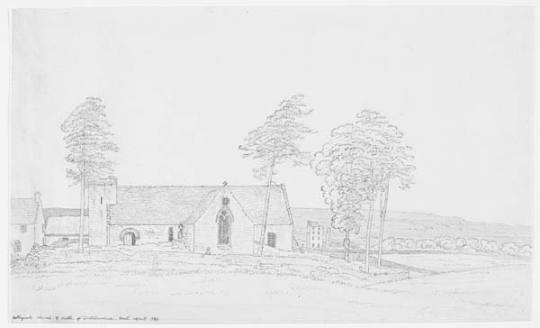
(Tullibardine Chapel, with the castle ruins in the background, as sketched in 1789. Reproduced with permission of the National Libraries of Scotland, under the terms of the Creative Commons Attribution 4.0 License)
Sources and notes may be found under the ‘read more’ button.
* “zeit” is presumaby “yett”, the old Scots word for gate.
Selected Bibliography:
- “Account of All the Religious Houses That Were in Scotland at the Time of the Reformation”, by John Spottiswood, in “An Historical Catalogue of the Scottish Bishops Down to the Year 1688″, by Reverend Robert Keith.
- Seventh Report of the Royal Commission on Historical Manuscripts, Part 2 (Duke of Atholl papers)
- “Register of the Ministers, Elders, and Deacons of the Congregation of St Andrews”, volume 4, Part 1 (St Andrews Kirk Session Register), edited by David Hay Fleming
- “Statement of Significance: Tullibardine Chapel”, Historic Environment Scotland
- “The Historie and Croniclis of Scotland From the Slauchter of King James the First to the Ane Thousande Five Hundreith Thrie Scoir Fiftein Zeir”, by Robert Lindsay of Pitscottie, volume 1 edited Aeneas J. G. Mackay.
- “Late Gothic Architecture in Scotland: Considerations on the Influence of the Low Countries”, by Richard Fawcett in ‘Proceedings of the Society of Antiquaries Scotland’, 112 (1982)
- “Aspects of Timber in Renaissance and Post-Renaissance Scotland: The Case of Stirling Palace”, Thorsten Hanke
- “Register of the Privy Seal of Scotland”, Vol. 5, ed. M. Livingstone
- “The Household and Court of King James VI”, Amy L. Juhala
- “Memoirs of the Affairs of Scotland”, by David Moysie, ed. James Dennistoun for the Bannatyne Club
- “Calendar of State Papers, Scotland”, Volume 10, 1589-93, ed. William K. Boyd and Henry W. Meikle
- “The Indictment of Mary Queen of Scots, as Derived from a Manuscript in the University Library at Cambridge, Hitherto Unpublished”, by George Buchanan, edited by R.H. Mahon
#Scottish history#Scotland#British history#Perthshire#Places to go#Strathearn#Tullibardine Chapel#Tullibardine#Auchterarder#fifteenth century#sixteenth century#eighteenth century#1450s#1500s#building#architecture#Gothic Architecture#kirk and people#religion#Church#Christianity#private chapel#chapel#Murray family#Murrays of Tullibardine#Murray#Duke of Atholl#Jacobites#James VI#Mary Queen of Scots
9 notes
·
View notes
Text
Droopy Sleeves and Tiny Bonnets: Watering Down the Romantic Aesthetic in BBC’s Les Mis
I wasn’t exactly blown away by the costumes in the BBC production of Les Mis, and Cosette’s in particular, cute as Ellie Bamber is, were thoroughly “just okay.” But I didn’t put much more thought into it...
Well, not until Gentleman Jack--set in the exact same time period--blew BBC’s Les Mis out of the water with its costume design. Then more recently, when I started researching the fashion of the early 1830s, all the ways in which poor Cosette’s costumes fell short became glaringly obvious.
Disclaimer: I am not as much of a stickler for historical accuracy in period drama costumes as this little essay is going to make me out as being. I’m not a Frock Flicks kind of gal; I just want to be entertained and look at pretty clothes. So as far as I’m concerned, as long as the basic silhouettes are there and the costumes are nice to look at, I’m there. (I find the wildly inaccurate costumes of The Tudors a lot more visually appealing than the ones in Wolf Hall. And everyone knows Sofia Coppola’s Marie Antoinette was highly stylized, but those costumes are to die for and still embody the rococo aesthetic very well.)
That said, Cosette is a character who’s very invested in fashion, and the general look of the 1830s isn’t unknown to English productions, being the setting of Queen Victoria’s adolescence, Jane Eyre, Wives and Daughters, and many a Dickens adaptation among others.
So where did they go wrong?
Being honest, most of the Les Mis productions from the past two decades or so failed to put Cosette in high-fashion or even noteworthy costumes. Only the 2012 film for all the ways it failed her as a character hit it out of the park. Cosette gowns were damn near perfect--and they were actually pretty to boot! Unfortunately in the actual film you can’t even see the floral gown and you can barely see the blue one...thanks Tom Hooper.

The belts/buckles, the enormous sleeves, the delicate floral prints and embroidery, the lace collars...pat the costume designer on the back! (Her wedding dress was also on-point, but we’ll get to that.)
Claire Danes and Virginie Ledoyen had passable-and-sometimes-good costumes, too. Though Claire Danes’ were generally not very pretty, their overall silhouette was correct. Virginie Ledoyen gets a couple of knock-out, very period-appropriate gowns; the rest sort of fall into the nebulous “well, I guess you tried” category without being unattractive.
But the BBC production just...dropped the ball for reasons unknown.
Now, in the book Cosette overhears some ladies calling her “pretty but badly dressed.” She’s shocked, because she thinks she’s ugly but well-dressed. She then goes on a charming quest to become the best-dressed woman in Paris, and the BBC adaptation even has a scene where she goes to the seamstress. It’s really cute. Too bad that the dresses are...really not.
Here are some fashion plates from 1830-32. Keep in mind that Cosette lives in Paris, of all places; she would be aware of what was and was not fashionable.

This is the height of Romantic fashion: giant (“gigot”) sleeves and bonnets, full skirts with hems at or just above the ankle, lace accents, silk stockings and slippers, elaborate hairdos. The 2012 costumes, again, capture this quite well.
And even if the BBC designer had taken liberties and had fun while preserving the overall aesthetic--think what Sandy Powell did in Cinderella, set in roughly the same period--I wouldn’t be making this post. But there’s curiously little 1830s to be found in Cosette’s wardrobe at all.
I guess we should start with the BBC’s Good/Accurate Stuff. This coat Cosette wears is, apart from the deep fur-lined V-neck, almost a carbon copy of the extant coat on the right. And she has a bonnet!

Cosette’s best/most accurate dress is, naturally, the most difficult to see and has the least screentime of all her costumes:
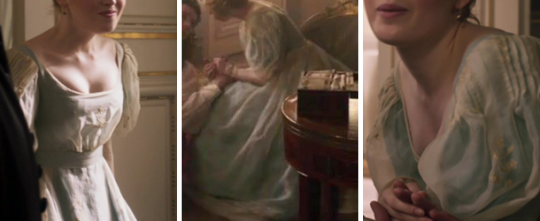
From what I can tell, the sleeves, though delicate and sheer, are very full, as is the skirt, and the whole thing seems both pretty and en vogue...despite the questionable neckline. It’s also detailed--embroidery on the sleeves and with pleats (?) to create visual interest at the shoulders and on the bodice!
Here are a selection of other short-sleeved gowns from the period for comparison (both extant garments and costumes/reconstructions).

Tbh Ellie’s costume should be as stunning as the blue gown (far left) that an extra wore in Cinderella, but...maybe someday, in some Les Mis production, that gorgeous Sandy Powell creation will reappear. *sigh* (Virginie Ledoyen’s best Cosette gown is on the far right, btw.)
Anyway, that’s...that’s about it for the “Good” category.
Next up: her teal/turquoise dress(es). (She also wears a red one that looks exactly like this.)
Someone didn’t tell the costume designer that Cosette was supposed to be a fashionista, I guess. During my research, I did find a couple of dresses that resembled these two...but they would both be several years out of date by the time Cosette was going on her fashion crusade:

Even the yellow dotted dress has more style and “oomph” than what poor Cosette got stuck in--her sleeves look comparatively small, deflated, and underwhelming, all the more so when compared to actual 1830s gigot sleeves.
In the interest of being fair, some extant gowns from the right dates also look somewhat like these two.

But they all look, well...better. They all make me wish Cosette’s gown had bigger sleeves, a more-defined neckline, less wrinkly fabric...anything that would take it up a notch. (Also of note: as plain as some of these dresses look, they would not have been worn alone--accessories like wide belts, shawls, bonnets, etc., would have been part of the outfit when they were actually worn.)
And when it comes down to it, Cosette--who wants, after all, to be wearing the most fashionable gowns, like those in the fashion plates--should be wearing gowns more like...

The detailing, the fabric choices, the tailoring, and (sorry) the size and position of the sleeves makes all the difference here. A little more effort, even just padding for Cosette’s poor limp sleeves and a belt, would be enough to bump her looks from “kind of sad” to “something I believe this character would really wear.”
My personal favorite gown in the production was very pretty, flowing and delicate--and look: I’m willing to accept that Cosette wouldn’t always be wearing a fashion plate while chasing butterflies (something no film Cosette has, tragically, ever done...) That said, it still wasn’t very 1830s.

This purplish gown is the closest extant I could find to something like what Cosette wears here, but once you look at the details of both--fabric, neckline, whatever is happening around waist--all you get is “???” A lovely dress, but one that doesn’t make much sense.
So finally we come to what ought to be the showiest of all Cosette’s costumes: her wedding gown.
This costume ought to be Stunning for a lot of reasons. The “Fauchelevents” have money! The Pontmercys have money, and they have society friends! Cosette is a fashionista, and she’s head-over-heels in sweet young love! And one an assume that Valjean wants to send off the light of his life, if send her off he must, in style--he’s heartbroken but also knows, from this moment, that he will never have to worry about her safety or well-being again.
With all that in mind, this is what Ellie’s Cosette wears...

Oh. Okay. Is it her freaking wedding day, or is she just going to a church picnic???
At least she IS wearing a bonnet in this scene, but it’s the same color as her hair (?!) and it’s tiny...just like her sad, deflated sleeves. The necklime and waistline both are at least accurate here, but like the sleeves, the skirt isn’t voluminous. Not a single thing about the dress makes a statement...unless it’s a shrug. The impression is, once again, “meh?”
At least a veil (which some women did wear on their wedding bonnets) would emphasize the “wedding day” vibe. How about, if they weren’t going to give it any volume, some detail on the gown...any detail...floral embroidery...a BELT...a contrasting color or fabric (lace, hello?!)...anything??? It’s just so plain and low-key. Just like everything Cosette wears in this miniseries.
Here are some period wedding gowns, two of which Cosette wears in other adaptations. They all have the wow factor this dress lacks.

Big sleeves! Lace! Belts! Veils! Lush fabric! Frills! Different colors/fabrics to create visual interest! Hairstyles that pop instead of blend together! These are the kind of gowns that say “I’m the bride and this is my day.” Not “I’m going to the church picnic.”
I want to reiterate that, after ALL that rambling...my big issues are that a) these dresses are not--by and large--attractive or interesting and b) that they fail to embody Cosette’s love of fashion. The fact that they’re so inaccurate for the time period is secondary. However, paying more attention to the fashions of 1830-32 would, I think, have helped make the costumes prettier and more suited to the character. How you dress a character is also a factor in how their character is perceived and can be a subtle means of character development. No chance of that here. (Post-marriage, Cosette wears such a blase dark blue coat that, sans fur trim, looks identical to her previous one. Yawn.)
I’m just a fan, yet it still took me only three days of basic research to put this post together. Expecting a costume designer to put in at least a few days of light research is not a huge leap. I’m going to venture a guess and say that this designer did not bother to do that. And it shows.
It’s a shame, because Cosette gets a lot more screentime here--for the first time since the 2000 production--and she deserves so much more than shapeless gowns and barely-styled hair.
And also more than Andrew Davies...but that’s a rant for another time.
56 notes
·
View notes